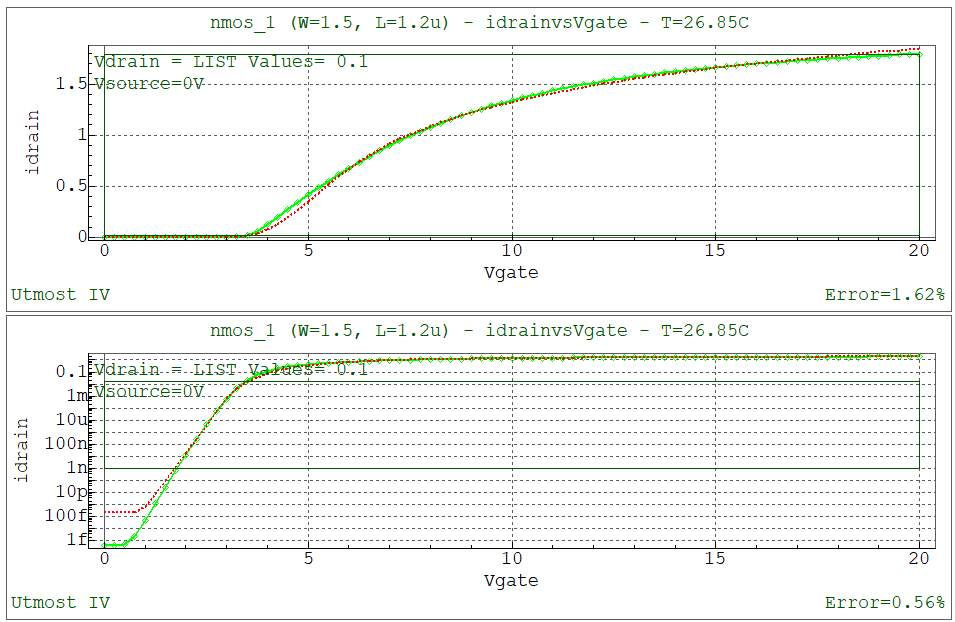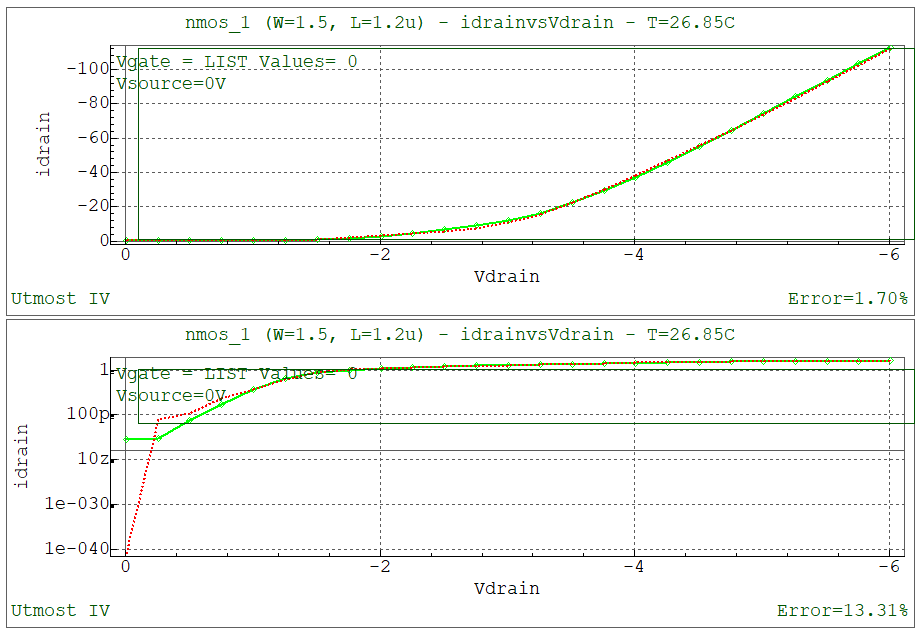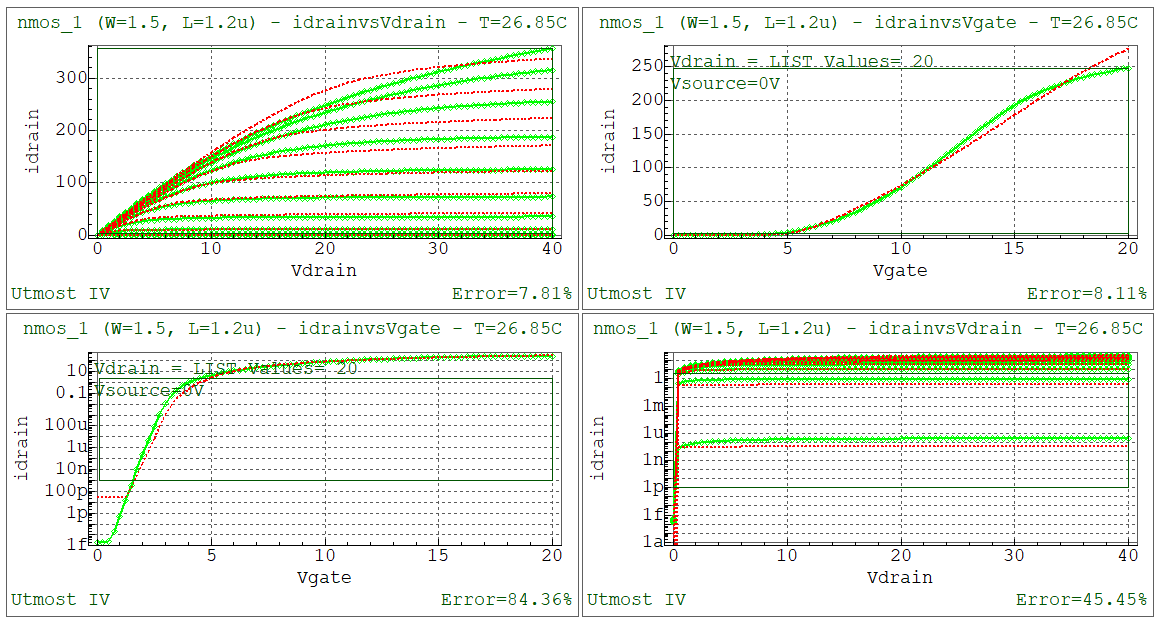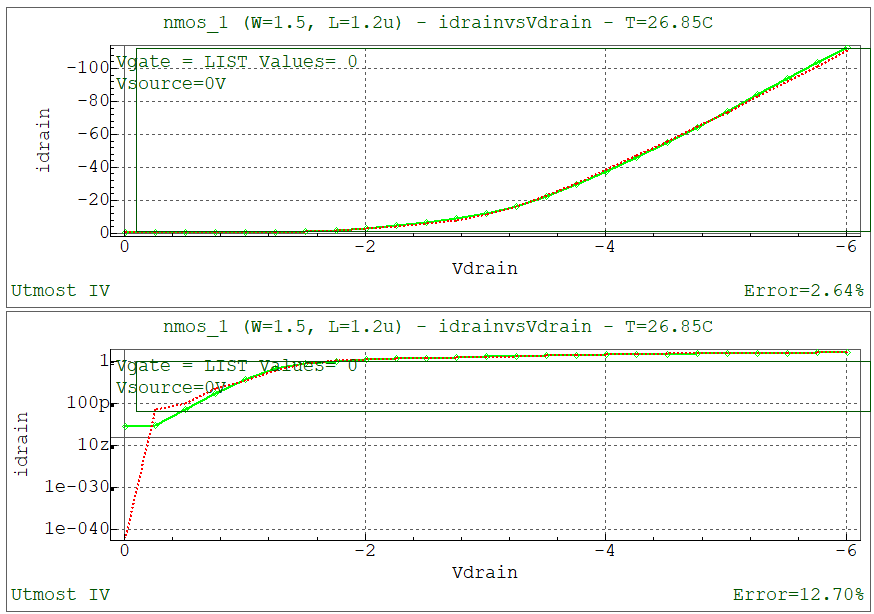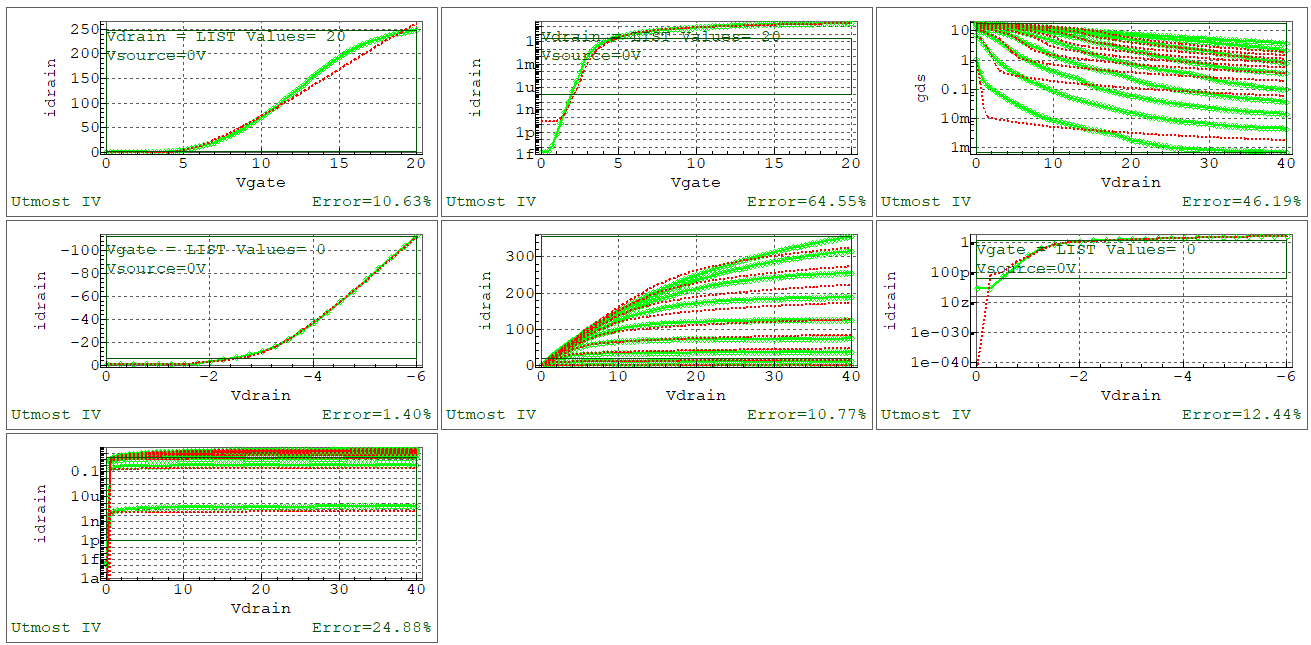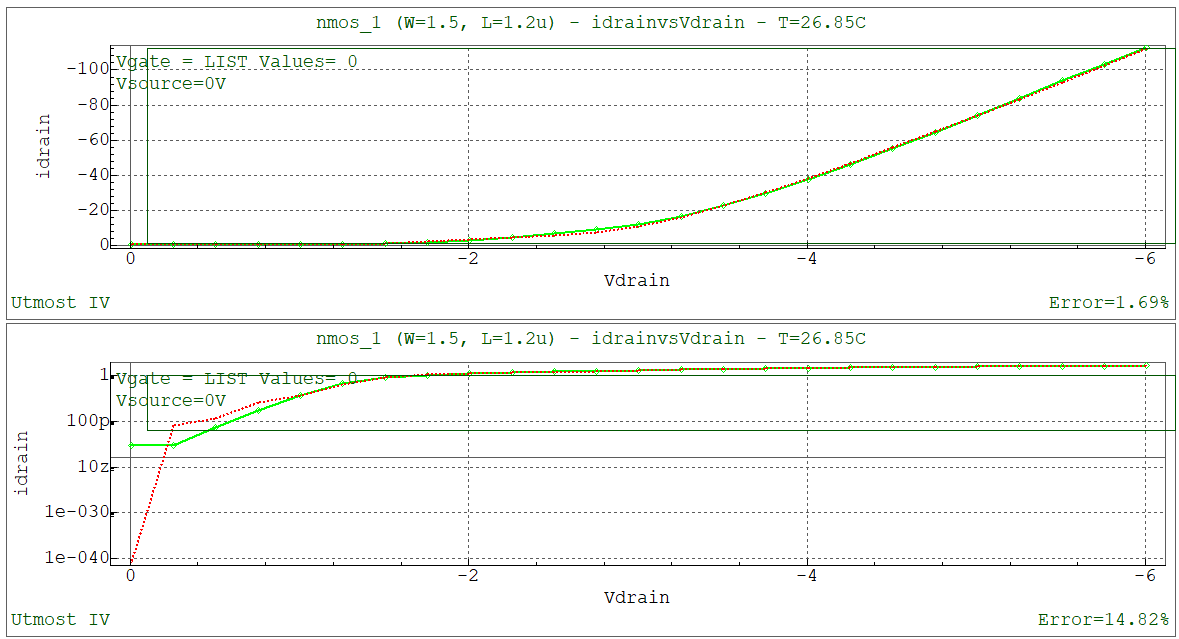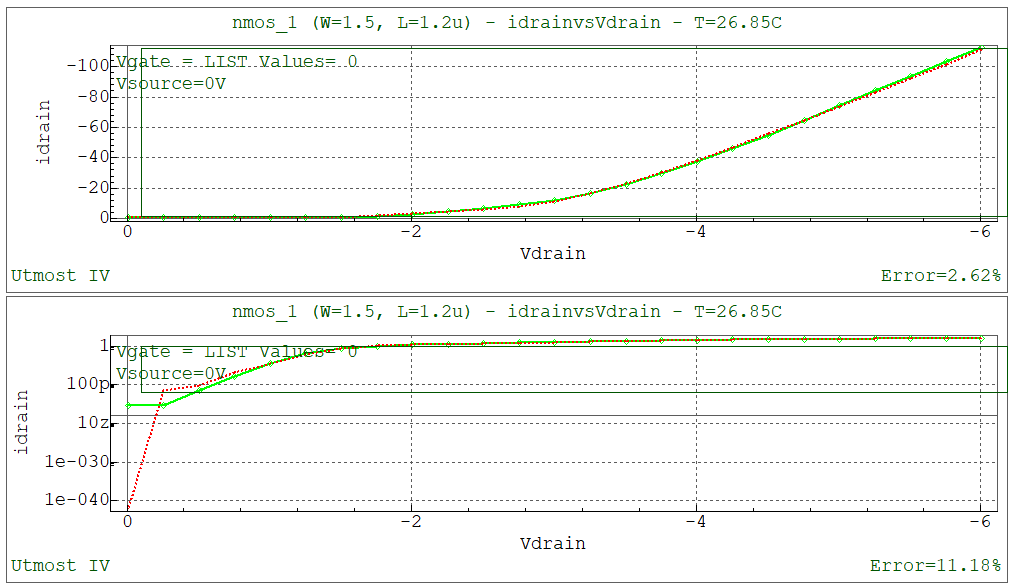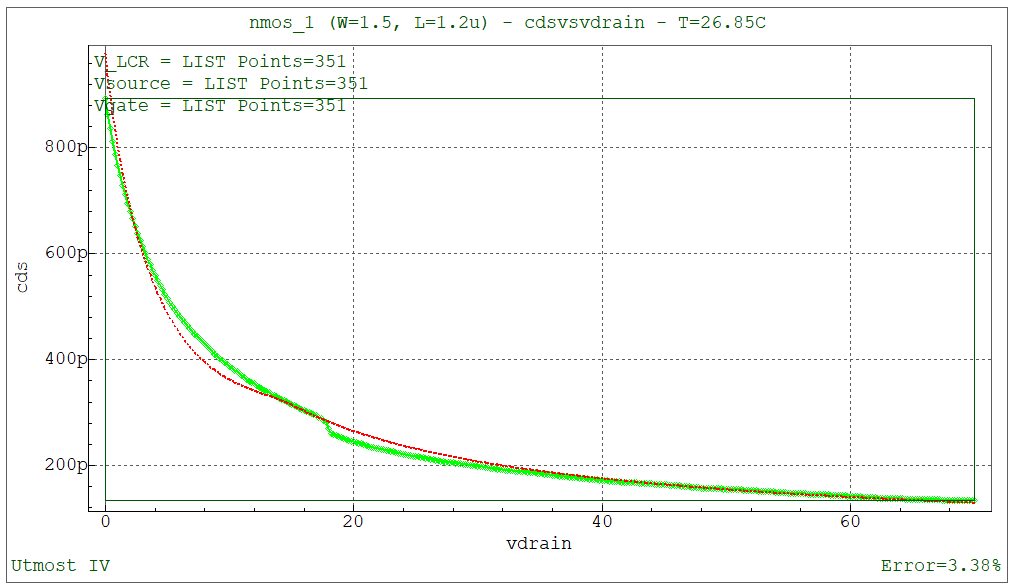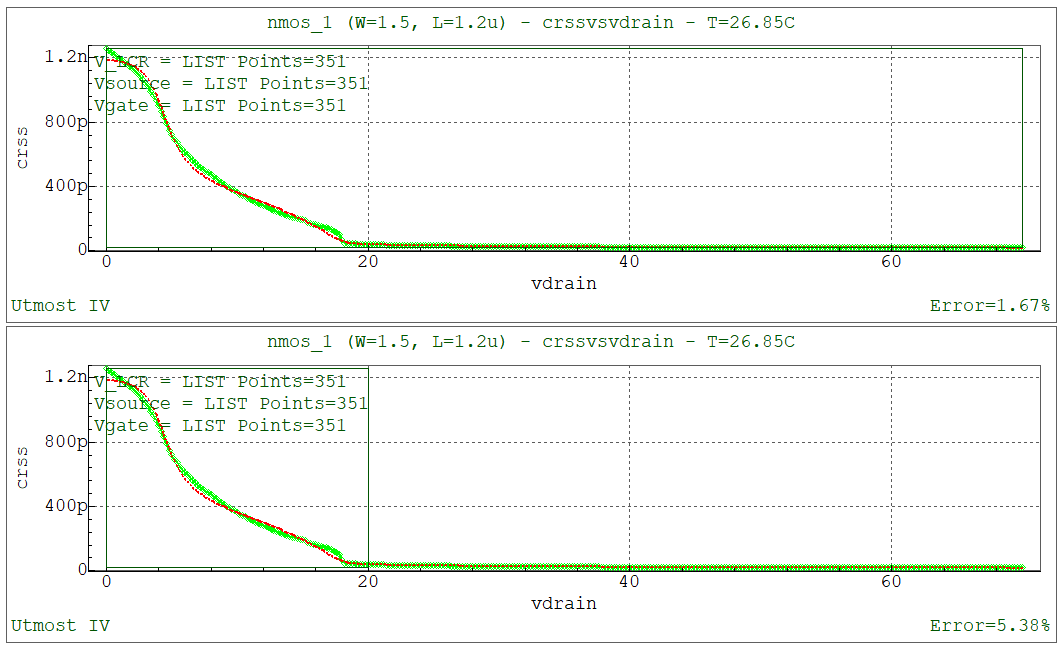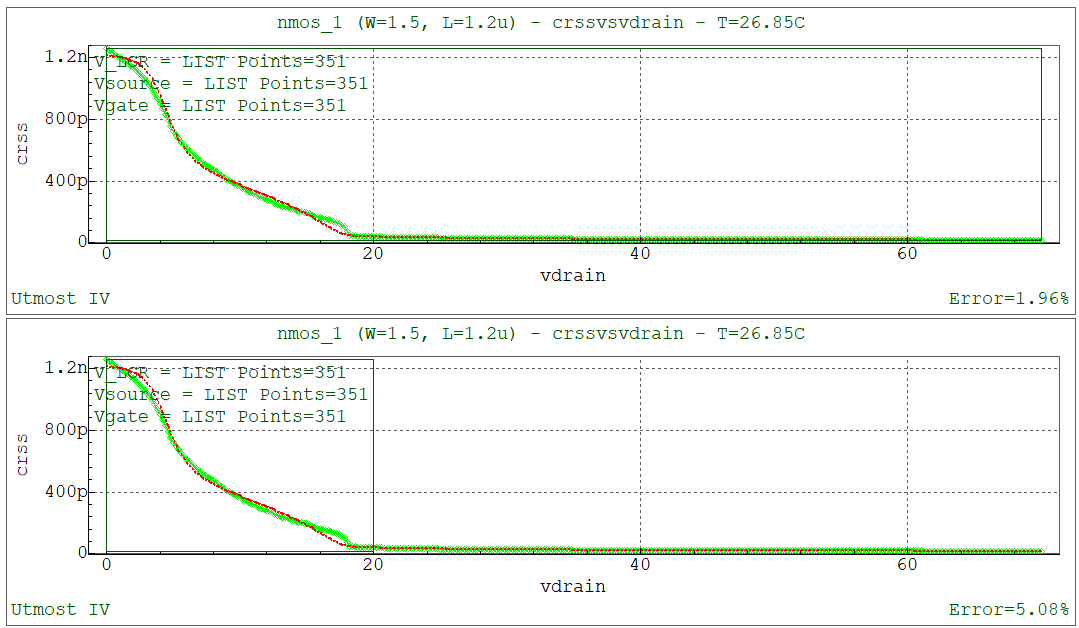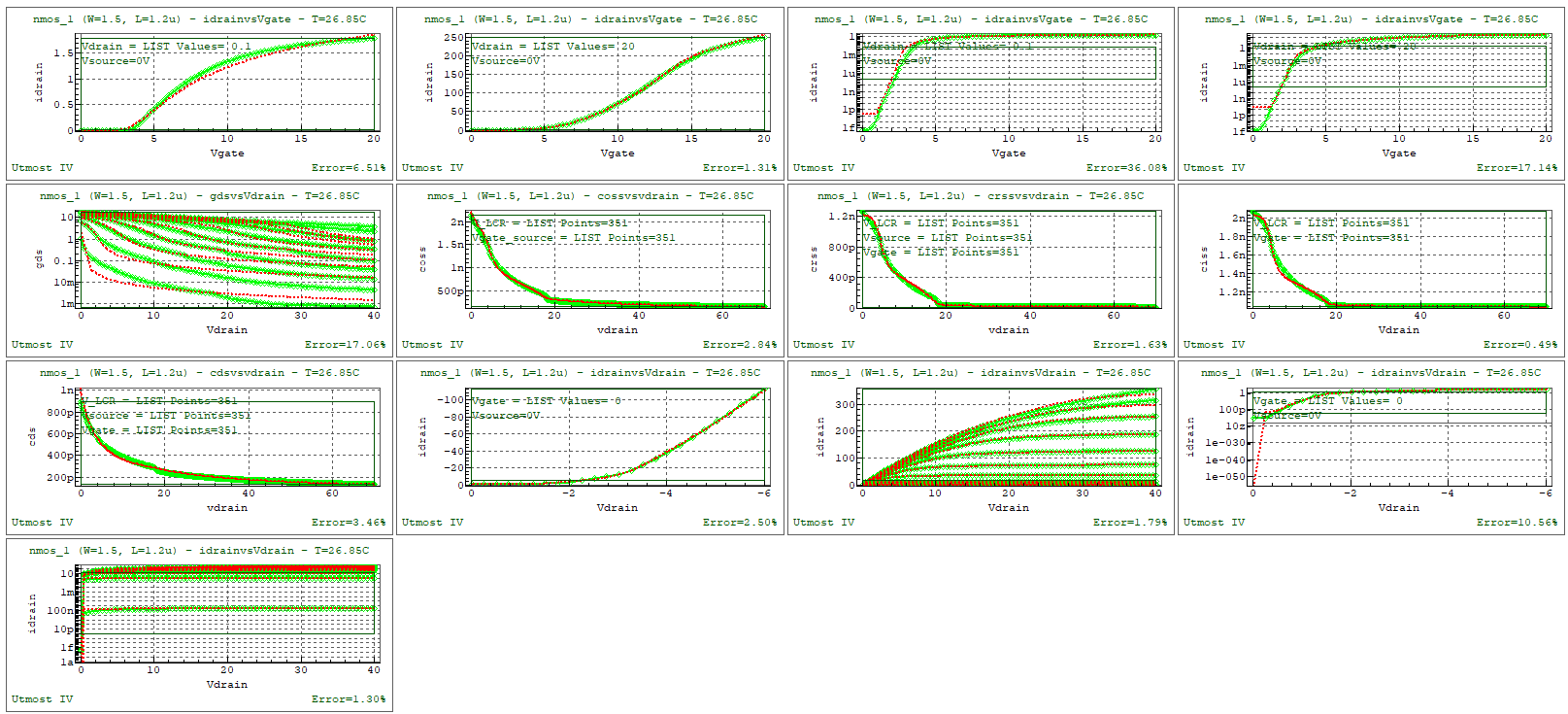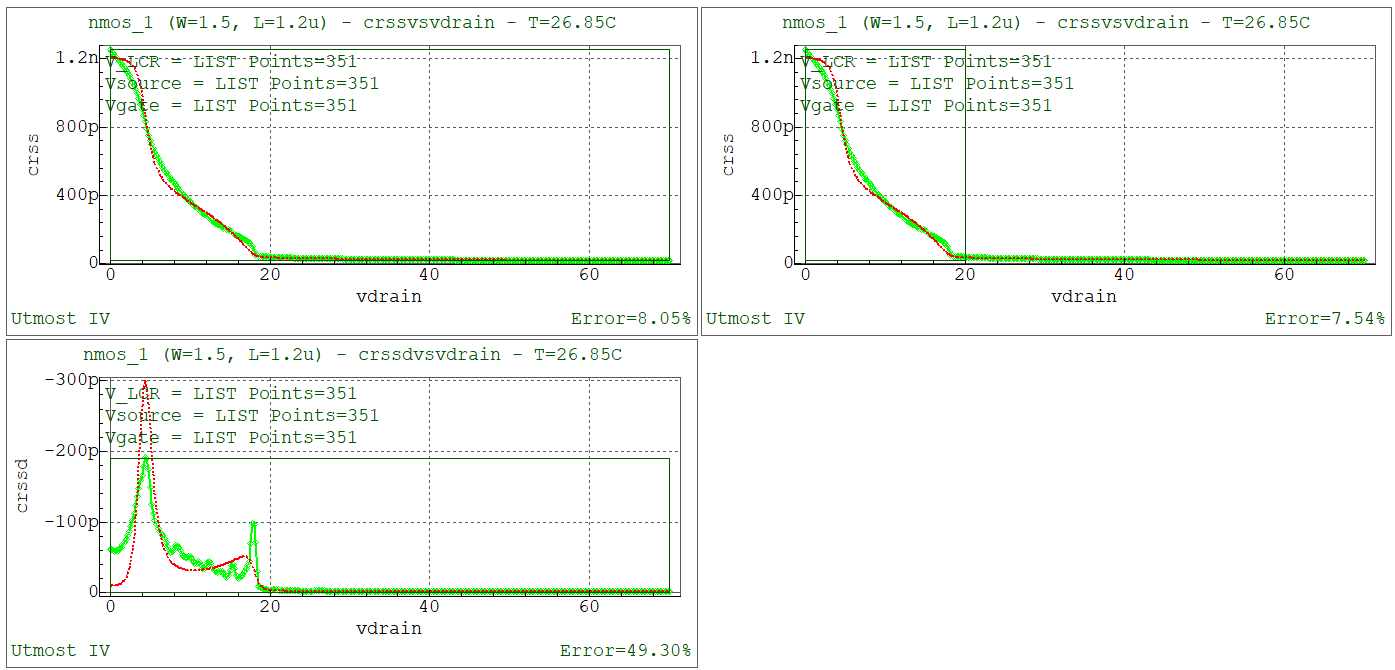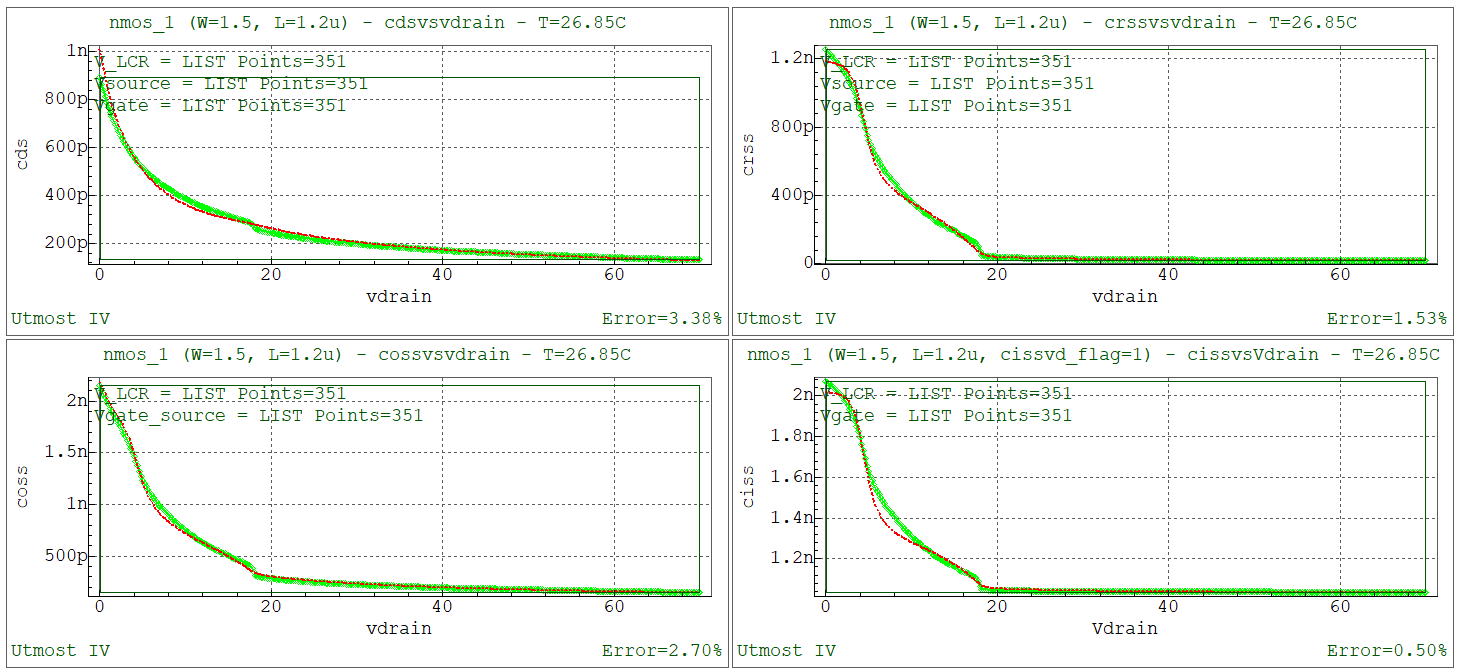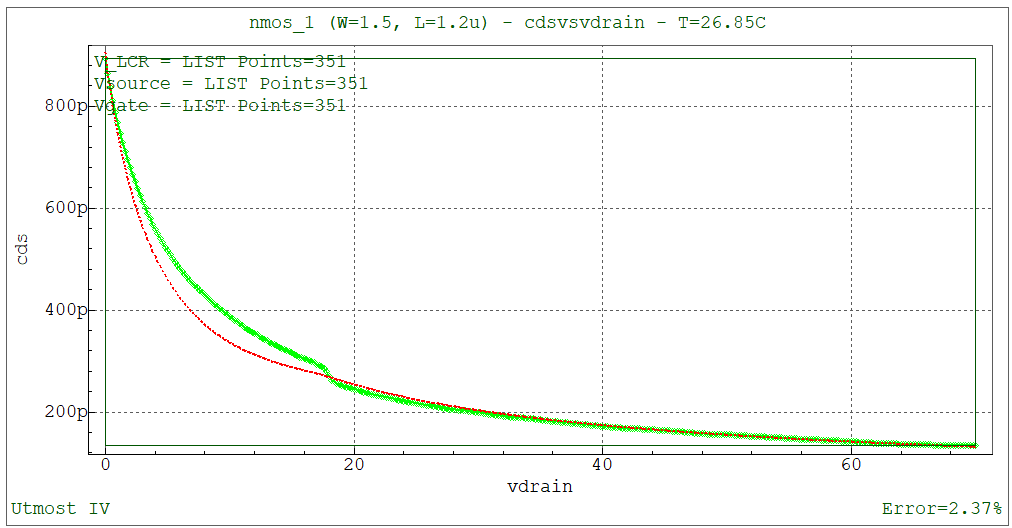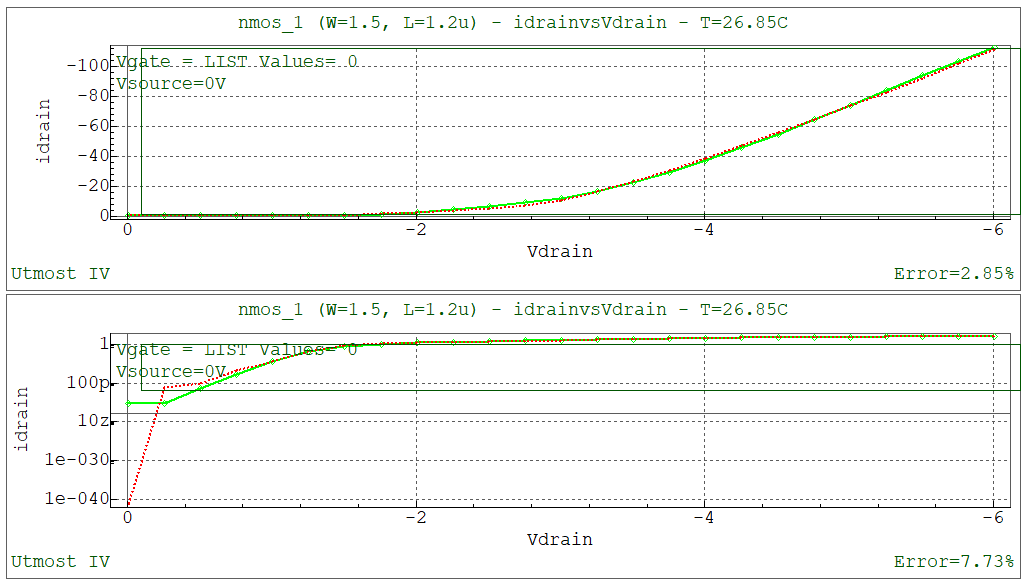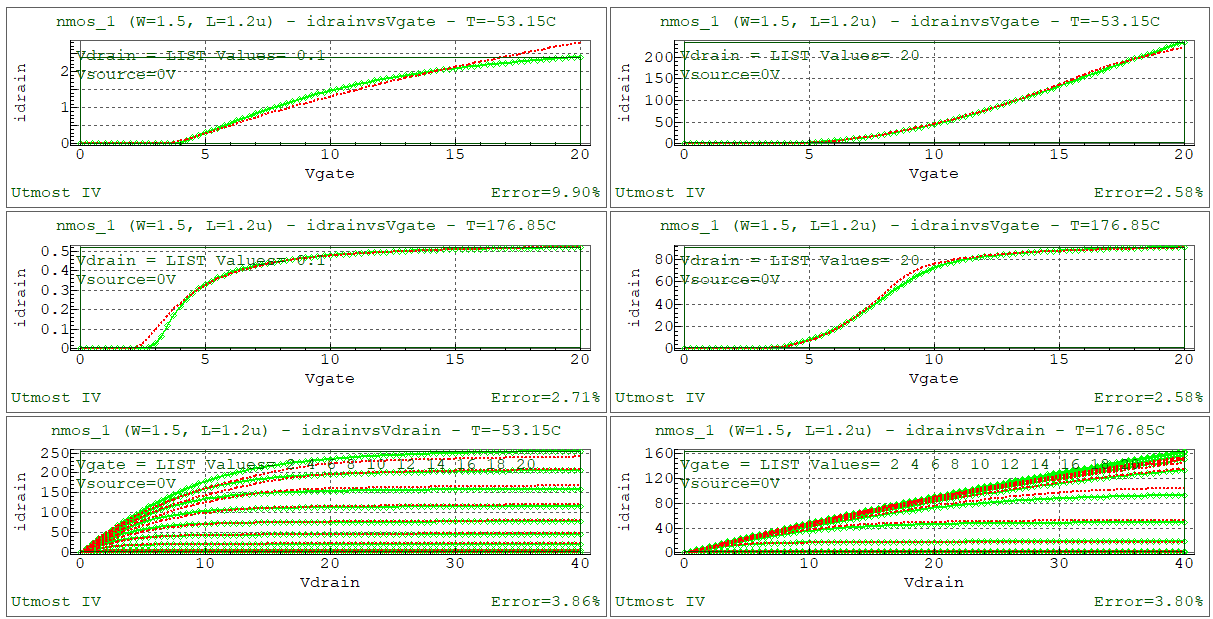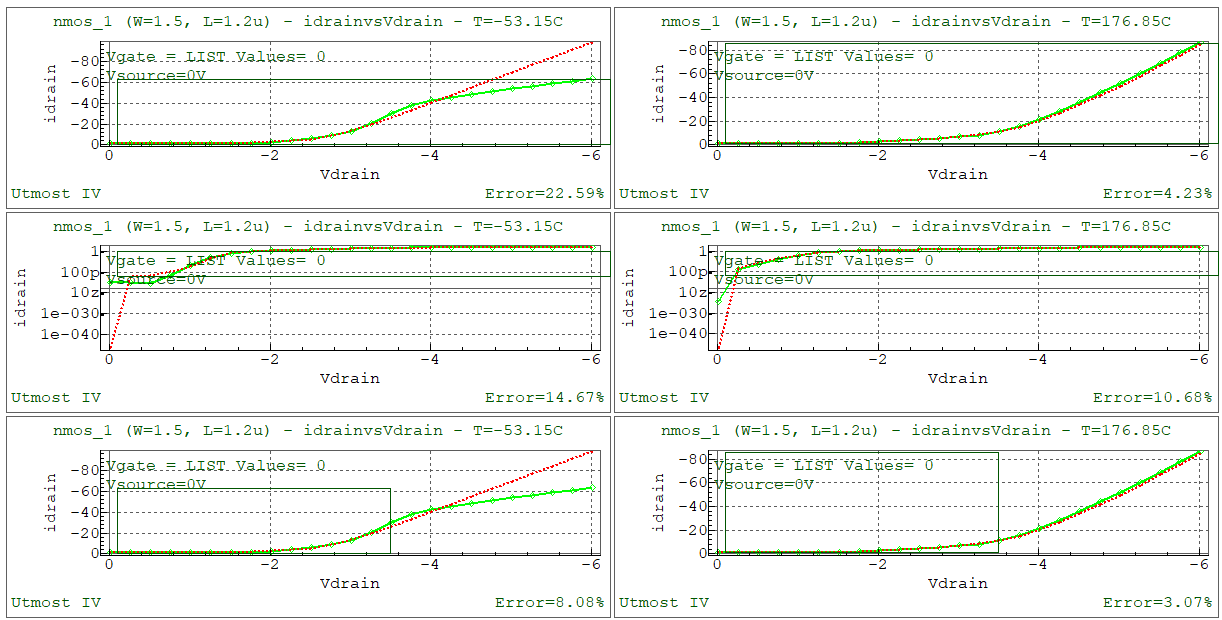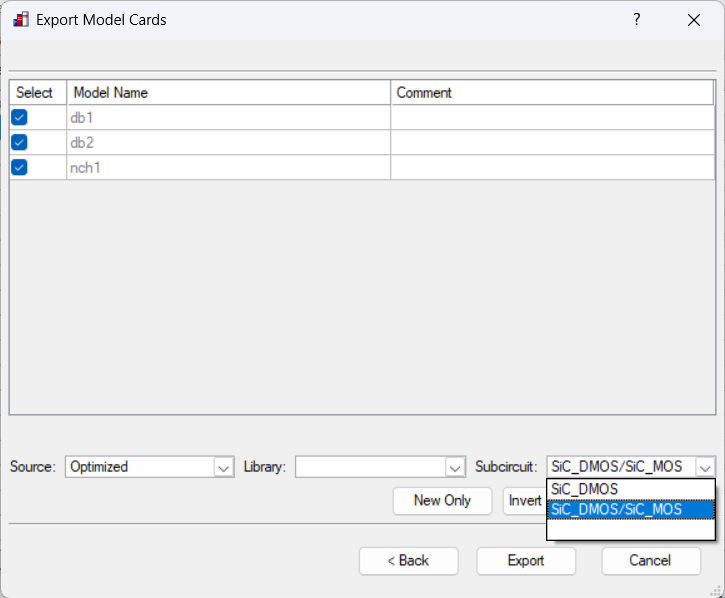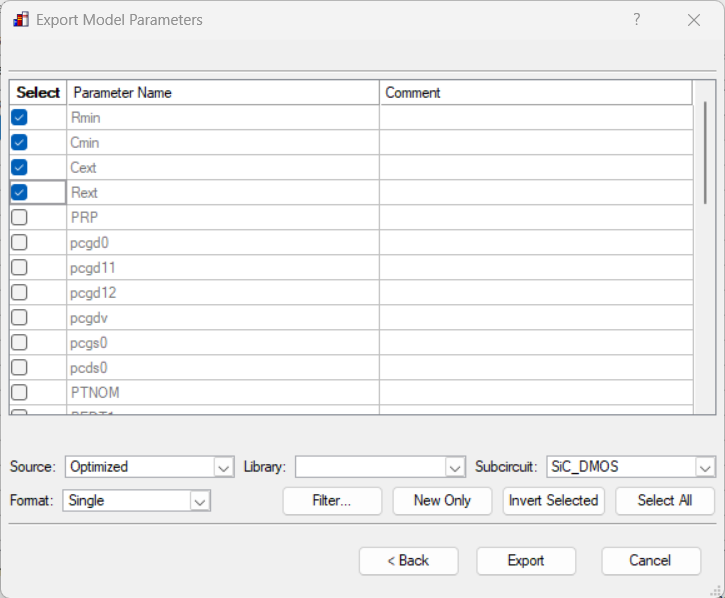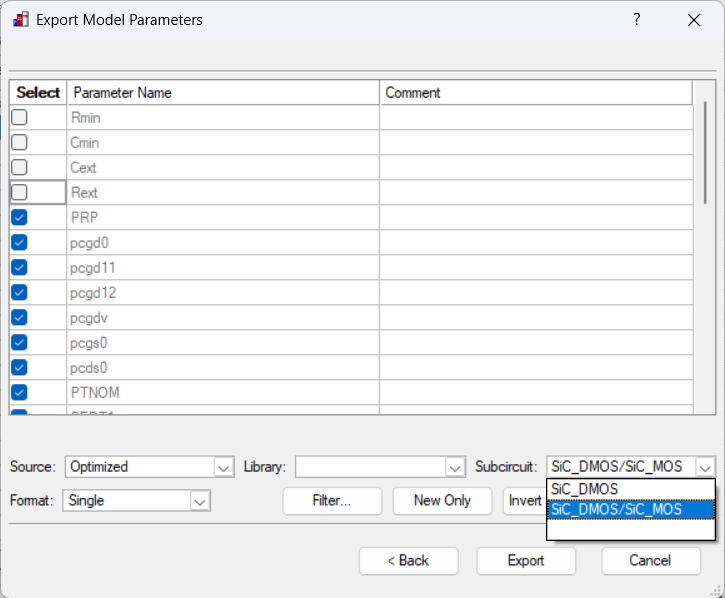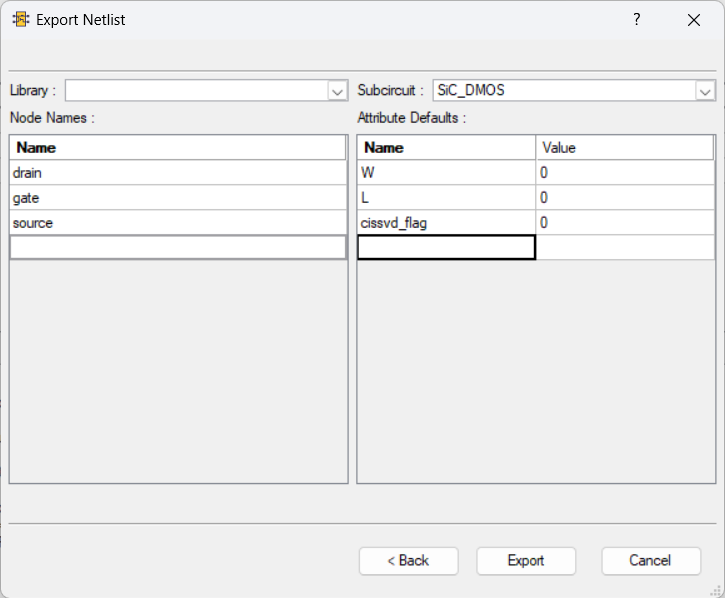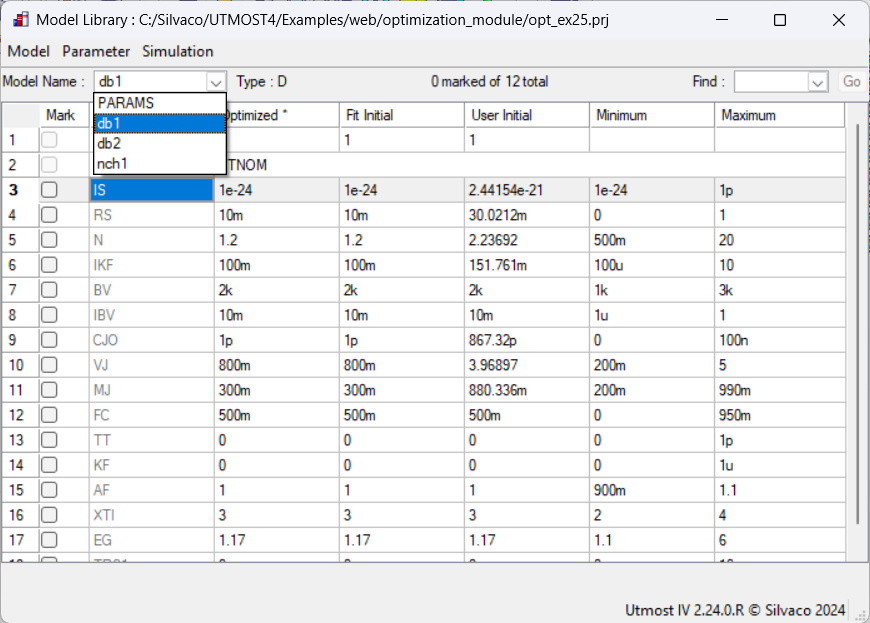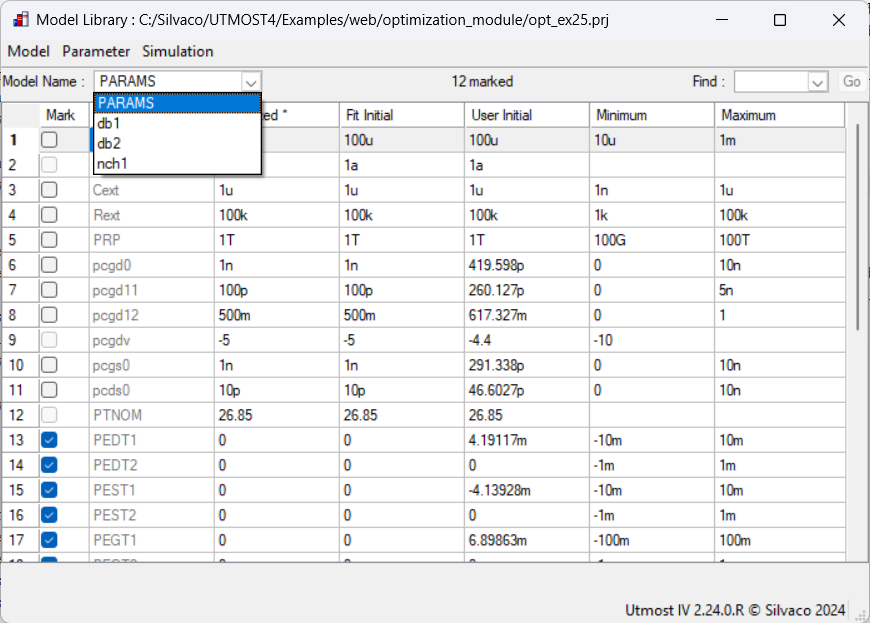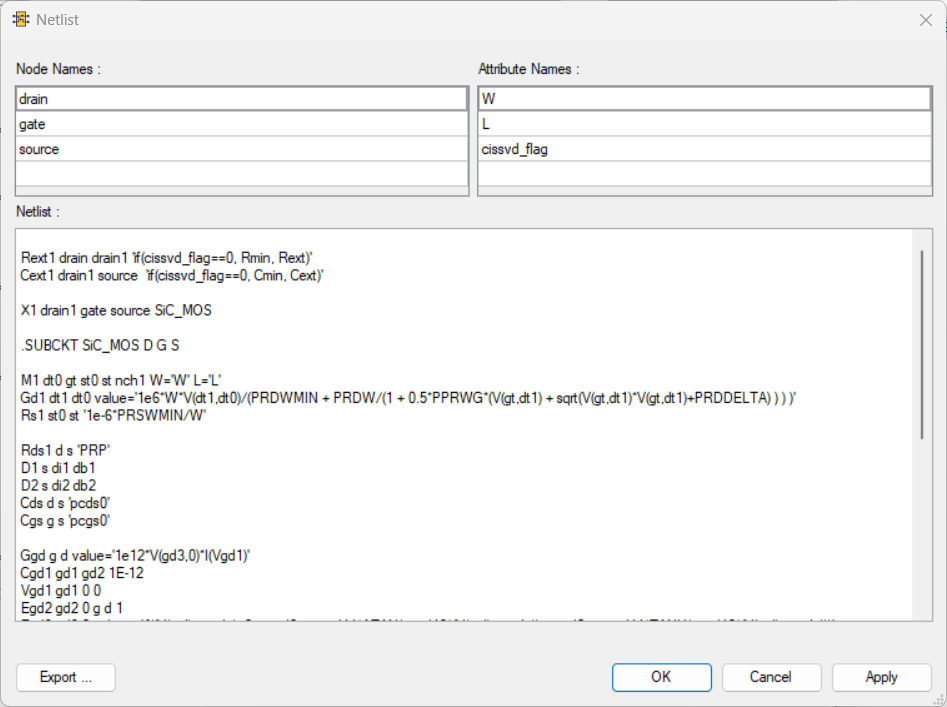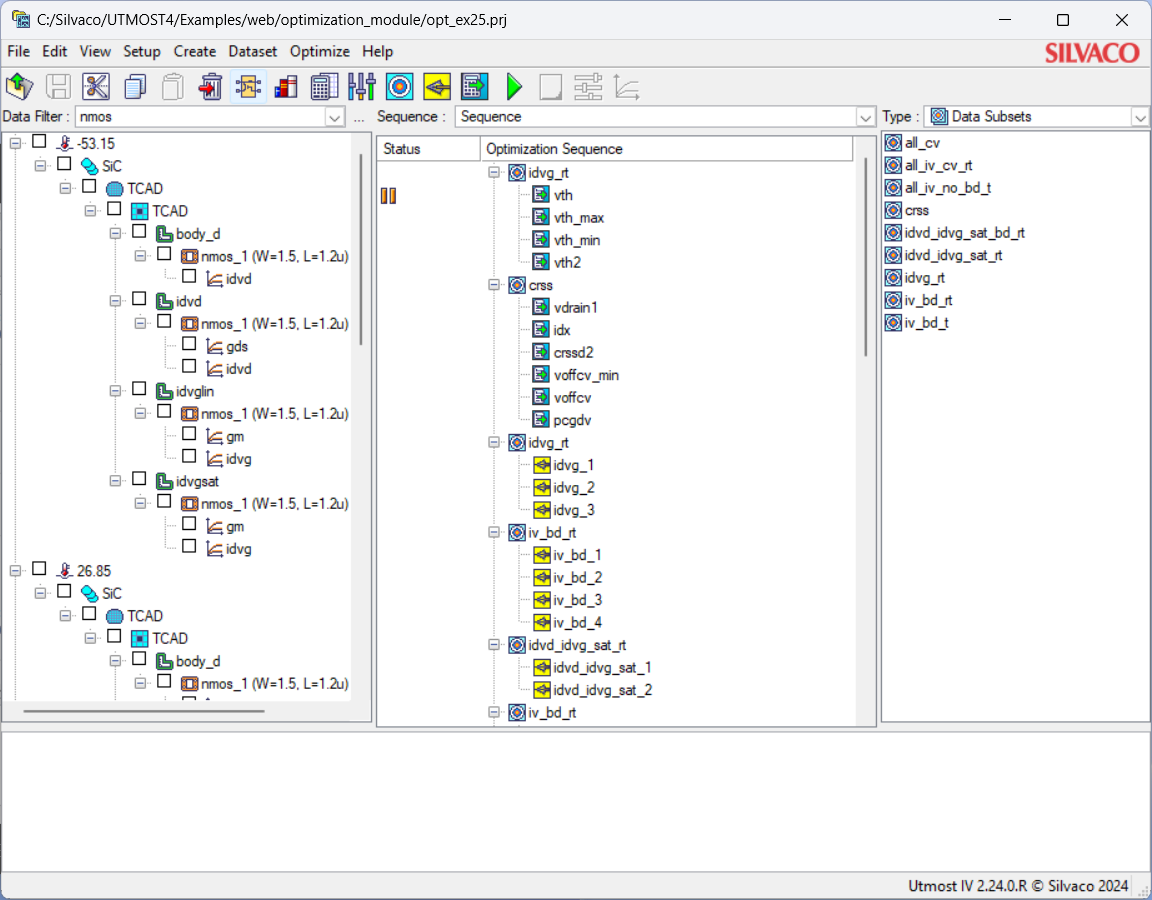opt_ex25 : SiC DMOS Macromodel Extraction
Requires: Utmost IV, SmartSpice, SmartView
Minimum Versions: Utmost IV 2.24.0.R, SmartSpice 5.4.0.R, SmartView 2.34.0.R
This example describes how to extract a macromodel for a SiC Power DMOS.
The project file opt_ex25.prj and the data file opt_ex25.uds for this example should be loaded into your database. When opened, the project will look as shown in opt_ex25_project.png .
Preliminary information
The netlist of the macromodel is partially illustrated in opt_ex25_netlist.png .
The SiC_MOS subcircuit contains the main section of the macromodel and it includes the following SPICE nonlinear circuit elements:
- M1: a MOSFET device instance modeled using a BSIM4 model card
- D1 and D2: two diodes connected between the source and drain of the device, to accurately account for the recovery effect, modeled using diode Level 1 model cards
- Gd1: A bias-controlled current source, in fact, a bias-dependent and temperature-dependent drain conductance
- Gs1: A temperature-dependent source conductance
- Rds1: A constant resistor connected between the drain and source device terminals, to better account for the leakage current of the device
- Ggd: A bias-controlled current source, in fact a bias-dependent capacitor connected between the gate and drain device terminals
- Cgs: A constant capacitor connected between the gate and source device terminals
- Cds: A constant capacitor connected between the drain and source device terminals
These other elements are used in a separate section of the macromodel, to account for the bias-controlled current source Ggd behaving like a capacitor:
- Cgd1: A constant capacitor
- Vgd1: A zero-bias voltage source, used as a current probe
- Egd3: A bias-controlled voltage source, used to implement the bias dependence of Ggd on Vgd
Temperature dependence
Instead of using the built-in temperature dependence parameters of the various model cards and passive components, this example uses an alternative temperature dependence based on additional controlled voltage and current sources. This approach is preferred for power device macromodels, because it can be extended to implement a dynamic circuit temperature dependence, to account for the self-heating phenomenon. The following macromodel elements are used to account for the temperature dependence of other macromodel components.
- Vprobe1: A zero-bias voltage source, used as a current probe
- Ed1, Es1, Eg1, Gds1: Bias-controlled sources to account for the temperature dependence of the core MOSFET element M1
- Edi1: A bias-controlled voltage source, to account for the temperature dependence of the diode D1
- Edi2: A bias-controlled voltage source, to account for the temperature dependence of the diode D2
Model cards and parameters
The macromodel thus includes 3 compact model cards, db1, db2 and nch1, to describe the circuit elements D1, D2 and M1, respectively: opt_ex25_model_cards.png . Additional netlist parameters are used in the bias dependence equations of various circuit elements: opt_ex25_netlist_parameters.png .
Specific netlist for the Ciss capacitance
The Rext1 and Cext1 circuit elements are required for the proper netlist used for simulating the Ciss capacitance versus drain voltage. When the cissvd_flag attribute is not 0 (Ciss data is used), then Rext1=Rext and Cext1=Cext. When the cissvd_flag attribute is 0, then Rext1=Rmin and Cext1=Cmin.
Model extraction sequence
The extraction and optimization sequence, which fully automates the extraction of this macromodel's parameters, has a total of 51 sections. The objective of each section is to isolate a device characteristic and then to optimize or directly calculate specific model parameters. Some of the model parameters are optimized in multiple sections for better fitting.
Sections 1-3: idvg_rt
The first 3 sections are used to extract a preliminary value of the MOSFET threshold voltage parameter, nch1/VTH0, and to properly set its lower and upper limits: opt_ex25_03.png .
Sections 4-10: idvg_rt, crss
The next 7 sections are used to calculate two important capacitance-related parameters based on the Crss capacitance and its derivative, versus drain voltage data, at room temperature, as seen in the Utmost IV Log view: opt_ex25_10.png .
- nch1/VOFFCV BSIM4 C-V offset parameter for the weak to strong inversion transition
- pcgdv Netlist parameter used in the bias dependence of Ggd
Sections 11-13: idvg_rt
This section optimizes the I-V parameters of the MOSFET based on the drain current versus gate voltage characteristic in the linear region and at room temperature. The following model parameters are optimized.
- PARAMS/PRDWMIN Geometry-independent drain resistance
- nch1/VTH0 Threshold voltage
- nch1/U0 Low-field mobility
- nch1/VOFF I-V offset parameter for the weak to strong inversion transition
- nch1/MINV I-V coefficient for the weak to strong inversion transition
- nch1/NFACTOR Subthreshold slope
After these steps have been completed (step idvg_3 has been finished), the fit to measured data will be as shown in opt_ex25_13.png .
Sections 14-17: iv_bd_rt
This section optimizes the I-V parameters of the recovery diodes based on the drain current versus drain voltage characteristic in the third quadrant (negative drain voltage and drain current), at room temperature. The following model parameters are optimized.
- db1/IS Saturation current of diode db1
- db1/RS Series resistance of diode db1
- db1/N Emission coefficient of diode db1
- db1/IKF Knee current of diode db1
- db2/IS Saturation current of diode db2
- db2/RS Series resistance of diode db2
- db2/IKF Knee current of diode db2
After these steps have been completed (step iv_bd_4 has been finished), the fit to measured data will be as shown in opt_ex25_17.png .
Sections 18-19: idvd_idvg_sat_rt
This section optimizes the I-V parameters of the MOSFET based on the drain current versus drain voltage and drain current versus gate voltage characteristics in the saturation region, at room temperature. The following model parameters are optimized.
- PARAMS/PRDWMIN Geometry-independent drain resistance
- nch1/VSAT Saturation velocity
- nch1/PCLM Channel length modulation parameter
After these steps have been completed (step idvd_idvg_sat_2 has been finished), the fit to measured data will be as shown in opt_ex25_19.png .
Sections 20-21: iv_bd_rt
This section refines the I-V parameters of the recovery diodes based on the drain current versus drain voltage characteristic in the third quadrant (negative drain voltage and drain current), at room temperature. The following model parameters are optimized and refined.
- db1/IS Saturation current of diode db1
- db1/RS Series resistance of diode db1
- db1/N Emission coefficient of diode db1
- db1/IKF Knee current of diode db1
- db2/IS Saturation current of diode db2
- db2/RS Series resistance of diode db2
- db2/IKF Knee current of diode db2
After these steps have been completed (step iv_bd_4 has been finished), the fit to measured data will be as shown in opt_ex25_21.png .
Sections 22-23: idvd_idvg_sat_bd_rt
This section optimizes the I-V parameters of the MOSFET based on the drain current versus drain voltage and drain current versus gate voltage characteristics in the saturation region, and the drain current versus drain voltage characteristic in the third quadrant (negative drain voltage and drain current), at room temperature. The following model parameters are optimized and refined.
- PARAMS/PRDWMIN Geometry-independent drain resistance
- PARAMS/PRSWMIN Geometry-independent source resistance
- nch1/VSAT Saturation velocity
- nch1/AGS Vgs dependence of bulk factor
- nch1/PCLM Channel length modulation parameter
After these steps have been completed (step idvd_idvg_sat_bd_2 has been finished), the fit to measured data will be as shown in opt_ex25_23.png .
Sections 24-26: all_iv_rt
This section optimizes the I-V parameters of the MOSFET based on the drain current versus drain voltage and drain current versus gate voltage characteristics in the saturation and linear region, and the drain current versus drain voltage characteristic in the third quadrant (negative drain voltage and drain current), at room temperature. The following model parameters are optimized and refined.
- PARAMS/PRDWMIN Geometry-independent drain resistance
- PARAMS/PRSWMIN Geometry-independent source resistance
- nch1/VTH0 Threshold voltage
- nch1/U0 Low-field mobility
- nch1/UA First-order mobility degradation coefficient due to vertical electric field
- nch1/VSAT Saturation velocity
- nch1/AGS Vgs dependence of bulk factor
- nch1/VOFF I-V offset parameter for the weak to strong inversion transition
- nch1/MINV I-V coefficient for the weak to strong inversion transition
- nch1/NFACTOR Subthreshold slope
- nch1/PCLM Channel length modulation parameter
After these steps have been completed (step iv_3 has been finished), the fit to measured data will be as shown in opt_ex25_26.png .
Section 27: iv_bd_rt
This section refines the I-V parameters of the recovery diodes based on the drain current versus drain voltage characteristic in the third quadrant (negative drain voltage and drain current), at room temperature. The following model parameters are refined.
- db1/IS Saturation current of diode db1
- db1/RS Series resistance of diode db1
- db1/N Emission coefficient of diode db1
- db1/IKF Knee current of diode db1
- db2/IS Saturation current of diode db2
- db2/RS Series resistance of diode db2
- db2/IKF Knee current of diode db2
After these steps have been completed (step iv_bd_4 has been finished), the fit to measured data will be as shown in opt_ex25_27.png .
Section 28-30: all_cv
This section optimizes the C-V parameters of the recovery diode based on the Cds capacitance versus drain voltage data, at room temperature. The following model parameters are optimized.
- PARAMS/pcds0 Netlist parameter used for the drain-source parasitic capacitance
- db1/CJO Zero-bias junction capacitance of diode db1
- db1/VJ Junction potential barrier of diode db1
- db1/MJ Junction grading coefficient of diode db1
After these steps have been completed (step cds_vd_3 has been finished), the fit to measured data will be as shown in opt_ex25_30.png .
Section 31-32: all_cv
This section optimizes the C-V parameters of various macromodel components, based on a combination of Cds, Coss, Crss and Ciss capacitances versus drain voltage data, at room temperature. The following model parameters are optimized and refined.
- PARAMS/pcgd0 Netlist parameter used in the bias dependence of Ggd
- PARAMS/pcgd11 Netlist parameter used in the bias dependence of Ggd
- PARAMS/pcgd12 Netlist parameter used in the bias dependence of Ggd
- PARAMS/pcgs0 Netlist parameter used for the gate-source parasitic capacitance
- nch1/DLC Effective length offset for the MOSFET C-V model
- nch1/VOFFCV MOSFET C-V offset parameter for the weak to strong inversion transition
After these steps have been completed (step all_cvd_2 has been finished), the fit to measured data will be as shown in opt_ex25_32.png .
Section 33: all_cv
This section refines the C-V parameters of various macromodel components, based on the Crss capacitance versus drain voltage data, at room temperature. The following model parameters are refined.
- PARAMS/pcgd0 Netlist parameter used in the bias dependence of Ggd
- PARAMS/pcgd11 Netlist parameter used in the bias dependence of Ggd
- PARAMS/pcgd12 Netlist parameter used in the bias dependence of Ggd
- nch1/VOFFCV MOSFET C-V offset parameter for the weak to strong inversion transition
After these steps have been completed (step crss_1 has been finished), the fit to measured data will be as shown in opt_ex25_33.png .
Section 34-35: all_iv_cv_rt
This section refines all previously optimized parameters of various macromodel components, based on combined I-V and C-V characteristics, at room temperature. The following model parameters are refined.
- PARAMS/pcgd0 Netlist parameter used in the bias dependence of Ggd
- PARAMS/pcgd11 Netlist parameter used in the bias dependence of Ggd
- PARAMS/pcgd12 Netlist parameter used in the bias dependence of Ggd
- PARAMS/pcgs0 Netlist parameter used for the gate-source parasitic capacitance
- PARAMS/pcds0 Netlist parameter used for the drain-source parasitic capacitance
- PARAMS/PRDWMIN Geometry-independent drain resistance
- PARAMS/PRSWMIN Geometry-independent source resistance
- db1/CJO Zero-bias junction capacitance of diode db1
- db1/VJ Junction potential barrier of diode db1
- db1/MJ Junction grading coefficient of diode db1
- nch1/VTH0 Threshold voltage
- nch1/U0 Low-field mobility
- nch1/UA First-order mobility degradation coefficient due to vertical electric field
- nch1/VSAT Saturation velocity
- nch1/AGS Vgs dependence of bulk factor
- nch1/VOFF I-V offset parameter for the weak to strong inversion transition
- nch1/MINV I-V coefficient for the weak to strong inversion transition
- nch1/NFACTOR Subthreshold slope
- nch1/PCLM Channel length modulation parameter
- nch1/DLC Effective length offset for the MOSFET C-V model
- nch1/VOFFCV MOSFET C-V offset parameter for the weak to strong inversion transition
After these steps have been completed (step crss_1 has been finished), the fit to measured data will be as shown in opt_ex25_35.png .
Section 36-37: all_cv
This section refines the C-V parameters of various macromodel components, based on the Crss capacitance and its derivative, versus drain voltage data, at room temperature. The following model parameters are refined.
- PARAMS/pcgd0 Netlist parameter used in the bias dependence of Ggd
- PARAMS/pcgd11 Netlist parameter used in the bias dependence of Ggd
- PARAMS/pcgd12 Netlist parameter used in the bias dependence of Ggd
- nch1/VOFFCV MOSFET C-V offset parameter for the weak to strong inversion transition
After these steps have been completed (step crss_3 has been finished), the fit to measured data will be as shown in opt_ex25_37.png .
Section 38-39: all_cv
This section optimizes the C-V parameters of various macromodel components, based on a combination of Cds, Coss, Crss and Ciss capacitances versus drain voltage data, at room temperature. The following model parameters are optimized and refined.
- PARAMS/pcgd0 Netlist parameter used in the bias dependence of Ggd
- PARAMS/pcgd11 Netlist parameter used in the bias dependence of Ggd
- PARAMS/pcgd12 Netlist parameter used in the bias dependence of Ggd
- PARAMS/pcgs0 Netlist parameter used for the gate-source parasitic capacitance
- nch1/DLC Effective length offset for the MOSFET C-V model
- nch1/VOFFCV MOSFET C-V offset parameter for the weak to strong inversion transition
After these steps have been completed (step all_cvd_4 has been finished), the fit to measured data will be as shown in opt_ex25_39.png .
Section 40-41: all_cv
This section refines the C-V parameters of the recovery diode based on the Cds capacitance versus drain voltage data, at room temperature. The following model parameters are optimized.
- PARAMS/pcds0 Netlist parameter used for the drain-source parasitic capacitance
- db1/CJO Zero-bias junction capacitance of diode db1
- db1/VJ Junction potential barrier of diode db1
- db1/MJ Junction grading coefficient of diode db1
After these steps have been completed (step cds_vd_3 has been finished), the fit to measured data will be as shown in opt_ex25_41.png .
Section 42-45: iv_bd_rt
This section refines the I-V parameters of the recovery diodes based on the drain current versus drain voltage characteristic in the third quadrant (negative drain voltage and drain current), at room temperature. The following model parameters are refined.
- db1/IS Saturation current of diode db1
- db1/RS Series resistance of diode db1
- db1/N Emission coefficient of diode db1
- db1/IKF Knee current of diode db1
- db2/IS Saturation current of diode db2
- db2/RS Series resistance of diode db2
- db2/IKF Knee current of diode db2
After these steps have been completed (step iv_bd_6 has been finished), the fit to measured data will be as shown in opt_ex25_45.png .
Section 46-47: all_iv_no_bd_t
This section optimizes the refines the temperature parameters of various macromodel components, based on I-V characteristics, at different temperatures (high and low). The following model parameters are optimized.
- PARAMS/PEDT1 Netlist parameter used in the bias dependence of Ed1
- PARAMS/PEGT1 Netlist parameter used in the bias dependence of Eg1
- PARAMS/PEGT2 Netlist parameter used in the bias dependence of Eg1
- PARAMS/PGDST1 Netlist parameter used in the bias dependence of Gds1
- PARAMS/PGRDWT1 Netlist parameter used in the bias dependence of Gd1
- PARAMS/PGRDWT2 Netlist parameter used in the bias dependence of Gd1
- PARAMS/PGRSWT1 Netlist parameter used in the bias dependence of Gs1
- PARAMS/PGRSWT2 Netlist parameter used in the bias dependence of Gs1
After these steps have been completed (step iv_t_2 has been finished), the fit to measured data will be as shown in opt_ex25_47.png .
Section 48-51: iv_bd_t
This section optimizes the temperature parameters of the macromodel components associated with the recovery diodes, based on the drain current versus drain voltage characteristic in the third quadrant (negative drain voltage and drain current), at different temperatures (high and low). The following model parameters are optimized.
- PARAMS/PEDIT11 Netlist parameter used in the bias dependence of Edi1
- PARAMS/PEDIT12 Netlist parameter used in the bias dependence of Edi1
- PARAMS/PEDIT21 Netlist parameter used in the bias dependence of Edi2
- PARAMS/PEDIT22 Netlist parameter used in the bias dependence of Edi2
- db1/EG Energy gap of diode db1
- db2/EG Energy gap of diode db1
After these steps have been completed (step iv_bd_t_4 has been finished), the fit to measured data will be as shown in opt_ex25_51.png .
When complete, the project netlist, model cards and netlist parameters can then be exported into an external model library file.
First, the macromodel netlist is exported. We export the whole netlist under the name SiC_DMOS, as shown in opt_ex25_export_netlist.png . As a result, the exported netlist will include two subcircuits, in a 2-level hierarchy: the top level subcircuit, SiC_DMOS, and the lower level subcircuit, SiC_MOS.
The model cards are then exported into the lower level subcircuit, SiC_DMOS/SiC_MOS, as shown in opt_ex25_export_model_cards.png .
Finally, the netlist parameters are exported. The first 4 parameters, Rmin, Cmin, Rext, Cext that are used to account for the Ciss capacitance-specific netlist, must be exported into the top level subcircuit, SiC_DMOS, as shown in opt_ex25_export_netlist_params_1.png . The other netlist parameters will be exported into the lower level subcircuit, SiC_DMOS/SiC_MOS, as shown in opt_ex25_export_netlist_params_2.png .
For this example, the netlist and the final model card and netlist parameters have been exported in the opt_ex25.libr file.
opt_ex25.uds
Utmost IV CSV Data Logfile Format Version 3 Copyright (c) 1984-2024 Silvaco, Inc. All rights reserved DataSetStart DataSetName, body_d MeasurementType, DC BatchName, opt_ex25 WaferName, TCAD DieName, TCAD DeviceName, nmos_1 Temperature, -53.15 FabDate, 25 Jul 2024 UserDate, 25 Jul 2024 Attribute, W, 1.5 Attribute, L, 1.2e-06 NodeNames, source gate drain Sweep, 1, V, drain, LIST, 0.1, 0 List, 1 0 -0.25 -0.5 -0.75 -1 -1.25 -1.5 -1.75 -2 -2.25 -2.5 -2.75 -3 -3.25 -3.5 -3.75 -4 -4.25 -4.5 -4.75 -5 -5.25 -5.5 -5.75 -6 Sweep, 2, V, gate, LIST, 0.1, 0 List, 2 0 Constant, V, source, 0, 0.1, 0 Target, I, drain Target, I, source Target, I, gate Plot, idvd, XY (LIN LIN), vdrain, idrain DataArray, idrain 7.088653223927e-16 6.4562953090861e-16 5.3937210231402e-16 -2.9128547986048e-12 -1.2873651513787e-07 -0.00081032246621372 -0.095602613608007 -0.59781452196179 -1.6106291492903 -3.1708736279511 -5.3218832043648 -8.1447061892095 -11.982565720581 -19.998623000675 -29.252300611088 -36.660837567321 -41.465956269783 -44.899175967087 -47.732097253929 -50.293688022366 -52.739551250613 -55.150488173217 -57.57282021185 -60.038093506963 -62.571424341754 DataArray, igate 0 0 0 0 0 0 0 0 0 0 0 0 0 0 0 0 0 0 0 0 0 0 0 0 0 DataArray, isource -7.0886530873201e-16 -6.4563018931669e-16 -5.3937238422356e-16 2.912854798486e-12 1.287365151368e-07 0.00081032246622141 0.095602613612085 0.59781452195594 1.6106291490685 3.170873628614 5.3218832171293 8.1447062026634 11.982566023465 19.998624171474 29.252300691819 36.660837505498 41.465956338882 44.89917890854 47.732098251939 50.293688903053 52.739552139189 55.150488642747 57.5728203309 60.038093512218 62.571424217438 DataSetFinish DataSetStart DataSetName, idvd MeasurementType, DC BatchName, opt_ex25 WaferName, TCAD DieName, TCAD DeviceName, nmos_1 Temperature, -53.15 FabDate, 25 Jul 2024 UserDate, 25 Jul 2024 Attribute, W, 1.5 Attribute, L, 1.2e-06 NodeNames, source gate drain Sweep, 1, V, drain, LIST, 0.1, 0 List, 1 0 0.5 1 1.5 2 2.5 3 3.5 4 4.5 5 5.5 6 6.5 7 7.5 8 8.5 9 9.5 10 10.5 11 11.5 12 12.5 13 13.5 14 14.5 15 15.5 16 16.5 17 17.5 18 18.5 19 19.5 20 20.5 21 21.5 22 22.5 23 23.5 24 24.5 25 25.5 26 26.5 27 27.5 28 28.5 29 29.5 30 30.5 31 31.5 32 32.5 33 33.5 34 34.5 35 35.5 36 36.5 37 37.5 38 38.5 39 39.5 40 Sweep, 2, V, gate, LIST, 0.1, 0 List, 2 2 4 6 8 10 12 14 16 18 20 Constant, V, source, 0, 0.1, 0 Target, I, drain Target, I, source Target, I, gate Function, gds, derivative (vdrain, idrain) Plot, idvd, XY (LIN LIN), vdrain, idrain Plot, gds, XY (LIN LOG), vdrain, gds DataArray, idrain 7.0824420968475e-16 6.5157208756608e-12 1.2088369338139e-11 1.8447706589666e-11 2.5392440371407e-11 -0.0059653206719399 4.0008293854414e-11 4.7090140458147e-11 5.375091532165e-11 5.9887680395147e-11 6.5453297669479e-11 7.0455667590765e-11 7.4942367215411e-11 7.8963218843321e-11 8.2602742164582e-11 8.5961133933272e-11 8.911841864723e-11 9.2121566598044e-11 9.4994058303999e-11 9.7630046911277e-11 1.0009110270575e-10 1.0242620338098e-10 1.0462820013281e-10 1.0671029259058e-10 1.0868009860272e-10 1.1055420397501e-10 1.1233083763056e-10 1.1400771651692e-10 1.1561530642646e-10 1.171292475233e-10 1.1859417708967e-10 1.1999648101304e-10 1.2132732253787e-10 1.2260556610098e-10 1.2384794061145e-10 1.2500403624038e-10 1.2611839053205e-10 1.2717129170551e-10 1.2815701177077e-10 1.2902013076691e-10 1.2957609535519e-10 1.3008619452444e-10 1.3058550949548e-10 1.3107298815783e-10 1.3154240150462e-10 1.3200407399672e-10 1.3245806018693e-10 1.3290420673532e-10 1.3334068877309e-10 1.3376894043534e-10 1.3419202052924e-10 1.3461108975037e-10 1.350258262728e-10 1.35434900034e-10 1.3583897729022e-10 1.36235981698e-10 1.3662735315224e-10 1.3701764874118e-10 1.3740700057309e-10 1.3779454563316e-10 1.3817908056411e-10 1.3856003174168e-10 1.3893687387686e-10 1.3930986634796e-10 1.3968116721363e-10 1.4005156760508e-10 1.4042041004961e-10 1.4078727231913e-10 1.411531779087e-10 1.4151820798229e-10 1.4188109670612e-10 1.422396362111e-10 1.4259435735496e-10 1.4294754389629e-10 1.432990680193e-10 1.4364851933431e-10 1.4399707078245e-10 1.4434513993811e-10 1.446925044997e-10 1.4503889995634e-10 1.4538415948758e-10 6.9872684608402e-16 0.13076916407508 0.18656416229222 0.2245899153839 0.25328317882583 0.27588172596765 0.29412157249557 0.30911950437742 0.321606228891 0.33211394017781 0.34102277030169 0.34860098270525 0.35507466349465 0.3606366782444 0.36543460904836 0.36958195741274 0.3731829905682 0.376375919796 0.37922806292646 0.38181341623667 0.38416353172975 0.3863191731453 0.38832250501254 0.39018832298113 0.39190421842972 0.39350130103602 0.39497393617014 0.39636112355326 0.39765597721828 0.39885650019402 0.39996835607632 0.40102658757184 0.40202543281206 0.40297419537219 0.40386344349915 0.40470530245836 0.4054921671106 0.40624612290603 0.40691519001666 0.40747929073859 0.40798399535302 0.40843758310631 0.40886429521088 0.4092735781963 0.40966214924763 0.41002208489908 0.41036320498703 0.41068595096999 0.41099076118716 0.4112772895356 0.41154825251949 0.41180548296163 0.41205332474024 0.41229531622991 0.41253265384736 0.41276622336578 0.41299552848498 0.41322014152067 0.41344307106169 0.41366488605343 0.41388508028061 0.41410288921501 0.4143179342154 0.41453008857066 0.41473953551076 0.41494754811923 0.41515463129667 0.41536045870258 0.41556464170211 0.41576760494533 0.41596947445428 0.41616959454721 0.41636678016502 0.41656136551796 0.41675470091084 0.41694670418532 0.4171370466236 0.41732638159444 0.41751503194321 0.41770283008569 0.41788961925484 6.2047019945649e-16 2.3978123818824 3.8156752382112 4.6394126729613 5.1517500439448 5.4988480859095 5.7518551976969 5.9458792805427 6.1004524544022 6.2272866636751 6.3331074524247 6.4222216530556 6.4978746625862 6.5627073537117 6.6187876111273 6.66771223712 6.7107347214306 6.7487725957401 6.7823072424372 6.8114778011979 6.8364061991658 6.8581433029993 6.8775390746399 6.8949040336216 6.9106588775341 6.9250765841393 6.9385447952474 6.9510188397507 6.9624884707242 6.9732124425135 6.9832585436998 6.9925591458123 7.0011655555681 7.0091686476481 7.0167211681661 7.0237749009277 7.0303920501667 7.0363572863049 7.0417499791159 7.0467038159905 7.0511776269936 7.0552863862247 7.059168876481 7.0628548096062 7.0663362552596 7.0695962228668 7.0726779715491 7.0756092709627 7.0783875752137 7.0810258422121 7.0835511333296 7.0859877850634 7.0883431782855 7.0906110169721 7.0927903510581 7.0948890192644 7.0969141201652 7.0988620441991 7.1007445177156 7.1025755990739 7.1043575887484 7.1060892182913 7.1077694060424 7.1093995553343 7.1109843961184 7.1125352190794 7.1140635827618 7.115573336363 7.1170657976499 7.1185435427933 7.1200089723566 7.1214612179289 7.1228945340033 7.1243060899412 7.1257027745552 7.1270883762914 7.1284617459966 7.1298244088193 7.1311798006338 7.1325281542624 7.1338677533451 5.4917605732173e-16 4.9698562539405 8.9389386286875 11.969252361078 14.196592156276 15.803677044899 16.971907014773 17.841503966596 18.507413171693 19.032497879101 19.457264318917 19.806724708169 20.097666065506 20.342888681063 20.552442761685 20.733812357015 20.892554280983 21.03288200487 21.157931625949 21.270014236986 21.371022933424 21.462637754189 21.545849437131 21.62077735407 21.686068370858 21.741018176606 21.788734839935 21.831164836114 21.869603416152 21.904708037592 21.936520884934 21.965890214531 21.993517652262 22.019038195132 22.04270099235 22.064258444082 22.083973969435 22.102241653904 22.119016465399 22.134470529073 22.148776434116 22.162089427684 22.174537238574 22.186092215475 22.196818710655 22.206939770764 22.216557133214 22.225680152884 22.234317876178 22.24252697414 22.250400929835 22.25798905612 22.265304888836 22.272351595895 22.279115851627 22.28560365615 22.291847288835 22.297874860141 22.30371252241 22.309384754946 22.314905768294 22.320276055537 22.325500077263 22.330581828559 22.335526581522 22.340352456408 22.3450690042 22.349684054188 22.354205100614 22.358640099073 22.36298703871 22.367237043849 22.371380406732 22.375416941958 22.379363317004 22.383236194304 22.387046075414 22.390799901116 22.394502922797 22.398154733437 22.401750756838 4.9250416299166e-16 7.0826635809966 13.400016130074 18.918146927691 23.622022604395 27.528197056738 30.699237359793 33.233388372314 35.240157704727 36.829021165634 38.100111696166 39.132332115984 39.980914300584 40.686813787445 41.282495376627 41.792737254678 42.235223619668 42.621964024804 42.961698489282 43.261522719084 43.527680825032 43.765306683021 43.978880137312 44.172159818477 44.347933753742 44.508496337398 44.655755507396 44.791184785707 44.915707079801 45.028881086794 45.126958881335 45.208307964059 45.278941117587 45.341691104983 45.397838282734 45.448509136802 45.494982488737 45.537813563334 45.577372244321 45.614158792037 45.648411377327 45.679695565994 45.708795954024 45.73621210277 45.762111742141 45.786562495324 45.809623523356 45.831493534283 45.852317856131 45.872181650808 45.891059058139 45.908997861808 45.926059732063 45.942297411656 45.957730006642 45.972523592342 45.986774850246 46.000550273994 46.013875685508 46.026749843002 46.039179679287 46.051200051497 46.062842575476 46.074133952759 46.085089276723 46.09574155205 46.106127785706 46.116264208082 46.126150129683 46.135808527685 46.145244138051 46.154461143241 46.163463972636 46.172271468873 46.180892276242 46.189354246691 46.197677376855 46.205865848493 46.213913663288 46.221826007329 46.229596967144 4.5019399499154e-16 8.6631886606731 16.767624046658 24.278093822478 31.160096400166 37.382870607671 42.927721403727 47.79723077433 52.009820045326 55.601368808721 58.630435967598 61.172194471691 63.303800530751 65.092384949529 66.59921909286 67.881419874495 68.983450100827 69.932460621266 70.749726566916 71.45528412049 72.066994122922 72.599753437978 73.066301058973 73.477507673086 73.8424830506 74.168359096527 74.46069465231 74.724251537663 74.963289505784 75.181385461112 75.381436828659 75.56594307299 75.736765315791 75.89541662544 76.043199294562 76.181389633334 76.31064164535 76.430961893664 76.540845819305 76.63483175813 76.715841553738 76.787753784565 76.852872699037 76.91281888726 76.968489401206 77.02047949433 77.069234040488 77.115057898548 77.158127316676 77.198602406687 77.237082013806 77.27362491944 77.308662458401 77.342028317504 77.373898883575 77.404477310255 77.433924275619 77.46233945216 77.489688041473 77.515941148815 77.541200934608 77.565546365057 77.589032590103 77.61158517429 77.633325219022 77.654300766067 77.674563616736 77.694183557225 77.713208830933 77.731664409853 77.749618987446 77.767069390385 77.784118054581 77.800771901264 77.817040619773 77.832930923489 77.848436309074 77.863577683033 77.878369032151 77.892824378691 77.906944154565 4.1870712706386e-16 9.8303823499056 19.239427001424 28.201644591953 36.690964138806 44.680724703719 52.145315269322 59.065230049525 65.427609467873 71.225226892477 76.457956176523 81.135911142254 85.2777648022 88.916060457737 92.092775094533 94.855582002982 97.260130685166 99.353838277876 101.169905382 102.74101450203 104.10085339919 105.27965326996 106.3041797656 107.197319243 107.97865610181 108.66504800014 109.27117107557 109.80833908418 110.28586652226 110.71217820693 111.09451256177 111.43923311828 111.75217245772 112.03796875614 112.3006109564 112.54321094524 112.76815844577 112.97768078296 113.17357139818 113.35746019032 113.53061565564 113.69426676568 113.84942606356 113.99683826768 114.13736058135 114.27160947251 114.40010351604 114.52318661966 114.64111107238 114.7536653764 114.86020862383 114.95956002317 115.04761583625 115.12536908176 115.19612681766 115.26134485122 115.32217751927 115.37923228474 115.43291490874 115.48363398471 115.53167671473 115.57739988536 115.62098797414 115.66264298504 115.70262007831 115.74093532882 115.77796091976 115.81379802389 115.84857120553 115.88258225569 115.91572804592 115.94784026156 115.97892141694 116.00917864684 116.03852755635 116.06712022461 116.09499526786 116.12212930342 116.14853603326 116.17433331726 116.19948305439 3.9482792574496e-16 10.707449296733 21.080296703441 31.099394913237 40.746010252878 50.00144294604 58.845147006147 67.259508287351 75.230096769245 82.745497967174 89.796535324812 96.375494150412 102.47063478091 108.07737017226 113.20359584093 117.86571789691 122.08297218465 125.87937325174 129.28148733206 132.30980480186 134.99338242514 137.36498867096 139.45841613285 141.30521038939 142.93549932562 144.37612748329 145.65083929738 146.78123137533 147.78655511955 148.68389068667 149.4882766927 150.21159580914 150.8637788773 151.4530860551 151.9870797904 152.47265500178 152.91614795737 153.3230652259 153.69804959582 154.04499789277 154.3669898205 154.66651807035 154.94576434583 155.20680331062 155.45165696222 155.68211469873 155.89966752977 156.10556719082 156.30088967446 156.48665893813 156.66372344656 156.8328113476 156.99469122784 157.15006246739 157.29934072035 157.44289344867 157.58107786322 157.71429290434 157.84288023623 157.96714386281 158.08734184131 158.20371265333 158.31623264416 158.42522429643 158.53093961371 158.63360415962 158.73316454785 158.82966232236 158.92275926274 159.01211866114 159.09638345284 159.17248244517 159.24226094128 159.30715098104 159.36751346212 159.42453890667 159.4785241003 159.53010123232 159.57960930392 159.62707474029 159.67291917205 3.7627990755027e-16 11.383028932352 22.486749334145 33.295010690697 43.792815649394 53.965896099928 63.798993431172 73.275867848714 82.38302574165 91.111630064429 99.454140269402 107.40066571938 114.93713533248 122.05298416761 128.74187030156 135.00433872671 140.84388236659 146.26751504356 151.28631570805 155.91078331393 160.15267740383 164.02440091518 167.54560104081 170.74047381478 173.63574649412 176.2564503234 178.62758075464 180.77474226628 182.72128023028 184.48826774884 186.09468754454 187.55756506122 188.89211092223 190.11159686468 191.2276234187 192.25036684284 193.18970609411 194.05451953516 194.85223313047 195.58911078798 196.2708226615 196.90252444512 197.48863058241 198.03286938906 198.53891113174 199.01080962598 199.45182141525 199.86473440787 200.25198928249 200.61549255028 200.95763062422 201.28033985472 201.58522003326 201.87370314769 202.14700941965 202.40625925506 202.65265659491 202.88738407659 203.11111412336 203.32480960841 203.52911020368 203.72471116637 203.9120330716 204.09182055589 204.26472548711 204.43130834164 204.59192377712 204.74682119773 204.89629661678 205.04080339648 205.1806837344 205.31623667178 205.44778014549 205.57563956046 205.70014175109 205.82151896871 205.9398835971 206.05547778918 206.16833402836 206.27856508645 206.3863259699 3.6153722541032e-16 11.916188822334 23.589303905271 35.004218460969 46.147589598374 57.006913572105 67.569669785703 77.820324476726 87.746978800874 97.339130291825 106.58879909517 115.48809171036 124.02484925529 132.1856950168 139.96213805172 147.34882398396 154.34570355288 160.95553418819 167.1833308623 173.03583756343 178.51896367948 183.64361446997 188.42287025954 192.87256779795 197.00891372212 200.85074502692 204.41809718758 207.73007683025 210.8057879887 213.66366919152 216.32018664985 218.79090639323 221.08954557647 223.22851475772 225.22098916354 227.07772952364 228.80945405386 230.42711638469 231.94005741005 233.35638296273 234.68317839498 235.92697474199 237.09404396578 238.18999651028 239.21966892459 240.18744574512 241.0972592499 241.95331216313 242.75873327092 243.51748062311 244.2324184365 244.9067621967 245.54334281847 246.14452350821 246.71279214047 247.25019855502 247.75870217958 248.24056768657 248.69804343304 249.13306783823 249.54714884209 249.94154611692 250.31745832481 250.67615960772 251.01872872089 251.34613207546 251.65917425638 251.95844536706 252.24460016565 252.51850469851 252.78116489689 253.03317022789 253.27539481351 253.50856022141 253.73328732277 253.95005297337 254.15908276398 254.36099246792 254.5561424662 254.74481904052 254.92725592715 DataArray, igate 0 0 0 0 0 0 0 0 0 0 0 0 0 0 0 0 0 0 0 0 0 0 0 0 0 0 0 0 0 0 0 0 0 0 0 0 0 0 0 0 0 0 0 0 0 0 0 0 0 0 0 0 0 0 0 0 0 0 0 0 0 0 0 0 0 0 0 0 0 0 0 0 0 0 0 0 0 0 0 0 0 0 0 0 0 0 0 0 0 0 0 0 0 0 0 0 0 0 0 0 0 0 0 0 0 0 0 0 0 0 0 0 0 0 0 0 0 0 0 0 0 0 0 0 0 0 0 0 0 0 0 0 0 0 0 0 0 0 0 0 0 0 0 0 0 0 0 0 0 0 0 0 0 0 0 0 0 0 0 0 0 0 0 0 0 0 0 0 0 0 0 0 0 0 0 0 0 0 0 0 0 0 0 0 0 0 0 0 0 0 0 0 0 0 0 0 0 0 0 0 0 0 0 0 0 0 0 0 0 0 0 0 0 0 0 0 0 0 0 0 0 0 0 0 0 0 0 0 0 0 0 0 0 0 0 0 0 0 0 0 0 0 0 0 0 0 0 0 0 0 0 0 0 0 0 0 0 0 0 0 0 0 0 0 0 0 0 0 0 0 0 0 0 0 0 0 0 0 0 0 0 0 0 0 0 0 0 0 0 0 0 0 0 0 0 0 0 0 0 0 0 0 0 0 0 0 0 0 0 0 0 0 0 0 0 0 0 0 0 0 0 0 0 0 0 0 0 0 0 0 0 0 0 0 0 0 0 0 0 0 0 0 0 0 0 0 0 0 0 0 0 0 0 0 0 0 0 0 0 0 0 0 0 0 0 0 0 0 0 0 0 0 0 0 0 0 0 0 0 0 0 0 0 0 0 0 0 0 0 0 0 0 0 0 0 0 0 0 0 0 0 0 0 0 0 0 0 0 0 0 0 0 0 0 0 0 0 0 0 0 0 0 0 0 0 0 0 0 0 0 0 0 0 0 0 0 0 0 0 0 0 0 0 0 0 0 0 0 0 0 0 0 0 0 0 0 0 0 0 0 0 0 0 0 0 0 0 0 0 0 0 0 0 0 0 0 0 0 0 0 0 0 0 0 0 0 0 0 0 0 0 0 0 0 0 0 0 0 0 0 0 0 0 0 0 0 0 0 0 0 0 0 0 0 0 0 0 0 0 0 0 0 0 0 0 0 0 0 0 0 0 0 0 0 0 0 0 0 0 0 0 0 0 0 0 0 0 0 0 0 0 0 0 0 0 0 0 0 0 0 0 0 0 0 0 0 0 0 0 0 0 0 0 0 0 0 0 0 0 0 0 0 0 0 0 0 0 0 0 0 0 0 0 0 0 0 0 0 0 0 0 0 0 0 0 0 0 0 0 0 0 0 0 0 0 0 0 0 0 0 0 0 0 0 0 0 0 0 0 0 0 0 0 0 0 0 0 0 0 0 0 0 0 0 0 0 0 0 0 0 0 0 0 0 0 0 0 0 0 0 0 0 0 0 0 0 0 0 0 0 0 0 0 0 0 0 0 0 0 0 0 0 0 0 0 0 0 0 0 0 0 0 0 0 0 0 0 0 0 0 0 0 0 0 0 0 0 0 0 0 0 0 0 0 0 0 0 0 0 0 0 0 0 0 0 0 0 0 0 0 0 0 0 0 0 0 0 0 0 0 0 0 0 0 0 0 0 0 0 0 0 0 0 0 0 0 0 0 0 0 0 0 0 0 0 0 0 0 0 0 0 0 0 0 0 0 0 0 0 0 0 0 0 0 0 0 0 0 0 0 0 0 0 0 0 0 0 0 0 0 0 0 0 0 0 0 0 0 0 0 DataArray, isource -7.0824422765507e-16 -6.5157208772095e-12 -1.2088369339193e-11 -1.8447706593629e-11 -2.5392440375016e-11 -3.268574503173e-11 -4.0008293854952e-11 -4.7090140459301e-11 -5.37509153227e-11 -5.9887680397917e-11 -6.5453297672792e-11 -7.0455667591626e-11 -7.4942367216017e-11 -7.8963218848634e-11 -8.2602742168897e-11 -8.5961133933822e-11 -8.9118418651055e-11 -9.2121566598762e-11 -9.4994058308588e-11 -9.763004691195e-11 -1.0009110270589e-10 -1.0242620338098e-10 -1.0462820013738e-10 -1.0671029259066e-10 -1.0868009860751e-10 -1.1055420397883e-10 -1.1233083763439e-10 -1.1400771652169e-10 -1.1561530642942e-10 -1.1712924752544e-10 -1.185941770894e-10 -1.1999648101291e-10 -1.2132732253813e-10 -1.2260556610114e-10 -1.2384794061115e-10 -1.2500403624005e-10 -1.2611839053205e-10 -1.2717129170732e-10 -1.2815701177041e-10 -1.2902013076655e-10 -1.2957609535489e-10 -1.3008619452429e-10 -1.3058550949744e-10 -1.3107298816013e-10 -1.315424015045e-10 -1.3200407400183e-10 -1.3245806018709e-10 -1.3290420673823e-10 -1.333406887726e-10 -1.3376894043821e-10 -1.3419202052933e-10 -1.3461108975314e-10 -1.3502582627546e-10 -1.3543490003657e-10 -1.3583897728985e-10 -1.3623598170053e-10 -1.3662735315546e-10 -1.3701764874329e-10 -1.3740700057225e-10 -1.3779454563351e-10 -1.3817908056404e-10 -1.385600317444e-10 -1.3893687387691e-10 -1.3930986635076e-10 -1.3968116721314e-10 -1.4005156760524e-10 -1.4042041004919e-10 -1.4078727231855e-10 -1.4115317790798e-10 -1.415182079816e-10 -1.4188109670548e-10 -1.4223963621376e-10 -1.4259435735793e-10 -1.4294754389595e-10 -1.4329906801912e-10 -1.4364851933391e-10 -1.4399707078198e-10 -1.4434513993768e-10 -1.4469250450144e-10 -1.4503889995918e-10 -1.4538415948984e-10 -6.9872687875449e-16 -0.1307691640762 -0.18656416229003 -0.22458991538338 -0.25328317882408 -0.27588172596557 -0.29412157249784 -0.30911950437535 -0.32160622888887 -0.33211394018031 -0.34102277030377 -0.34860098270539 -0.35507466349213 -0.36063667824747 -0.36543460904637 -0.36958195741052 -0.37318299057054 -0.37637591979313 -0.37922806292316 -0.381813416234 -0.38416353172734 -0.38631917314491 -0.38832250501071 -0.39018832297929 -0.39190421842796 -0.39350130103772 -0.39497393616814 -0.39636112355545 -0.39765597721635 -0.39885650019212 -0.39996835607889 -0.40102658756999 -0.40202543281053 -0.40297419537037 -0.40386344349652 -0.40470530245659 -0.4054921671127 -0.40624612290281 -0.40691519001406 -0.4074792907374 -0.40798399535303 -0.40843758310616 -0.40886429521205 -0.40927357819551 -0.40966214924785 -0.41002208489863 -0.41036320498613 -0.41068595096936 -0.41099076118721 -0.4112772895362 -0.4115482525189 -0.41180548296199 -0.41205332474008 -0.41229531622975 -0.41253265384734 -0.41276622336659 -0.41299552848471 -0.41322014152039 -0.41344307106115 -0.41366488605266 -0.41388508028162 -0.41410288921281 -0.4143179342136 -0.41453008857216 -0.41473953551327 -0.41494754812129 -0.41515463129831 -0.41536045870393 -0.41556464170329 -0.41576760494613 -0.41596947445514 -0.41616959454809 -0.4163667801653 -0.41656136551832 -0.41675470091065 -0.41694670418556 -0.41713704662386 -0.41732638159468 -0.41751503194308 -0.41770283008512 -0.4178896192536 -6.2047018247233e-16 -2.3978123818654 -3.8156752382474 -4.6394126729929 -5.1517500439096 -5.4988480859424 -5.751855197665 -5.9458792805748 -6.1004524543565 -6.2272866636239 -6.3331074523801 -6.4222216530099 -6.4978746625391 -6.562707353676 -6.6187876110998 -6.6677122371017 -6.7107347214214 -6.748772595762 -6.7823072425699 -6.8114778011885 -6.8364061991054 -6.8581433030136 -6.8775390746257 -6.8949040336033 -6.9106588775597 -6.9250765841849 -6.9385447952555 -6.9510188397287 -6.9624884707536 -6.9732124425395 -6.9832585437239 -6.9925591457831 -7.0011655555901 -7.0091686476739 -7.0167211681345 -7.0237749009501 -7.0303920501432 -7.0363572863304 -7.0417499791344 -7.0467038160049 -7.0511776270202 -7.055286386191 -7.0591688765012 -7.0628548096316 -7.0663362552348 -7.0695962228913 -7.0726779715263 -7.0756092709761 -7.0783875751843 -7.0810258422143 -7.0835511333427 -7.0859877850324 -7.0883431782806 -7.090611016963 -7.0927903510637 -7.0948890192427 -7.0969141201572 -7.0988620441877 -7.100744517721 -7.1025755990882 -7.1043575887664 -7.1060892182708 -7.1077694060178 -7.1093995553103 -7.1109843960999 -7.1125352190637 -7.1140635827595 -7.1155733363608 -7.1170657976519 -7.1185435428002 -7.1200089723714 -7.1214612179317 -7.1228945340047 -7.1243060899435 -7.1257027745705 -7.1270883763148 -7.1284617460117 -7.1298244088327 -7.1311798006434 -7.1325281542674 -7.1338677533466 -5.4917604145139e-16 -4.9698562539033 -8.93893862875 -11.96925236115 -14.196592156368 -15.80367704503 -16.971907014898 -17.84150396671 -18.507413171788 -19.032497879168 -19.457264318948 -19.80672470816 -20.097666065449 -20.342888680965 -20.552442761568 -20.7338123569 -20.892554280868 -21.032882004818 -21.157931626029 -21.270014237232 -21.371022931843 -21.462637754611 -21.545849437346 -21.620777354151 -21.686068370745 -21.741018176873 -21.78873483886 -21.831164836008 -21.869603416702 -21.904708037564 -21.936520885129 -21.965890214427 -21.993517652743 -22.019038194875 -22.04270099265 -22.064258444181 -22.08397396931 -22.102241653985 -22.119016465501 -22.134470528958 -22.148776434017 -22.16208942757 -22.174537238451 -22.18609221535 -22.196818710795 -22.206939770744 -22.216557133431 -22.225680152788 -22.23431787627 -22.242526974085 -22.250400929903 -22.25798905603 -22.26530488892 -22.27235159589 -22.279115851631 -22.285603656077 -22.291847288895 -22.29787486006 -22.303712522337 -22.309384754865 -22.314905768265 -22.320276055559 -22.325500077176 -22.330581828352 -22.335526581328 -22.340352456151 -22.345069004025 -22.349684054277 -22.354205100683 -22.358640099127 -22.362987038799 -22.367237043955 -22.371380406845 -22.375416942055 -22.379363316872 -22.383236194062 -22.387046075263 -22.390799901003 -22.394502922711 -22.398154733378 -22.401750756782 -4.9250413894441e-16 -7.0826635809465 -13.400016130141 -18.918146927553 -23.622022604184 -27.528197056531 -30.699237359568 -33.233388372044 -35.240157704413 -36.829021165396 -38.100111695985 -39.132332115869 -39.980914300555 -40.686813787493 -41.282495376764 -41.792737253972 -42.235223619084 -42.621964024062 -42.961698488556 -43.261522718979 -43.527680825754 -43.765306685277 -43.978880141518 -44.17215982395 -44.347933752504 -44.50849634015 -44.655755506512 -44.791184780558 -44.915707078346 -45.028881099719 -45.126958884146 -45.208307971943 -45.278941100949 -45.341691074747 -45.397838276732 -45.448509133287 -45.494982484158 -45.537813561901 -45.577372245062 -45.614158791424 -45.648411378928 -45.679695566073 -45.708795951007 -45.736212103224 -45.762111741837 -45.786562495348 -45.809623523107 -45.831493534077 -45.852317855897 -45.872181650808 -45.891059058706 -45.908997861951 -45.926059732064 -45.942297411723 -45.957730006524 -45.97252359158 -45.986774850004 -46.000550273744 -46.013875685191 -46.026749842977 -46.039179679651 -46.051200049369 -46.062842575389 -46.07413395275 -46.085089274696 -46.095741552252 -46.106127782493 -46.116264207172 -46.126150129043 -46.135808527671 -46.145244137538 -46.154461142888 -46.16346397224 -46.172271467889 -46.180892275734 -46.18935424656 -46.197677375684 -46.205865847902 -46.213913663086 -46.221826007093 -46.229596968018 -4.5019397172579e-16 -8.6631886607224 -16.767624046755 -24.278093822604 -31.16009640032 -37.382870607888 -42.9277214039 -47.797230774481 -52.009820045487 -55.601368808809 -58.630435967608 -61.172194471634 -63.303800530557 -65.092384949317 -66.599219092738 -67.881419874629 -68.983450101098 -69.932460626807 -70.749726573729 -71.455284120774 -72.066994124403 -72.599753470524 -73.066301103678 -73.477507731906 -73.842483042878 -74.168359081983 -74.460694692596 -74.724251550567 -74.963289488259 -75.181385432616 -75.381436788421 -75.565943036131 -75.736765285011 -75.895416602899 -76.043199281112 -76.181389628572 -76.31064158719 -76.430961871147 -76.540845792011 -76.634831622125 -76.715841565941 -76.78775384364 -76.852872804961 -76.912818947316 -76.968489420703 -77.020479507551 -77.069234043597 -77.115057897115 -77.158127315455 -77.198602415466 -77.237082011937 -77.273624922652 -77.308662458284 -77.342028292353 -77.373898885223 -77.404477318317 -77.433924282331 -77.462339453613 -77.489688043769 -77.515941149296 -77.541200938682 -77.565546366124 -77.589032592755 -77.611585171543 -77.633325224167 -77.65430076717 -77.674563618431 -77.694183559255 -77.7132088356 -77.731664411453 -77.749618988839 -77.767069396891 -77.784118058439 -77.800771898105 -77.817040624263 -77.832930926863 -77.848436308441 -77.863577685455 -77.878369035074 -77.892824383129 -77.906944156725 -4.1870710856442e-16 -9.8303823499474 -19.239427001531 -28.20164459213 -36.690964139058 -44.680724704002 -52.145315269594 -59.065230049682 -65.427609467916 -71.225226892429 -76.457956175537 -81.135911142346 -85.277764801489 -88.916060457761 -92.092775094694 -94.855582003305 -97.260130685618 -99.353838278252 -101.16990538237 -102.74101450144 -104.10085340113 -105.27965327063 -106.3041797723 -107.19731925419 -107.97865612342 -108.66504802767 -109.27117111044 -109.80833912587 -110.28586656857 -110.7121782501 -111.09451260112 -111.43923314207 -111.7521724431 -112.0379687597 -112.30061093691 -112.54321092237 -112.76815876246 -112.97768073443 -113.17357136791 -113.357460162 -113.53061562781 -113.69426673439 -113.84942603769 -113.9968382507 -114.13736055834 -114.2716094556 -114.40010349528 -114.52318658936 -114.6411110567 -114.75366541055 -114.86020863177 -114.95956005411 -115.0476159181 -115.12536890664 -115.19612684124 -115.26134491834 -115.32217758526 -115.37923232439 -115.43291492574 -115.48363399484 -115.53167675268 -115.57739988016 -115.62098800507 -115.66264299286 -115.70262010015 -115.74093533052 -115.77796088889 -115.81379799859 -115.84857124709 -115.88258224843 -115.91572801768 -115.94784022896 -115.97892141609 -116.00917866146 -116.03852753319 -116.06712021905 -116.09499527364 -116.12212930502 -116.14853603616 -116.17433332 -116.19948305677 -3.9482791365688e-16 -10.707449296727 -21.080296703431 -31.099394913304 -40.74601025297 -50.001442946216 -58.845147006339 -67.259508287689 -75.230096769607 -82.745497967592 -89.796535325368 -96.375494150401 -102.47063478197 -108.07737017245 -113.20359584034 -117.86571789993 -122.08297217851 -125.87937325246 -129.28148732748 -132.30980479445 -134.99338241423 -137.36498866056 -139.45841613397 -141.30521038005 -142.9354993192 -144.37612748039 -145.65083929692 -146.78123137876 -147.78655512931 -148.68389070282 -149.48827671212 -150.21159576418 -150.8637789037 -151.45308609117 -151.98707983166 -152.47265504052 -152.91614799757 -153.32306527374 -153.69804962939 -154.04499826122 -154.36698984117 -154.66651808887 -154.94576434815 -155.20680329098 -155.45165695438 -155.68211468419 -155.89966750759 -156.10556714753 -156.30088965641 -156.48665887671 -156.66372340429 -156.83281156761 -156.99469140224 -157.15006270089 -157.29934068277 -157.44289360077 -157.58107782609 -157.71429286291 -157.84288030415 -157.96714382905 -158.08734180481 -158.20371261271 -158.31623277387 -158.42522420759 -158.53093955475 -158.63360403653 -158.73316462506 -158.82966231355 -158.92275964421 -159.01211873442 -159.09638488431 -159.17248287615 -159.2422593852 -159.30715107111 -159.36751354969 -159.42453736394 -159.47852371908 -159.53010065271 -159.57960902251 -159.62707475566 -159.67291874594 -3.762799328371e-16 -11.38302893237 -22.486749334195 -33.295010690791 -43.792815649552 -53.96589610005 -63.798993431225 -73.275867848645 -82.383025742294 -91.111630064271 -99.454140268927 -107.40066572106 -114.93713533323 -122.05298419213 -128.74187030741 -135.00433873144 -140.84388236872 -146.26751504296 -151.28631571239 -155.910783314 -160.15267740526 -164.02440091158 -167.54560103336 -170.74047381543 -173.63574647769 -176.25645078167 -178.62758069386 -180.77474222342 -182.72128026357 -184.48826777192 -186.09468755786 -187.55756507706 -188.89211093434 -190.11159740022 -191.22762343624 -192.25036685817 -193.18970611172 -194.05451995718 -194.8522334887 -195.58911111744 -196.27082268165 -196.90252446803 -197.48863060397 -198.03286941599 -198.53891138086 -199.01081002937 -199.45182144282 -199.86473469721 -200.25198930753 -200.6154927662 -200.95763062982 -201.28033987795 -201.58522032666 -201.87370348193 -202.14700969716 -202.40625925492 -202.65265686621 -202.88738407526 -203.11111435796 -203.32481002909 -203.52911054425 -203.72471149186 -203.91203326704 -204.09182085197 -204.26472579863 -204.43130851315 -204.59192395513 -204.74682148195 -204.89629657987 -205.04080355994 -205.18068382468 -205.31623677719 -205.44778025275 -205.57563962558 -205.70014180775 -205.82151907891 -205.93988365818 -206.05547789951 -206.16833415305 -206.27856513409 -206.3863260516 -3.6153724222776e-16 -11.916188822309 -23.589303905229 -35.004218460966 -46.147589598314 -57.006913572048 -67.569669785786 -77.820324476318 -87.746978801322 -97.339130291908 -106.58879909634 -115.48809171073 -124.02484924603 -132.18569503372 -139.96213805611 -147.34882399113 -154.34570355983 -160.95553419839 -167.18333087466 -173.03583757511 -178.5189640321 -183.64361431697 -188.42287024448 -192.87256784876 -197.00891372601 -200.85074508248 -204.41809725235 -207.73007689368 -210.8057880514 -213.66366926382 -216.32018670269 -218.79090647734 -221.08954562559 -223.22851481204 -225.22099052697 -227.07772957054 -228.80945409308 -230.42711642947 -231.94005744846 -233.3563829977 -234.68317938866 -235.92697560599 -237.09404489447 -238.18999654057 -239.2196696253 -240.18744640877 -241.09725927186 -241.95331279963 -242.75873328663 -243.51748064705 -244.23241845655 -244.90676276569 -245.54334332952 -246.14452353482 -246.71279272351 -247.25019895851 -247.75870258046 -248.24056771171 -248.69804382405 -249.13306786417 -249.54714886216 -249.94154613441 -250.31745863255 -250.67615990473 -251.0187287399 -251.34613237016 -251.65917448595 -251.95844561763 -252.24460048145 -252.51850495244 -252.78116491493 -253.03317029882 -253.2753952746 -253.50856046577 -253.73328757241 -253.95005325178 -254.15908288219 -254.36099292511 -254.55614269565 -254.74481927581 -254.92725620481 DataSetFinish DataSetStart DataSetName, idvglin MeasurementType, DC BatchName, opt_ex25 WaferName, TCAD DieName, TCAD DeviceName, nmos_1 Temperature, -53.15 FabDate, 25 Jul 2024 UserDate, 25 Jul 2024 Attribute, W, 1.5 Attribute, L, 1.2e-06 NodeNames, source gate drain Sweep, 1, V, gate, LIST, 0.1, 0 List, 1 0 0.25 0.5 0.75 1 1.25 1.5 1.75 2 2.25 2.5 2.75 3 3.25 3.5 3.75 4 4.25 4.5 4.75 5 5.25 5.5 5.75 6 6.25 6.5 6.75 7 7.25 7.5 7.75 8 8.25 8.5 8.75 9 9.25 9.5 9.75 10 10.25 10.5 10.75 11 11.25 11.5 11.75 12 12.25 12.5 12.75 13 13.25 13.5 13.75 14 14.25 14.5 14.75 15 15.25 15.5 15.75 16 16.25 16.5 16.75 17 17.25 17.5 17.75 18 18.25 18.5 18.75 19 19.25 19.5 19.75 20 Sweep, 2, V, drain, LIST, 0.1, 0 List, 2 0.1 Constant, V, source, 0, 0.1, 0 Target, I, drain Target, I, source Target, I, gate Function, gm, derivative (vgate, idrain) Plot, idvg, XY (LIN LIN), vgate, idrain Plot, gm, XY (LIN LIN), vgate, gm DataArray, idrain 7.3323077552609e-16 7.3356711544601e-16 7.3387867576487e-16 7.338169219415e-16 7.3379040850261e-16 7.4044999094859e-16 1.2831466007948e-15 4.0425922586724e-14 2.6389758700554e-12 1.578746991278e-10 8.1234259680006e-09 3.3045981943476e-07 9.5725215817168e-06 0.00018116974348461 0.0020825247055594 0.013796264492571 0.048010945159036 0.10362635306511 0.1687936157375 0.23650820791991 0.30455914678507 0.37243894500091 0.44005531995202 0.50735217283504 0.57422737837812 0.64053377576147 0.70609819888173 0.77074006979751 0.83428545296648 0.89657607296816 0.95747509628355 1.0168693780502 1.0746698705473 1.1308112022835 1.1852482844587 1.2379565038136 1.2889275491467 1.3381674315136 1.3856941073609 1.4315353242072 1.4757265935035 1.5183095277307 1.5593301961696 1.5988380769536 1.6368847291657 1.6735230148127 1.7088063292124 1.7427880575868 1.7755210455051 1.8070571591308 1.8374471341884 1.8667402472758 1.8949840261203 1.9222246782206 1.9485062839324 1.973871268488 1.9983604036436 2.022012487663 2.0448645791982 2.0669521600138 2.0883087146804 2.1089663990017 2.1289556440791 2.1483055883625 2.1670437367385 2.1851962401274 2.2027880598614 2.2198428584045 2.2363831113976 2.2524301761155 2.2680043155728 2.2831248476596 2.2978099618349 2.3120773642482 2.3259435161339 2.3394241315615 2.3525342608864 2.3652881733673 2.3776995020856 2.3897811367256 2.4015454467147 DataArray, igate 0 0 0 0 0 0 0 0 0 0 0 0 0 0 0 0 0 0 0 0 0 0 0 0 0 0 0 0 0 0 0 0 0 0 0 0 0 0 0 0 0 0 0 0 0 0 0 0 0 0 0 0 0 0 0 0 0 0 0 0 0 0 0 0 0 0 0 0 0 0 0 0 0 0 0 0 0 0 0 0 0 DataArray, isource -7.3323078329935e-16 -7.3356729459451e-16 -7.3388008417062e-16 -7.3381816021055e-16 -7.3379199734613e-16 -7.4045058276983e-16 -1.2831468199658e-15 -4.0425922647803e-14 -2.638975870125e-12 -1.578746991308e-10 -8.1234259679468e-09 -3.3045981943751e-07 -9.5725215816403e-06 -0.00018116974348585 -0.0020825247055455 -0.013796264492683 -0.048010945158888 -0.10362635306583 -0.16879361580226 -0.23650820790011 -0.30455914677338 -0.37243894499529 -0.44005531994866 -0.50735217283259 -0.57422737837514 -0.64053377575748 -0.70609819887577 -0.77074006979096 -0.834285452961 -0.89657607469348 -0.95747509773833 -1.0168693793085 -1.0746698715988 -1.1308112017852 -1.1852482840083 -1.237956503195 -1.2889275483265 -1.3381674305273 -1.3856941061735 -1.4315353228572 -1.4757265919582 -1.5183095260299 -1.5593301942815 -1.5988380749217 -1.6368847269538 -1.6735230124633 -1.7088063266832 -1.7427880549228 -1.7755210426516 -1.8070571562151 -1.8374471310359 -1.8667402472186 -1.8949840260303 -1.9222246781539 -1.9485062838337 -1.9738712709069 -1.9983604057795 -2.0220124895867 -2.0448645808994 -2.0669521615727 -2.0883087160607 -2.1089664002673 -2.1289556452025 -2.1483055894051 -2.1670437376437 -2.1851962409734 -2.2027880605924 -2.2198428590933 -2.2363831119894 -2.2524301766998 -2.2680043160647 -2.2831248481338 -2.2978099622273 -2.3120773646141 -2.3259435164349 -2.3394241318474 -2.3525342611061 -2.365288173588 -2.3776995022433 -2.389781136884 -2.401545446816 DataSetFinish DataSetStart DataSetName, idvgsat MeasurementType, DC BatchName, opt_ex25 WaferName, TCAD DieName, TCAD DeviceName, nmos_1 Temperature, -53.15 FabDate, 25 Jul 2024 UserDate, 25 Jul 2024 Attribute, W, 1.5 Attribute, L, 1.2e-06 NodeNames, source gate drain Sweep, 1, V, gate, LIST, 0.1, 0 List, 1 0 0.25 0.5 0.75 1 1.25 1.5 1.75 2 2.25 2.5 2.75 3 3.25 3.5 3.75 4 4.25 4.5 4.75 5 5.25 5.5 5.75 6 6.25 6.5 6.75 7 7.25 7.5 7.75 8 8.25 8.5 8.75 9 9.25 9.5 9.75 10 10.25 10.5 10.75 11 11.25 11.5 11.75 12 12.25 12.5 12.75 13 13.25 13.5 13.75 14 14.25 14.5 14.75 15 15.25 15.5 15.75 16 16.25 16.5 16.75 17 17.25 17.5 17.75 18 18.25 18.5 18.75 19 19.25 19.5 19.75 20 Sweep, 2, V, drain, LIST, 0.1, 0 List, 2 20 Constant, V, source, 0, 0.1, 0 Target, I, drain Target, I, source Target, I, gate Function, gm, derivative (vgate, idrain) Plot, idvg, XY (LIN LIN), vgate, idrain Plot, gm, XY (LIN LIN), vgate, gm DataArray, idrain 2.391389058276e-15 2.3903258143977e-15 2.3898103692194e-15 2.3886979440089e-15 2.389419885111e-15 2.5502669958239e-15 1.9771482915557e-14 1.5721378009151e-12 1.2957609612148e-10 9.2991180777751e-09 5.2632408695481e-07 2.0468468702663e-05 0.00048640144413031 0.0064744567375456 0.045086086754804 0.16730950355201 0.40798399542873 0.77839175394553 1.2803702234282 1.9137550838062 2.6783181235177 3.5741037153746 4.601335301679 5.7602807795081 7.051177634313 8.4741936035014 10.029448415084 11.717134142143 13.537494565285 15.490746937917 17.577024333221 19.79642077179 22.148776468327 24.63357200558 27.250061493058 29.997417567471 32.874412911105 35.879724065869 39.011841022736 42.269000226903 45.648411538743 49.146769084287 52.76172341716 56.490025432339 60.328194666083 64.27321130848 68.322104190593 72.47136671682 76.715842422711 81.048282938899 85.45478320866 89.938326579935 94.50375317761 99.149148141886 103.8711450962 108.6663320335 113.53061802575 118.45950526194 123.44792099267 128.49242911616 133.58850196254 138.73008564329 143.91124041799 149.12573495606 154.36699147873 159.62761458354 164.89980841688 170.17562345383 175.44617590044 180.69955452928 185.92874202547 191.12320813743 196.27082266881 201.36282593575 206.38955199238 211.34161842855 216.20903623897 220.98478885776 225.66206766269 230.22987293828 234.68317820713 DataArray, igate 0 0 0 0 0 0 0 0 0 0 0 0 0 0 0 0 0 0 0 0 0 0 0 0 0 0 0 0 0 0 0 0 0 0 0 0 0 0 0 0 0 0 0 0 0 0 0 0 0 0 0 0 0 0 0 0 0 0 0 0 0 0 0 0 0 0 0 0 0 0 0 0 0 0 0 0 0 0 0 0 0 DataArray, isource -2.3913890547605e-15 -2.390326757183e-15 -2.3898109187215e-15 -2.3886980924251e-15 -2.3894199362336e-15 -2.5502671354323e-15 -1.9771483190411e-14 -1.5721378006722e-12 -1.2957609612244e-10 -9.2991180778011e-09 -5.2632408695657e-07 -2.0468468702592e-05 -0.0004864014441283 -0.0064744567375771 -0.045086086754632 -0.16730950355173 -0.40798399542793 -0.77839175303043 -1.2803702230253 -1.91375508381 -2.6783181235286 -3.5741037158262 -4.6013353022428 -5.7602807794912 -7.0511776347298 -8.4741936034726 -10.029448415042 -11.717134142087 -13.537494565237 -15.490746937861 -17.577024333183 -19.796420771806 -22.148776469019 -24.633572005603 -27.250061493075 -29.997417567583 -32.874412911612 -35.879724064053 -39.011841022892 -42.269000226845 -45.648411539303 -49.146769059439 -52.761723424786 -56.490025460883 -60.3281946662 -64.27321135733 -68.322104199362 -72.471366714095 -76.715842396109 -81.048283032509 -85.454783221249 -89.938326598582 -94.503753372405 -99.149148223753 -103.87114517204 -108.66633208599 -113.53061807517 -118.45950524396 -123.44791898701 -128.49242919232 -133.5885015868 -138.73008517962 -143.91124044877 -149.12573496263 -154.36699109499 -159.62761452919 -164.89980823974 -170.17562330267 -175.44617566633 -180.69955476649 -185.92872619924 -191.12320814748 -196.27082263483 -201.3628262108 -206.38955197613 -211.34161842188 -216.20903623571 -220.98478869072 -225.66206768062 -230.22987199985 -234.68317781162 DataSetFinish DataSetStart DataSetName, body_d MeasurementType, DC BatchName, opt_ex25 WaferName, TCAD DieName, TCAD DeviceName, nmos_1 Temperature, 26.85 FabDate, 25 Jul 2024 UserDate, 25 Jul 2024 Attribute, W, 1.5 Attribute, L, 1.2e-06 NodeNames, source gate drain Sweep, 1, V, drain, LIST, 0.1, 0 List, 1 0 -0.25 -0.5 -0.75 -1 -1.25 -1.5 -1.75 -2 -2.25 -2.5 -2.75 -3 -3.25 -3.5 -3.75 -4 -4.25 -4.5 -4.75 -5 -5.25 -5.5 -5.75 -6 Sweep, 2, V, gate, LIST, 0.1, 0 List, 2 0 Constant, V, source, 0, 0.1, 0 Target, I, drain Target, I, source Target, I, gate Plot, idvd, XY (LIN LIN), vdrain, idrain DataArray, idrain 4.1264387671289e-16 -4.8187824490043e-16 -4.3143194885223e-12 -1.7248934228738e-08 -3.8884069347202e-05 -0.015282300792621 -0.2754978507372 -1.0171295778043 -2.2298515390224 -3.8808024289715 -5.9470470753253 -8.4253113965209 -11.384354337313 -15.789679224553 -21.95657617212 -29.005641072038 -36.788167667289 -45.25649232453 -54.316867050178 -63.821131264403 -73.586624605513 -83.429257307514 -93.19250115761 -102.75717968275 -112.03669487922 DataArray, igate 0 0 0 0 0 0 0 0 0 0 0 0 0 0 0 0 0 0 0 0 0 0 0 0 0 DataArray, isource -4.1264383300849e-16 4.8188158257448e-16 4.3143194911707e-12 1.7248934228741e-08 3.8884069347202e-05 0.015282300792635 0.27549785074847 1.0171295778737 2.2298515374077 3.8808024265797 5.9470470731045 8.4253113970518 11.384354373052 15.789679244891 21.956576189268 29.005640257508 36.788164006528 45.256491677595 54.316866766708 63.821130988202 73.586624311091 83.429257046981 93.192500987198 102.75717961336 112.0366901651 DataSetFinish DataSetStart DataSetName, cds_vds MeasurementType, LCR_TABLE BatchName, opt_ex25 WaferName, TCAD DieName, TCAD DeviceName, nmos_1 Temperature, 26.85 FabDate, 25 Jul 2024 UserDate, 25 Jul 2024 Attribute, W, 1.5 Attribute, L, 1.2e-06 NodeNames, source gate drain LCRSource, drain, source, 100000, V, 0 LCRTarget, CP Sweep, 1, V_LCR, LIST List, 1 1e-06 0.2 0.4 0.6 0.8 1 1.2 1.4 1.6 1.8 2 2.2 2.4 2.6 2.8 3 3.2 3.4 3.6 3.8 4 4.2 4.4 4.6 4.8 5 5.2 5.4 5.6 5.8 6 6.2 6.4 6.6 6.8 7 7.2 7.4 7.6 7.8 8 8.2 8.4 8.6 8.8 9 9.2 9.4 9.6 9.8 10 10.2 10.4 10.6 10.8 11 11.2 11.4 11.6 11.8 12 12.2 12.4 12.6 12.8 13 13.2 13.4 13.6 13.8 14 14.2 14.4 14.6 14.8 15 15.2 15.4 15.6 15.8 16 16.2 16.4 16.6 16.8 17 17.2 17.4 17.6 17.8 18 18.2 18.4 18.6 18.8 19 19.2 19.4 19.6 19.8 20 20.2 20.4 20.6 20.8 21 21.2 21.4 21.6 21.8 22 22.2 22.4 22.6 22.8 23 23.2 23.4 23.6 23.8 24 24.2 24.4 24.6 24.8 25 25.2 25.4 25.6 25.8 26 26.2 26.4 26.6 26.8 27 27.2 27.4 27.6 27.8 28 28.2 28.4 28.6 28.8 29 29.2 29.4 29.6 29.8 30 30.2 30.4 30.6 30.8 31 31.2 31.4 31.6 31.8 32 32.2 32.4 32.6 32.8 33 33.2 33.4 33.6 33.8 34 34.2 34.4 34.6 34.8 35 35.2 35.4 35.6 35.8 36 36.2 36.4 36.6 36.8 37 37.2 37.4 37.6 37.8 38 38.2 38.4 38.6 38.8 39 39.2 39.4 39.6 39.8 40 40.2 40.4 40.6 40.8 41 41.2 41.4 41.6 41.8 42 42.2 42.4 42.6 42.8 43 43.2 43.4 43.6 43.8 44 44.2 44.4 44.6 44.8 45 45.2 45.4 45.6 45.8 46 46.2 46.4 46.6 46.8 47 47.2 47.4 47.6 47.8 48 48.2 48.4 48.6 48.8 49 49.2 49.4 49.6 49.8 50 50.2 50.4 50.6 50.8 51 51.2 51.4 51.6 51.8 52 52.2 52.4 52.6 52.8 53 53.2 53.4 53.6 53.8 54 54.2 54.4 54.6 54.8 55 55.2 55.4 55.6 55.8 56 56.2 56.4 56.6 56.8 57 57.2 57.4 57.6 57.8 58 58.2 58.4 58.6 58.8 59 59.2 59.4 59.6 59.8 60 60.2 60.4 60.6 60.8 61 61.2 61.4 61.6 61.8 62 62.2 62.4 62.6 62.8 63 63.2 63.4 63.6 63.8 64 64.2 64.4 64.6 64.8 65 65.2 65.4 65.6 65.8 66 66.2 66.4 66.6 66.8 67 67.2 67.4 67.6 67.8 68 68.2 68.4 68.6 68.8 69 69.2 69.4 69.6 69.8 70 Sweep, 2, V, source, LIST, 0.1, 0 List, 2 0 0 0 0 0 0 0 0 0 0 0 0 0 0 0 0 0 0 0 0 0 0 0 0 0 0 0 0 0 0 0 0 0 0 0 0 0 0 0 0 0 0 0 0 0 0 0 0 0 0 0 0 0 0 0 0 0 0 0 0 0 0 0 0 0 0 0 0 0 0 0 0 0 0 0 0 0 0 0 0 0 0 0 0 0 0 0 0 0 0 0 0 0 0 0 0 0 0 0 0 0 0 0 0 0 0 0 0 0 0 0 0 0 0 0 0 0 0 0 0 0 0 0 0 0 0 0 0 0 0 0 0 0 0 0 0 0 0 0 0 0 0 0 0 0 0 0 0 0 0 0 0 0 0 0 0 0 0 0 0 0 0 0 0 0 0 0 0 0 0 0 0 0 0 0 0 0 0 0 0 0 0 0 0 0 0 0 0 0 0 0 0 0 0 0 0 0 0 0 0 0 0 0 0 0 0 0 0 0 0 0 0 0 0 0 0 0 0 0 0 0 0 0 0 0 0 0 0 0 0 0 0 0 0 0 0 0 0 0 0 0 0 0 0 0 0 0 0 0 0 0 0 0 0 0 0 0 0 0 0 0 0 0 0 0 0 0 0 0 0 0 0 0 0 0 0 0 0 0 0 0 0 0 0 0 0 0 0 0 0 0 0 0 0 0 0 0 0 0 0 0 0 0 0 0 0 0 0 0 0 0 0 0 0 0 0 0 0 0 0 0 0 0 0 0 0 0 0 0 0 0 0 0 0 0 0 0 0 0 0 0 0 0 0 0 0 0 0 0 0 0 Sweep, 3, V, gate, LIST, 0.1, 0 List, 3 0 0 0 0 0 0 0 0 0 0 0 0 0 0 0 0 0 0 0 0 0 0 0 0 0 0 0 0 0 0 0 0 0 0 0 0 0 0 0 0 0 0 0 0 0 0 0 0 0 0 0 0 0 0 0 0 0 0 0 0 0 0 0 0 0 0 0 0 0 0 0 0 0 0 0 0 0 0 0 0 0 0 0 0 0 0 0 0 0 0 0 0 0 0 0 0 0 0 0 0 0 0 0 0 0 0 0 0 0 0 0 0 0 0 0 0 0 0 0 0 0 0 0 0 0 0 0 0 0 0 0 0 0 0 0 0 0 0 0 0 0 0 0 0 0 0 0 0 0 0 0 0 0 0 0 0 0 0 0 0 0 0 0 0 0 0 0 0 0 0 0 0 0 0 0 0 0 0 0 0 0 0 0 0 0 0 0 0 0 0 0 0 0 0 0 0 0 0 0 0 0 0 0 0 0 0 0 0 0 0 0 0 0 0 0 0 0 0 0 0 0 0 0 0 0 0 0 0 0 0 0 0 0 0 0 0 0 0 0 0 0 0 0 0 0 0 0 0 0 0 0 0 0 0 0 0 0 0 0 0 0 0 0 0 0 0 0 0 0 0 0 0 0 0 0 0 0 0 0 0 0 0 0 0 0 0 0 0 0 0 0 0 0 0 0 0 0 0 0 0 0 0 0 0 0 0 0 0 0 0 0 0 0 0 0 0 0 0 0 0 0 0 0 0 0 0 0 0 0 0 0 0 0 0 0 0 0 0 0 0 0 0 0 0 0 0 0 0 0 0 0 Function, cds, CP Function, vdrain, Vsource + V_LCR Function, cdsd, derivative (vdrain, CP) Plot, cds, XY (LIN LIN), vdrain, cds DataArray, CP 8.9330324501493e-10 8.635031652377e-10 8.3649091810302e-10 8.1159555386908e-10 7.8857876711966e-10 7.6720230870841e-10 7.4743076201301e-10 7.2913333463616e-10 7.1202687727784e-10 6.9588682338343e-10 6.8051994012362e-10 6.6584438064658e-10 6.51800966366e-10 6.383711501462e-10 6.2555236885597e-10 6.1329226076048e-10 6.0152513284083e-10 5.901965279472e-10 5.7930355076078e-10 5.688422393506e-10 5.5880984534469e-10 5.4937093340015e-10 5.4045228247741e-10 5.3187360428251e-10 5.2368595322417e-10 5.1609386090685e-10 5.0867791473411e-10 5.0106008837117e-10 4.9393540591061e-10 4.8718247590512e-10 4.8075168574014e-10 4.7501628929341e-10 4.6959203554118e-10 4.638886609457e-10 4.5810812816701e-10 4.5307201086073e-10 4.4845599153738e-10 4.4386256930676e-10 4.3936836193187e-10 4.3482450508364e-10 4.3014480870574e-10 4.2549501148856e-10 4.2071094969632e-10 4.1557833248855e-10 4.1070607139713e-10 4.0634080763549e-10 4.0225780084304e-10 3.9856684338142e-10 3.9505730479249e-10 3.9141017287787e-10 3.8766797362492e-10 3.8394618427331e-10 3.802671495184e-10 3.7678885753784e-10 3.7340112852845e-10 3.6975365343415e-10 3.6572260326861e-10 3.6234870538715e-10 3.5966748576752e-10 3.5695893040981e-10 3.5414063469723e-10 3.5130284850878e-10 3.4818929484073e-10 3.4485037877458e-10 3.4190653225349e-10 3.3947251288181e-10 3.3709287083889e-10 3.3465396965457e-10 3.3238129399437e-10 3.2999847851477e-10 3.2721919784292e-10 3.2446842420182e-10 3.2221655941233e-10 3.2011574112882e-10 3.1806003114818e-10 3.1603969175019e-10 3.1372601509802e-10 3.1074920378561e-10 3.0792587238723e-10 3.060241407744e-10 3.0437466640896e-10 3.025559188641e-10 3.0041084517813e-10 2.9823263894416e-10 2.9623600202337e-10 2.9406126034417e-10 2.9146671368598e-10 2.88694971387e-10 2.8541425905127e-10 2.8049904754449e-10 2.6979129826325e-10 2.6117929685315e-10 2.5895329361325e-10 2.5682042390637e-10 2.5447883300658e-10 2.523726919199e-10 2.5056279993824e-10 2.4887442799047e-10 2.4740533584271e-10 2.4618061668694e-10 2.450187909661e-10 2.4377454844726e-10 2.4236107866313e-10 2.4073657691928e-10 2.3899174644644e-10 2.3739400433283e-10 2.3609228131161e-10 2.3498549051592e-10 2.3394301038084e-10 2.3291716637576e-10 2.3193278590121e-10 2.3099998823847e-10 2.3006570943558e-10 2.2906439324716e-10 2.2797970122117e-10 2.2686367058797e-10 2.2576233008133e-10 2.2466262309629e-10 2.2356616851553e-10 2.2251086745671e-10 2.2150629932608e-10 2.2053901701764e-10 2.1960708902145e-10 2.1871896988435e-10 2.1787754001103e-10 2.1706753549778e-10 2.1625741749205e-10 2.1541690479057e-10 2.1453810171296e-10 2.1364168717064e-10 2.1275165566053e-10 2.1185973911467e-10 2.1092698138126e-10 2.099258240762e-10 2.0889743074447e-10 2.0795617067356e-10 2.0717183364581e-10 2.0650940480962e-10 2.0590833501522e-10 2.0533468437328e-10 2.0477786621501e-10 2.0423558293306e-10 2.0370434882824e-10 2.0317693675519e-10 2.0264372496604e-10 2.0209537736677e-10 2.0152516537128e-10 2.0092915632556e-10 2.003038176419e-10 1.9964397889781e-10 1.9894456363138e-10 1.9820526372213e-10 1.9743431667013e-10 1.9664764194513e-10 1.9586242292993e-10 1.9509130975453e-10 1.9434391258628e-10 1.9363072784291e-10 1.9296077194355e-10 1.9233585058117e-10 1.9175054087557e-10 1.9119821085888e-10 1.9067718053462e-10 1.9019303862832e-10 1.8975458471696e-10 1.8936430424773e-10 1.8901217619581e-10 1.8867904943246e-10 1.8834391838388e-10 1.8798811899615e-10 1.8759576568111e-10 1.8715270021536e-10 1.8664643026683e-10 1.8606982756909e-10 1.8543027901781e-10 1.8475807546406e-10 1.840966676772e-10 1.8347351904513e-10 1.8288563202677e-10 1.8231443456448e-10 1.8174509339934e-10 1.8117363714508e-10 1.806054332537e-10 1.8005260300751e-10 1.795296374607e-10 1.7904187845639e-10 1.7857764991956e-10 1.7811565239857e-10 1.7763724497287e-10 1.7713372293218e-10 1.766087265383e-10 1.7607638550275e-10 1.7555521229728e-10 1.7506073442975e-10 1.7460092902154e-10 1.7417494291563e-10 1.7377328773494e-10 1.7337938927401e-10 1.7297310661428e-10 1.7253544425081e-10 1.7205364924889e-10 1.7152694379343e-10 1.7097228232458e-10 1.7042538539579e-10 1.6992893647982e-10 1.6950964437982e-10 1.6916519472429e-10 1.6887398647479e-10 1.6861244305187e-10 1.6836400511975e-10 1.6811940065062e-10 1.6787344913996e-10 1.6762213054238e-10 1.6736134773731e-10 1.6708713295613e-10 1.6679645320715e-10 1.6648809669059e-10 1.6616348170034e-10 1.6582714043194e-10 1.6548640552618e-10 1.6514984889084e-10 1.6482441336441e-10 1.6451235425235e-10 1.6421037692031e-10 1.6391204683287e-10 1.6361144939497e-10 1.6330530537623e-10 1.6299240830181e-10 1.6267112967355e-10 1.6233697573024e-10 1.6198203130978e-10 1.6159660591703e-10 1.6117220375282e-10 1.6070495671585e-10 1.6019879698252e-10 1.5966691062911e-10 1.5912963689742e-10 1.5860945252659e-10 1.5812674941282e-10 1.5769800920756e-10 1.5733375807023e-10 1.5703529957834e-10 1.5679384522318e-10 1.5659424913037e-10 1.5642046333517e-10 1.5625919957101e-10 1.5610107686014e-10 1.559401860137e-10 1.5577295681976e-10 1.555968107542e-10 1.5540895498951e-10 1.5520567336954e-10 1.5498233257312e-10 1.5473407912109e-10 1.5445703320072e-10 1.5414972942671e-10 1.5381461388329e-10 1.5345952207754e-10 1.5309843257521e-10 1.5274896609719e-10 1.5242507051986e-10 1.5213008356158e-10 1.5185731274802e-10 1.5159654603013e-10 1.5133979919631e-10 1.5108337002998e-10 1.5082707335766e-10 1.5057201714352e-10 1.5031795175302e-10 1.5006134753415e-10 1.4979487332338e-10 1.4950814926192e-10 1.4919020050062e-10 1.4883541117205e-10 1.4845335928992e-10 1.4807358485013e-10 1.4772972155032e-10 1.4743406237631e-10 1.4717569706041e-10 1.4693784340638e-10 1.4670919512501e-10 1.4648488782993e-10 1.4626377973247e-10 1.4604604030219e-10 1.4583168601105e-10 1.4561981729559e-10 1.4540858735568e-10 1.4519586712816e-10 1.449800870489e-10 1.4476060170198e-10 1.4453734223701e-10 1.4431005892383e-10 1.4407767440886e-10 1.4383809366653e-10 1.4358850820084e-10 1.4332604588888e-10 1.4304858234326e-10 1.4275555676897e-10 1.4244868986954e-10 1.4213249001857e-10 1.4181409523763e-10 1.4150157023952e-10 1.4120053362805e-10 1.4091111391636e-10 1.406278432155e-10 1.4034265604539e-10 1.4004886951723e-10 1.3974419095849e-10 1.3943197641531e-10 1.3912075833572e-10 1.3882238868192e-10 1.3854898806278e-10 1.3830893171177e-10 1.3810358567749e-10 1.3792734191598e-10 1.3777072937268e-10 1.3762384368651e-10 1.3747846185999e-10 1.3732910285595e-10 1.3717369408325e-10 1.3701389040231e-10 1.3685439263721e-10 1.367007509611e-10 1.3655652890367e-10 1.364217882406e-10 1.362937686536e-10 1.3616872396606e-10 1.3604350403114e-10 1.3591631722986e-10 1.357867771811e-10 1.3565552083081e-10 1.3552369712289e-10 1.3539258620327e-10 1.3526345280263e-10 1.3513752374387e-10 1.3501590835533e-10 1.3489941577851e-10 1.3478838480876e-10 1.3468264236209e-10 1.3458158272888e-10 1.3448428023149e-10 1.3438957653667e-10 1.3429614591758e-10 1.3420256301704e-10 1.3410737918815e-10 1.3400919225677e-10 1.3390669111096e-10 1.3379866716053e-10 1.3368399831849e-10 1.3356162056767e-10 1.334305049843e-10 DataSetFinish DataSetStart DataSetName, ciss_vds MeasurementType, LCR_TABLE BatchName, opt_ex25 WaferName, TCAD DieName, TCAD DeviceName, nmos_1 Temperature, 26.85 FabDate, 25 Jul 2024 UserDate, 25 Jul 2024 Attribute, W, 1.5 Attribute, L, 1.2e-06 Attribute, cissvd_flag, 1 NodeNames, source gate drain LCRSource, source, gate, 100000, V, 0 LCRTarget, CP Sweep, 1, V_LCR, LIST List, 1 0 0 0 0 0 0 0 0 0 0 0 0 0 0 0 0 0 0 0 0 0 0 0 0 0 0 0 0 0 0 0 0 0 0 0 0 0 0 0 0 0 0 0 0 0 0 0 0 0 0 0 0 0 0 0 0 0 0 0 0 0 0 0 0 0 0 0 0 0 0 0 0 0 0 0 0 0 0 0 0 0 0 0 0 0 0 0 0 0 0 0 0 0 0 0 0 0 0 0 0 0 0 0 0 0 0 0 0 0 0 0 0 0 0 0 0 0 0 0 0 0 0 0 0 0 0 0 0 0 0 0 0 0 0 0 0 0 0 0 0 0 0 0 0 0 0 0 0 0 0 0 0 0 0 0 0 0 0 0 0 0 0 0 0 0 0 0 0 0 0 0 0 0 0 0 0 0 0 0 0 0 0 0 0 0 0 0 0 0 0 0 0 0 0 0 0 0 0 0 0 0 0 0 0 0 0 0 0 0 0 0 0 0 0 0 0 0 0 0 0 0 0 0 0 0 0 0 0 0 0 0 0 0 0 0 0 0 0 0 0 0 0 0 0 0 0 0 0 0 0 0 0 0 0 0 0 0 0 0 0 0 0 0 0 0 0 0 0 0 0 0 0 0 0 0 0 0 0 0 0 0 0 0 0 0 0 0 0 0 0 0 0 0 0 0 0 0 0 0 0 0 0 0 0 0 0 0 0 0 0 0 0 0 0 0 0 0 0 0 0 0 0 0 0 0 0 0 0 0 0 0 0 0 0 0 0 0 0 0 0 0 0 0 0 0 0 0 0 0 0 0 Sweep, 2, V, gate, LIST, 0.1, 0 List, 2 0 0 0 0 0 0 0 0 0 0 0 0 0 0 0 0 0 0 0 0 0 0 0 0 0 0 0 0 0 0 0 0 0 0 0 0 0 0 0 0 0 0 0 0 0 0 0 0 0 0 0 0 0 0 0 0 0 0 0 0 0 0 0 0 0 0 0 0 0 0 0 0 0 0 0 0 0 0 0 0 0 0 0 0 0 0 0 0 0 0 0 0 0 0 0 0 0 0 0 0 0 0 0 0 0 0 0 0 0 0 0 0 0 0 0 0 0 0 0 0 0 0 0 0 0 0 0 0 0 0 0 0 0 0 0 0 0 0 0 0 0 0 0 0 0 0 0 0 0 0 0 0 0 0 0 0 0 0 0 0 0 0 0 0 0 0 0 0 0 0 0 0 0 0 0 0 0 0 0 0 0 0 0 0 0 0 0 0 0 0 0 0 0 0 0 0 0 0 0 0 0 0 0 0 0 0 0 0 0 0 0 0 0 0 0 0 0 0 0 0 0 0 0 0 0 0 0 0 0 0 0 0 0 0 0 0 0 0 0 0 0 0 0 0 0 0 0 0 0 0 0 0 0 0 0 0 0 0 0 0 0 0 0 0 0 0 0 0 0 0 0 0 0 0 0 0 0 0 0 0 0 0 0 0 0 0 0 0 0 0 0 0 0 0 0 0 0 0 0 0 0 0 0 0 0 0 0 0 0 0 0 0 0 0 0 0 0 0 0 0 0 0 0 0 0 0 0 0 0 0 0 0 0 0 0 0 0 0 0 0 0 0 0 0 0 0 0 0 0 0 0 Sweep, 3, V, drain, LIST, 0.1, 0 List, 3 1e-06 0.2 0.4 0.6 0.8 1 1.2 1.4 1.6 1.8 2 2.2 2.4 2.6 2.8 3 3.2 3.4 3.6 3.8 4 4.2 4.4 4.6 4.8 5 5.2 5.4 5.6 5.8 6 6.2 6.4 6.6 6.8 7 7.2 7.4 7.6 7.8 8 8.2 8.4 8.6 8.8 9 9.2 9.4 9.6 9.8 10 10.2 10.4 10.6 10.8 11 11.2 11.4 11.6 11.8 12 12.2 12.4 12.6 12.8 13 13.2 13.4 13.6 13.8 14 14.2 14.4 14.6 14.8 15 15.2 15.4 15.6 15.8 16 16.2 16.4 16.6 16.8 17 17.2 17.4 17.6 17.8 18 18.2 18.4 18.6 18.8 19 19.2 19.4 19.6 19.8 20 20.2 20.4 20.6 20.8 21 21.2 21.4 21.6 21.8 22 22.2 22.4 22.6 22.8 23 23.2 23.4 23.6 23.8 24 24.2 24.4 24.6 24.8 25 25.2 25.4 25.6 25.8 26 26.2 26.4 26.6 26.8 27 27.2 27.4 27.6 27.8 28 28.2 28.4 28.6 28.8 29 29.2 29.4 29.6 29.8 30 30.2 30.4 30.6 30.8 31 31.2 31.4 31.6 31.8 32 32.2 32.4 32.6 32.8 33 33.2 33.4 33.6 33.8 34 34.2 34.4 34.6 34.8 35 35.2 35.4 35.6 35.8 36 36.2 36.4 36.6 36.8 37 37.2 37.4 37.6 37.8 38 38.2 38.4 38.6 38.8 39 39.2 39.4 39.6 39.8 40 40.2 40.4 40.6 40.8 41 41.2 41.4 41.6 41.8 42 42.2 42.4 42.6 42.8 43 43.2 43.4 43.6 43.8 44 44.2 44.4 44.6 44.8 45 45.2 45.4 45.6 45.8 46 46.2 46.4 46.6 46.8 47 47.2 47.4 47.6 47.8 48 48.2 48.4 48.6 48.8 49 49.2 49.4 49.6 49.8 50 50.2 50.4 50.6 50.8 51 51.2 51.4 51.6 51.8 52 52.2 52.4 52.6 52.8 53 53.2 53.4 53.6 53.8 54 54.2 54.4 54.6 54.8 55 55.2 55.4 55.6 55.8 56 56.2 56.4 56.6 56.8 57 57.2 57.4 57.6 57.8 58 58.2 58.4 58.6 58.8 59 59.2 59.4 59.6 59.8 60 60.2 60.4 60.6 60.8 61 61.2 61.4 61.6 61.8 62 62.2 62.4 62.6 62.8 63 63.2 63.4 63.6 63.8 64 64.2 64.4 64.6 64.8 65 65.2 65.4 65.6 65.8 66 66.2 66.4 66.6 66.8 67 67.2 67.4 67.6 67.8 68 68.2 68.4 68.6 68.8 69 69.2 69.4 69.6 69.8 70 Function, ciss, CP Function, cissd, derivative (vdrain, CP) Plot, ciss, XY (LIN LIN), vdrain, ciss DataArray, CP 2.0723265750345e-09 2.0653717446346e-09 2.0584404037485e-09 2.0513371122004e-09 2.0440301330991e-09 2.0363717463105e-09 2.0282907255929e-09 2.019710041589e-09 2.0105073914732e-09 2.000624247007e-09 1.9899434406907e-09 1.9783349981593e-09 1.9655901841023e-09 1.9514649938309e-09 1.9357403836951e-09 1.9181891552237e-09 1.8985184533413e-09 1.8762969500948e-09 1.8511543650501e-09 1.8236709524277e-09 1.7947043772888e-09 1.7637470812687e-09 1.7317159626759e-09 1.6927402053916e-09 1.6548823646286e-09 1.6268287340873e-09 1.6032834068857e-09 1.582484914232e-09 1.5640684768683e-09 1.546713264627e-09 1.529934083245e-09 1.5143429600167e-09 1.4995823826949e-09 1.4849049298491e-09 1.4708409809575e-09 1.4582003638765e-09 1.4467066910144e-09 1.436174986622e-09 1.4255727062234e-09 1.4172379086645e-09 1.4069955336653e-09 1.3954832645389e-09 1.3836523274756e-09 1.3716408311073e-09 1.3610117828416e-09 1.3516860214256e-09 1.3429419659815e-09 1.3347771326837e-09 1.3266363668294e-09 1.3181265917714e-09 1.3092308744738e-09 1.300256419234e-09 1.2921598168284e-09 1.2855338881471e-09 1.2794713625227e-09 1.2723961947777e-09 1.2636751544978e-09 1.2564525518089e-09 1.2513238282199e-09 1.2460525563975e-09 1.2400751464244e-09 1.23344199261e-09 1.2258115943727e-09 1.2179436703335e-09 1.2116240952697e-09 1.2066951931834e-09 1.2017815683392e-09 1.1967185657989e-09 1.1923135511124e-09 1.1879274508499e-09 1.1826200359528e-09 1.1774484192462e-09 1.1740410844392e-09 1.1711345528498e-09 1.167908317281e-09 1.1640301433115e-09 1.1585498467261e-09 1.1505352074115e-09 1.1432911891486e-09 1.1394802342691e-09 1.1368898976357e-09 1.1341139384359e-09 1.1304512750172e-09 1.1266280443785e-09 1.1230267904828e-09 1.1182278221323e-09 1.1116553252675e-09 1.1055172587487e-09 1.0996737836408e-09 1.0902853126611e-09 1.0659459807635e-09 1.0487081087696e-09 1.0477807243752e-09 1.0471394386214e-09 1.0464536169042e-09 1.0459102420708e-09 1.0455056507023e-09 1.0451431106882e-09 1.0448638448238e-09 1.0446859741017e-09 1.0445428271052e-09 1.0443822634531e-09 1.0441747835589e-09 1.0439061289301e-09 1.043602699911e-09 1.0433405060282e-09 1.0431559844174e-09 1.043014775451e-09 1.0428794989586e-09 1.0427398078634e-09 1.0426068603525e-09 1.04248734708e-09 1.0423701846071e-09 1.0422409597453e-09 1.0420969828139e-09 1.041950903737e-09 1.0418145181536e-09 1.0416875807324e-09 1.0415730589762e-09 1.0414793150468e-09 1.0414039472142e-09 1.0413367125446e-09 1.0412704499927e-09 1.0412030940981e-09 1.0411349527709e-09 1.0410655396309e-09 1.0409925138836e-09 1.0409133689239e-09 1.0408282471327e-09 1.0407411440368e-09 1.0406564373554e-09 1.0405731790657e-09 1.0404848907707e-09 1.0403862730854e-09 1.0402832008496e-09 1.0401941896626e-09 1.0401307368743e-09 1.0400869745031e-09 1.0400525820338e-09 1.0400210477694e-09 1.0399892805102e-09 1.0399558508884e-09 1.0399199977002e-09 1.0398812465322e-09 1.0398393624188e-09 1.0397944762194e-09 1.0397471952364e-09 1.0396984287026e-09 1.0396488524332e-09 1.039598463694e-09 1.0395467925323e-09 1.0394937323087e-09 1.0394403825014e-09 1.0393890753726e-09 1.039342182206e-09 1.0393006752476e-09 1.0392638145223e-09 1.0392298793507e-09 1.039196975187e-09 1.0391634433476e-09 1.0391280278453e-09 1.0390900721174e-09 1.039049859107e-09 1.0390088647735e-09 1.0389693069998e-09 1.0389328384846e-09 1.0388995469546e-09 1.0388682340057e-09 1.0388372961213e-09 1.038805274111e-09 1.0387709469291e-09 1.0387332397567e-09 1.0386912199517e-09 1.0386444675058e-09 1.0385939808966e-09 1.0385429709636e-09 1.0384958035213e-09 1.0384550472041e-09 1.0384200425543e-09 1.0383883041328e-09 1.0383573090261e-09 1.0383253290148e-09 1.0382918273799e-09 1.0382578535178e-09 1.0382257269036e-09 1.0381973363971e-09 1.0381727615707e-09 1.0381508062397e-09 1.0381301235344e-09 1.0381097048659e-09 1.0380888936033e-09 1.0380672952743e-09 1.0380447226067e-09 1.0380211824142e-09 1.0379968374833e-09 1.0379718636619e-09 1.0379462261907e-09 1.0379195347229e-09 1.0378910848993e-09 1.0378600409818e-09 1.0378257211786e-09 1.0377880230448e-09 1.0377479804267e-09 1.0377080743946e-09 1.0376715262605e-09 1.0376405486941e-09 1.0376152179085e-09 1.0375940957965e-09 1.0375754757727e-09 1.0375580440651e-09 1.0375409572864e-09 1.0375237097187e-09 1.0375059954973e-09 1.0374876187226e-09 1.0374684389121e-09 1.0374483415008e-09 1.0374272357193e-09 1.0374050921292e-09 1.0373820225799e-09 1.0373583704401e-09 1.0373347215854e-09 1.037311745003e-09 1.0372898986536e-09 1.037269231499e-09 1.0372494539511e-09 1.0372301597998e-09 1.0372109952878e-09 1.0371916957502e-09 1.0371720269948e-09 1.0371517080119e-09 1.0371303789195e-09 1.037107637791e-09 1.0370831459929e-09 1.0370568056044e-09 1.0370289819306e-09 1.0370006288666e-09 1.0369730962288e-09 1.0369476165396e-09 1.0369248342962e-09 1.0369047082838e-09 1.036886742832e-09 1.0368702946925e-09 1.0368547758594e-09 1.0368397245351e-09 1.0368248081472e-09 1.0368097996398e-09 1.0367945439071e-09 1.0367789287336e-09 1.0367628613578e-09 1.0367462497225e-09 1.0367289824577e-09 1.0367109182356e-09 1.0366918848006e-09 1.0366716911389e-09 1.0366501561919e-09 1.0366271606873e-09 1.0366027319263e-09 1.0365771617933e-09 1.0365510963476e-09 1.0365254312819e-09 1.0365009223187e-09 1.0364777912982e-09 1.0364557109478e-09 1.0364341089167e-09 1.0364124747587e-09 1.0363905166828e-09 1.0363681708729e-09 1.0363454841554e-09 1.0363224223017e-09 1.036298723604e-09 1.0362738823553e-09 1.0362472435157e-09 1.0362181985426e-09 1.0361865811425e-09 1.0361532921593e-09 1.0361205656618e-09 1.0360908465931e-09 1.0360650460097e-09 1.0360424092944e-09 1.0360216874625e-09 1.0360019333453e-09 1.0359826373602e-09 1.0359636076569e-09 1.0359448324574e-09 1.0359263678007e-09 1.0359082601488e-09 1.0358905109669e-09 1.0358730785807e-09 1.0358558996429e-09 1.0358389078792e-09 1.0358220400691e-09 1.0358052328465e-09 1.0357884185614e-09 1.0357715246574e-09 1.0357544767132e-09 1.0357372029922e-09 1.0357196390016e-09 1.035701731243e-09 1.035683439971e-09 1.035664738469e-09 1.0356456069237e-09 1.0356260177565e-09 1.0356059143492e-09 1.0355851980005e-09 1.0355637422443e-09 1.0355414348467e-09 1.0355182321944e-09 1.0354942058343e-09 1.0354695647512e-09 1.0354446504523e-09 1.0354199168121e-09 1.0353958649977e-09 1.0353728794275e-09 1.0353510414431e-09 1.0353301024691e-09 1.035309636478e-09 1.0352892171664e-09 1.0352685225866e-09 1.0352473776565e-09 1.0352257799459e-09 1.0352039174861e-09 1.0351821325253e-09 1.0351608008884e-09 1.0351401756955e-09 1.035120302523e-09 1.035101053751e-09 1.0350822241364e-09 1.0350636114873e-09 1.0350450558463e-09 1.0350264484102e-09 1.035007727846e-09 1.0349888745476e-09 1.0349699058096e-09 1.0349508700817e-09 1.0349318372311e-09 1.0349128824518e-09 1.0348940694837e-09 1.0348754391461e-09 1.0348570064486e-09 1.0348387657359e-09 1.0348206988352e-09 1.0348027819642e-09 1.03478499007e-09 1.0347672991086e-09 1.0347496870837e-09 1.0347321343617e-09 1.0347146234928e-09 1.0346971386676e-09 1.0346796649449e-09 1.0346621873688e-09 1.0346446900788e-09 DataSetFinish DataSetStart DataSetName, coss_vds MeasurementType, LCR_TABLE BatchName, opt_ex25 WaferName, TCAD DieName, TCAD DeviceName, nmos_1 Temperature, 26.85 FabDate, 25 Jul 2024 UserDate, 25 Jul 2024 Attribute, W, 1.5 Attribute, L, 1.2e-06 NodeNames, source gate drain LCRSource, drain, gate source, 100000, V, 0 LCRTarget, CP Sweep, 1, V_LCR, LIST List, 1 1e-06 0.2 0.4 0.6 0.8 1 1.2 1.4 1.6 1.8 2 2.2 2.4 2.6 2.8 3 3.2 3.4 3.6 3.8 4 4.2 4.4 4.6 4.8 5 5.2 5.4 5.6 5.8 6 6.2 6.4 6.6 6.8 7 7.2 7.4 7.6 7.8 8 8.2 8.4 8.6 8.8 9 9.2 9.4 9.6 9.8 10 10.2 10.4 10.6 10.8 11 11.2 11.4 11.6 11.8 12 12.2 12.4 12.6 12.8 13 13.2 13.4 13.6 13.8 14 14.2 14.4 14.6 14.8 15 15.2 15.4 15.6 15.8 16 16.2 16.4 16.6 16.8 17 17.2 17.4 17.6 17.8 18 18.2 18.4 18.6 18.8 19 19.2 19.4 19.6 19.8 20 20.2 20.4 20.6 20.8 21 21.2 21.4 21.6 21.8 22 22.2 22.4 22.6 22.8 23 23.2 23.4 23.6 23.8 24 24.2 24.4 24.6 24.8 25 25.2 25.4 25.6 25.8 26 26.2 26.4 26.6 26.8 27 27.2 27.4 27.6 27.8 28 28.2 28.4 28.6 28.8 29 29.2 29.4 29.6 29.8 30 30.2 30.4 30.6 30.8 31 31.2 31.4 31.6 31.8 32 32.2 32.4 32.6 32.8 33 33.2 33.4 33.6 33.8 34 34.2 34.4 34.6 34.8 35 35.2 35.4 35.6 35.8 36 36.2 36.4 36.6 36.8 37 37.2 37.4 37.6 37.8 38 38.2 38.4 38.6 38.8 39 39.2 39.4 39.6 39.8 40 40.2 40.4 40.6 40.8 41 41.2 41.4 41.6 41.8 42 42.2 42.4 42.6 42.8 43 43.2 43.4 43.6 43.8 44 44.2 44.4 44.6 44.8 45 45.2 45.4 45.6 45.8 46 46.2 46.4 46.6 46.8 47 47.2 47.4 47.6 47.8 48 48.2 48.4 48.6 48.8 49 49.2 49.4 49.6 49.8 50 50.2 50.4 50.6 50.8 51 51.2 51.4 51.6 51.8 52 52.2 52.4 52.6 52.8 53 53.2 53.4 53.6 53.8 54 54.2 54.4 54.6 54.8 55 55.2 55.4 55.6 55.8 56 56.2 56.4 56.6 56.8 57 57.2 57.4 57.6 57.8 58 58.2 58.4 58.6 58.8 59 59.2 59.4 59.6 59.8 60 60.2 60.4 60.6 60.8 61 61.2 61.4 61.6 61.8 62 62.2 62.4 62.6 62.8 63 63.2 63.4 63.6 63.8 64 64.2 64.4 64.6 64.8 65 65.2 65.4 65.6 65.8 66 66.2 66.4 66.6 66.8 67 67.2 67.4 67.6 67.8 68 68.2 68.4 68.6 68.8 69 69.2 69.4 69.6 69.8 70 Sweep, 2, V, gate source, LIST, 0.1, 0 List, 2 0 0 0 0 0 0 0 0 0 0 0 0 0 0 0 0 0 0 0 0 0 0 0 0 0 0 0 0 0 0 0 0 0 0 0 0 0 0 0 0 0 0 0 0 0 0 0 0 0 0 0 0 0 0 0 0 0 0 0 0 0 0 0 0 0 0 0 0 0 0 0 0 0 0 0 0 0 0 0 0 0 0 0 0 0 0 0 0 0 0 0 0 0 0 0 0 0 0 0 0 0 0 0 0 0 0 0 0 0 0 0 0 0 0 0 0 0 0 0 0 0 0 0 0 0 0 0 0 0 0 0 0 0 0 0 0 0 0 0 0 0 0 0 0 0 0 0 0 0 0 0 0 0 0 0 0 0 0 0 0 0 0 0 0 0 0 0 0 0 0 0 0 0 0 0 0 0 0 0 0 0 0 0 0 0 0 0 0 0 0 0 0 0 0 0 0 0 0 0 0 0 0 0 0 0 0 0 0 0 0 0 0 0 0 0 0 0 0 0 0 0 0 0 0 0 0 0 0 0 0 0 0 0 0 0 0 0 0 0 0 0 0 0 0 0 0 0 0 0 0 0 0 0 0 0 0 0 0 0 0 0 0 0 0 0 0 0 0 0 0 0 0 0 0 0 0 0 0 0 0 0 0 0 0 0 0 0 0 0 0 0 0 0 0 0 0 0 0 0 0 0 0 0 0 0 0 0 0 0 0 0 0 0 0 0 0 0 0 0 0 0 0 0 0 0 0 0 0 0 0 0 0 0 0 0 0 0 0 0 0 0 0 0 0 0 0 0 0 0 0 0 Function, coss, CP Function, vdrain, Vgate_source + V_LCR Function, cossd, derivative (vdrain, CP) Plot, coss, XY (LIN LIN), vdrain, coss DataArray, CP 2.1485793623996e-09 2.1066981836499e-09 2.0680745772262e-09 2.0316720886398e-09 1.9972091731443e-09 1.9642031468999e-09 1.9325162148369e-09 1.9018996627794e-09 1.8718887835407e-09 1.8422011646856e-09 1.8125107190533e-09 1.7826131020119e-09 1.7522362214479e-09 1.7211196178081e-09 1.6890555086375e-09 1.655765437547e-09 1.6208888181865e-09 1.5839358344074e-09 1.5445444729977e-09 1.5033039792959e-09 1.461089406852e-09 1.4176776153554e-09 1.3738676186552e-09 1.3235254871824e-09 1.2748442712751e-09 1.2368961891776e-09 1.2037546261499e-09 1.1730281897785e-09 1.1454591629591e-09 1.1194241256892e-09 1.0942856985757e-09 1.071279341181e-09 1.049441119898e-09 1.0270881331188e-09 1.0051462533487e-09 9.8578106187624e-10 9.6818035122225e-10 9.5157290234109e-10 9.3512069428239e-10 9.2090124786518e-10 9.0454594896371e-10 8.8698009601288e-10 8.6887210221917e-10 8.4997563581693e-10 8.3285072624364e-10 8.1773156601878e-10 8.0347959032235e-10 7.903395097154e-10 7.7748026310554e-10 7.6403819472471e-10 7.5008285979979e-10 7.3610921411619e-10 7.2315236270452e-10 7.1208447012957e-10 7.017381190091e-10 6.8984884821259e-10 6.7553469810547e-10 6.6379491979389e-10 6.5532089511184e-10 6.4660300123894e-10 6.3692263542835e-10 6.2648491932351e-10 6.1452930575667e-10 6.019407566818e-10 5.9157072906639e-10 5.8341358829975e-10 5.7530690087621e-10 5.6691786040168e-10 5.5947529221155e-10 5.5186120126215e-10 5.4262503543039e-10 5.3357085948146e-10 5.2717701857432e-10 5.2154820487331e-10 5.1564178847328e-10 5.0908633184197e-10 5.0034963263214e-10 4.8785032947689e-10 4.7637872663684e-10 4.6997729009661e-10 4.6523197490529e-10 4.5998204363906e-10 4.532432834159e-10 4.462670548732e-10 4.3981620639669e-10 4.318242066707e-10 4.2130851640844e-10 4.1098888850912e-10 4.0017346117459e-10 3.8297691854972e-10 3.4057296569739e-10 3.090620620341e-10 3.0514674150227e-10 3.0171644684578e-10 2.9795376018734e-10 2.9469685325362e-10 2.9201654412536e-10 2.8954786062904e-10 2.8747668132167e-10 2.8586420317539e-10 2.8438416936642e-10 2.8277632532011e-10 2.8088613769e-10 2.7863714349963e-10 2.7618091124928e-10 2.7396729759739e-10 2.7223705032101e-10 2.7080901545297e-10 2.6946179634656e-10 2.6812104206292e-10 2.6683712694346e-10 2.6563510673174e-10 2.6443317339255e-10 2.6312860952367e-10 2.6169853474236e-10 2.6022958131856e-10 2.5879968206818e-10 2.5739388249567e-10 2.5601932059214e-10 2.5473456784933e-10 2.5354330663127e-10 2.5240654818793e-10 2.5130518779254e-10 2.5024392424383e-10 2.4922761921002e-10 2.4823960397143e-10 2.4724081046089e-10 2.461930575015e-10 2.4508913772978e-10 2.4396240530985e-10 2.4285040701127e-10 2.417419646906e-10 2.4057838362173e-10 2.3931574439271e-10 2.3801200360818e-10 2.3683599035888e-10 2.358914959117e-10 2.3512616502493e-10 2.3444885080115e-10 2.3380632355935e-10 2.3317892724752e-10 2.3256023902096e-10 2.3194454580578e-10 2.3132310836445e-10 2.306853707272e-10 2.3002205931056e-10 2.2932790994298e-10 2.2860140752598e-10 2.2784083775252e-10 2.2704097859204e-10 2.2619556421492e-10 2.2530449864283e-10 2.2438008016266e-10 2.2344606308399e-10 2.2252750738268e-10 2.2164058456571e-10 2.2079322782726e-10 2.1999137009377e-10 2.1923881336343e-10 2.1853240620834e-10 2.1786253689938e-10 2.1722007420427e-10 2.1660385214924e-10 2.1602385164121e-10 2.1549564454526e-10 2.1502657968735e-10 2.1460634071906e-10 2.1421126150598e-10 2.1381450406196e-10 2.1339205695324e-10 2.1292346947161e-10 2.1239047459037e-10 2.1177693804409e-10 2.1107394324785e-10 2.1029232329742e-10 2.0947407929447e-10 2.0867887346659e-10 2.0794398976722e-10 2.0726440921223e-10 2.0661279586794e-10 2.0596547730753e-10 2.0531260963599e-10 2.0465789965584e-10 2.0401717520437e-10 2.0341283187813e-10 2.0285650002248e-10 2.0233645800743e-10 2.0182687751968e-10 2.0130408240363e-10 2.007556824156e-10 2.0018317201079e-10 1.9959976987658e-10 1.9902396265741e-10 1.9847188233251e-10 1.9795248595317e-10 1.9746569232536e-10 1.9700168094374e-10 1.9654189246159e-10 1.9606284145125e-10 1.955417603352e-10 1.9496298383308e-10 1.9432543770955e-10 1.9365056314858e-10 1.9298443276649e-10 1.9238294545495e-10 1.9188177940463e-10 1.914788047357e-10 1.9114638126175e-10 1.9085378036714e-10 1.9057892374363e-10 1.9030897861554e-10 1.9003661024973e-10 1.8975648396188e-10 1.8946365286539e-10 1.8915354721269e-10 1.8882266704628e-10 1.8846946708089e-10 1.8809532117414e-10 1.877053169961e-10 1.8730826029333e-10 1.8691510082581e-10 1.8653537934881e-10 1.8617301260435e-10 1.8582473104333e-10 1.8548286830269e-10 1.8513997944217e-10 1.8479164139093e-10 1.8443595662539e-10 1.8407066559468e-10 1.8369025026125e-10 1.8328522112345e-10 1.8284400108092e-10 1.8235644649342e-10 1.8181808187565e-10 1.8123419707378e-10 1.8062181008811e-10 1.8000682088896e-10 1.79416990307e-10 1.7887585695613e-10 1.7840045054435e-10 1.7799996281789e-10 1.776734370458e-10 1.7740959511506e-10 1.7719100765831e-10 1.7699978116927e-10 1.7682127343987e-10 1.7664517682281e-10 1.7646496514157e-10 1.7627662167361e-10 1.7607714399778e-10 1.7586320557173e-10 1.7563036820356e-10 1.7537309530275e-10 1.7508555219747e-10 1.7476299837504e-10 1.7440352423712e-10 1.740099581335e-10 1.735918609407e-10 1.7316663775385e-10 1.7275647265213e-10 1.7237909031882e-10 1.7203889834726e-10 1.7172753311068e-10 1.7143191210491e-10 1.7114148751177e-10 1.7085102363768e-10 1.705598487051e-10 1.7026910090569e-10 1.6997824821032e-10 1.6968252824872e-10 1.693723236208e-10 1.6903427985793e-10 1.686545832922e-10 1.6822664688377e-10 1.6776371711551e-10 1.6730487209849e-10 1.6689429610769e-10 1.6654821047755e-10 1.6625239836732e-10 1.659846733105e-10 1.6572972638331e-10 1.654806311814e-10 1.6523554692616e-10 1.6499467455906e-10 1.6475830516482e-10 1.6452571714866e-10 1.6429499742461e-10 1.6406375429322e-10 1.6383009609889e-10 1.6359309029115e-10 1.6335241562039e-10 1.6310754722378e-10 1.6285706150083e-10 1.6259844341624e-10 1.6232842961611e-10 1.6204371794316e-10 1.6174184224452e-10 1.6142204505114e-10 1.6108603844151e-10 1.6073852797913e-10 1.603870122449e-10 1.6003992167824e-10 1.5970298358935e-10 1.5937597633895e-10 1.5905267967639e-10 1.5872420376916e-10 1.5838340553245e-10 1.580282475221e-10 1.5766320471951e-10 1.5729872752624e-10 1.5694915473494e-10 1.5662919103464e-10 1.5634905434136e-10 1.5611038796808e-10 1.5590625408446e-10 1.5572501058297e-10 1.5555458492629e-10 1.5538507579584e-10 1.5521003345944e-10 1.550272684139e-10 1.5483924473844e-10 1.5465222153747e-10 1.5447348105877e-10 1.5430774392461e-10 1.5415524610611e-10 1.5401258012723e-10 1.5387498880697e-10 1.5373833657171e-10 1.5360006300917e-10 1.5345927196218e-10 1.5331632622891e-10 1.5317230059939e-10 1.5302857320836e-10 1.5288665261825e-10 1.5274811035663e-10 1.5261442641752e-10 1.5248671872026e-10 1.5236550908914e-10 1.5225066632875e-10 1.5214151092512e-10 1.5203696760169e-10 1.5193568650864e-10 1.5183613104731e-10 1.5173666022932e-10 1.5163561521841e-10 1.5153139591751e-10 1.5142250870433e-10 1.5130757734141e-10 1.5118532349662e-10 1.5105453325616e-10 1.5091402888226e-10 DataSetFinish DataSetStart DataSetName, crss MeasurementType, LCR_TABLE BatchName, opt_ex25 WaferName, TCAD DieName, TCAD DeviceName, nmos_1 Temperature, 26.85 FabDate, 25 Jul 2024 UserDate, 25 Jul 2024 Attribute, W, 1.5 Attribute, L, 1.2e-06 NodeNames, source gate drain LCRSource, drain, gate, 100000, V, 0 LCRTarget, CP Sweep, 1, V_LCR, LIST List, 1 1e-06 0.2 0.4 0.6 0.8 1 1.2 1.4 1.6 1.8 2 2.2 2.4 2.6 2.8 3 3.2 3.4 3.6 3.8 4 4.2 4.4 4.6 4.8 5 5.2 5.4 5.6 5.8 6 6.2 6.4 6.6 6.8 7 7.2 7.4 7.6 7.8 8 8.2 8.4 8.6 8.8 9 9.2 9.4 9.6 9.8 10 10.2 10.4 10.6 10.8 11 11.2 11.4 11.6 11.8 12 12.2 12.4 12.6 12.8 13 13.2 13.4 13.6 13.8 14 14.2 14.4 14.6 14.8 15 15.2 15.4 15.6 15.8 16 16.2 16.4 16.6 16.8 17 17.2 17.4 17.6 17.8 18 18.2 18.4 18.6 18.8 19 19.2 19.4 19.6 19.8 20 20.2 20.4 20.6 20.8 21 21.2 21.4 21.6 21.8 22 22.2 22.4 22.6 22.8 23 23.2 23.4 23.6 23.8 24 24.2 24.4 24.6 24.8 25 25.2 25.4 25.6 25.8 26 26.2 26.4 26.6 26.8 27 27.2 27.4 27.6 27.8 28 28.2 28.4 28.6 28.8 29 29.2 29.4 29.6 29.8 30 30.2 30.4 30.6 30.8 31 31.2 31.4 31.6 31.8 32 32.2 32.4 32.6 32.8 33 33.2 33.4 33.6 33.8 34 34.2 34.4 34.6 34.8 35 35.2 35.4 35.6 35.8 36 36.2 36.4 36.6 36.8 37 37.2 37.4 37.6 37.8 38 38.2 38.4 38.6 38.8 39 39.2 39.4 39.6 39.8 40 40.2 40.4 40.6 40.8 41 41.2 41.4 41.6 41.8 42 42.2 42.4 42.6 42.8 43 43.2 43.4 43.6 43.8 44 44.2 44.4 44.6 44.8 45 45.2 45.4 45.6 45.8 46 46.2 46.4 46.6 46.8 47 47.2 47.4 47.6 47.8 48 48.2 48.4 48.6 48.8 49 49.2 49.4 49.6 49.8 50 50.2 50.4 50.6 50.8 51 51.2 51.4 51.6 51.8 52 52.2 52.4 52.6 52.8 53 53.2 53.4 53.6 53.8 54 54.2 54.4 54.6 54.8 55 55.2 55.4 55.6 55.8 56 56.2 56.4 56.6 56.8 57 57.2 57.4 57.6 57.8 58 58.2 58.4 58.6 58.8 59 59.2 59.4 59.6 59.8 60 60.2 60.4 60.6 60.8 61 61.2 61.4 61.6 61.8 62 62.2 62.4 62.6 62.8 63 63.2 63.4 63.6 63.8 64 64.2 64.4 64.6 64.8 65 65.2 65.4 65.6 65.8 66 66.2 66.4 66.6 66.8 67 67.2 67.4 67.6 67.8 68 68.2 68.4 68.6 68.8 69 69.2 69.4 69.6 69.8 70 Sweep, 2, V, source, LIST, 0.1, 0 List, 2 0 0 0 0 0 0 0 0 0 0 0 0 0 0 0 0 0 0 0 0 0 0 0 0 0 0 0 0 0 0 0 0 0 0 0 0 0 0 0 0 0 0 0 0 0 0 0 0 0 0 0 0 0 0 0 0 0 0 0 0 0 0 0 0 0 0 0 0 0 0 0 0 0 0 0 0 0 0 0 0 0 0 0 0 0 0 0 0 0 0 0 0 0 0 0 0 0 0 0 0 0 0 0 0 0 0 0 0 0 0 0 0 0 0 0 0 0 0 0 0 0 0 0 0 0 0 0 0 0 0 0 0 0 0 0 0 0 0 0 0 0 0 0 0 0 0 0 0 0 0 0 0 0 0 0 0 0 0 0 0 0 0 0 0 0 0 0 0 0 0 0 0 0 0 0 0 0 0 0 0 0 0 0 0 0 0 0 0 0 0 0 0 0 0 0 0 0 0 0 0 0 0 0 0 0 0 0 0 0 0 0 0 0 0 0 0 0 0 0 0 0 0 0 0 0 0 0 0 0 0 0 0 0 0 0 0 0 0 0 0 0 0 0 0 0 0 0 0 0 0 0 0 0 0 0 0 0 0 0 0 0 0 0 0 0 0 0 0 0 0 0 0 0 0 0 0 0 0 0 0 0 0 0 0 0 0 0 0 0 0 0 0 0 0 0 0 0 0 0 0 0 0 0 0 0 0 0 0 0 0 0 0 0 0 0 0 0 0 0 0 0 0 0 0 0 0 0 0 0 0 0 0 0 0 0 0 0 0 0 0 0 0 0 0 0 0 0 0 0 0 0 Sweep, 3, V, gate, LIST, 0.1, 0 List, 3 0 0 0 0 0 0 0 0 0 0 0 0 0 0 0 0 0 0 0 0 0 0 0 0 0 0 0 0 0 0 0 0 0 0 0 0 0 0 0 0 0 0 0 0 0 0 0 0 0 0 0 0 0 0 0 0 0 0 0 0 0 0 0 0 0 0 0 0 0 0 0 0 0 0 0 0 0 0 0 0 0 0 0 0 0 0 0 0 0 0 0 0 0 0 0 0 0 0 0 0 0 0 0 0 0 0 0 0 0 0 0 0 0 0 0 0 0 0 0 0 0 0 0 0 0 0 0 0 0 0 0 0 0 0 0 0 0 0 0 0 0 0 0 0 0 0 0 0 0 0 0 0 0 0 0 0 0 0 0 0 0 0 0 0 0 0 0 0 0 0 0 0 0 0 0 0 0 0 0 0 0 0 0 0 0 0 0 0 0 0 0 0 0 0 0 0 0 0 0 0 0 0 0 0 0 0 0 0 0 0 0 0 0 0 0 0 0 0 0 0 0 0 0 0 0 0 0 0 0 0 0 0 0 0 0 0 0 0 0 0 0 0 0 0 0 0 0 0 0 0 0 0 0 0 0 0 0 0 0 0 0 0 0 0 0 0 0 0 0 0 0 0 0 0 0 0 0 0 0 0 0 0 0 0 0 0 0 0 0 0 0 0 0 0 0 0 0 0 0 0 0 0 0 0 0 0 0 0 0 0 0 0 0 0 0 0 0 0 0 0 0 0 0 0 0 0 0 0 0 0 0 0 0 0 0 0 0 0 0 0 0 0 0 0 0 0 0 0 0 0 0 Function, crss, CP Function, vdrain, Vgate + V_LCR Function, crssd, derivative (vdrain, CP) Plot, crss, XY (LIN LIN), vdrain, crss DataArray, CP 1.2552761173847e-09 1.2431950184122e-09 1.2315836591232e-09 1.2200765347707e-09 1.2086304060246e-09 1.1970008381915e-09 1.1850854528239e-09 1.1727663281432e-09 1.1598619062629e-09 1.1463143413022e-09 1.1319907789296e-09 1.1167687213653e-09 1.1004352550819e-09 1.0827484676619e-09 1.0635031397815e-09 1.0424731767865e-09 1.0193636853457e-09 9.9373930646018e-10 9.6524092223695e-10 9.3446173994535e-10 9.022795615073e-10 8.6830668195525e-10 8.3341533617782e-10 7.9165188289991e-10 7.511583180509e-10 7.2080232827071e-10 6.9507671141578e-10 6.7196810140734e-10 6.515237570485e-10 6.3224164978406e-10 6.1353401283552e-10 5.9626305188761e-10 5.7984908435685e-10 5.6319947217308e-10 5.4703812518166e-10 5.327090510155e-10 5.1972435968486e-10 5.0771033303434e-10 4.9575233235052e-10 4.8607674278155e-10 4.7440114025797e-10 4.6148508452432e-10 4.4816115252285e-10 4.3439730332838e-10 4.2214465484651e-10 4.1139075838328e-10 4.0122178947931e-10 3.9177266633398e-10 3.8242295831305e-10 3.7262802184684e-10 3.6241488617486e-10 3.5216302984288e-10 3.4288521318612e-10 3.3529561259173e-10 3.2833699048065e-10 3.2009519477844e-10 3.0981209483686e-10 3.0144621440674e-10 2.9565340934432e-10 2.8964407082913e-10 2.8278200073112e-10 2.7518207081473e-10 2.6634001091593e-10 2.5709037790722e-10 2.496641968129e-10 2.4394107541793e-10 2.3821403003731e-10 2.322638907471e-10 2.2709399821718e-10 2.2186272274738e-10 2.1540583758747e-10 2.0910243527964e-10 2.0496045916199e-10 2.0143246374449e-10 1.9758175732509e-10 1.9304664009178e-10 1.8662361753412e-10 1.7710112569127e-10 1.6845285424961e-10 1.6395314932221e-10 1.6085730849634e-10 1.5742612477496e-10 1.5283243823778e-10 1.4803441592904e-10 1.4358020437333e-10 1.3776294632653e-10 1.2984180272246e-10 1.2229391712211e-10 1.1475920212332e-10 1.0247787100523e-10 7.0781667434138e-11 4.7882765180946e-11 4.6193447889025e-11 4.4896022939415e-11 4.3474927180755e-11 4.2324161333718e-11 4.1453744187119e-11 4.0673432638567e-11 4.0071345478959e-11 3.9683586488444e-11 3.9365378400329e-11 3.9001776872846e-11 3.8525059026875e-11 3.7900566580357e-11 3.7189164802846e-11 3.6573293264565e-11 3.6144769009399e-11 3.5823524937057e-11 3.5518785965719e-11 3.5203875687161e-11 3.4904341042252e-11 3.4635118493264e-11 3.4367463956967e-11 3.406421627651e-11 3.3718833521186e-11 3.3365910730589e-11 3.3037351986849e-11 3.2731259399376e-11 3.2453152076613e-11 3.2223700392624e-11 3.2037007305189e-11 3.1867531170289e-11 3.1698098771086e-11 3.1524954359473e-11 3.1350079198991e-11 3.117206847365e-11 3.0983392968838e-11 3.0776152710924e-11 3.0551036016821e-11 3.0320718139209e-11 3.0098751350749e-11 2.9882225575928e-11 2.9651402240473e-11 2.9389920316513e-11 2.9114572863705e-11 2.8879819685317e-11 2.8719662265894e-11 2.8616760215309e-11 2.8540515785936e-11 2.8471639186064e-11 2.8401061032512e-11 2.8324656087899e-11 2.8240196977539e-11 2.8146171609256e-11 2.8041645761156e-11 2.792668194379e-11 2.7802744571692e-11 2.7672251200421e-11 2.7537020110623e-11 2.7396999694222e-11 2.7251000583535e-11 2.7099234920704e-11 2.6945763492525e-11 2.6798421138859e-11 2.6665084452753e-11 2.654927481118e-11 2.6449315240983e-11 2.636064225086e-11 2.6278041419885e-11 2.6196555627163e-11 2.6111996023807e-11 2.6021863345386e-11 2.5926671614614e-11 2.5830813012882e-11 2.5741059828299e-11 2.5662275439619e-11 2.5594164523252e-11 2.5532212073522e-11 2.5470585678086e-11 2.5403937957089e-11 2.5327703790495e-11 2.5237774375017e-11 2.5130507777262e-11 2.5004115678763e-11 2.4862044279604e-11 2.4716003830407e-11 2.4582205789395e-11 2.4470470722092e-11 2.4378777185459e-11 2.4298361303452e-11 2.4220383908193e-11 2.4138972490912e-11 2.4052466402134e-11 2.396457219686e-11 2.3883194417428e-11 2.3814621566094e-11 2.375880808787e-11 2.371122512111e-11 2.3666837430758e-11 2.3621959483415e-11 2.3574445472494e-11 2.3523384373827e-11 2.3468750360128e-11 2.3411147902765e-11 2.3351556931627e-11 2.329074940973e-11 2.3228393208801e-11 2.316250318758e-11 2.3089734836968e-11 2.3006316084395e-11 2.290933458419e-11 2.2798493916116e-11 2.2678280823993e-11 2.2559047370703e-11 2.2454008975135e-11 2.2372135024808e-11 2.2313610011416e-11 2.2272394786964e-11 2.2241337315267e-11 2.2214918623881e-11 2.2189577964915e-11 2.2163161109767e-11 2.2134353419492e-11 2.2102305128074e-11 2.2066414256565e-11 2.2026213839137e-11 2.1981370390302e-11 2.1931839473804e-11 2.1878176564155e-11 2.1821854767158e-11 2.1765251934973e-11 2.1710965984398e-11 2.1660658352001e-11 2.1614354123022e-11 2.157082146982e-11 2.1528530047205e-11 2.1486336014697e-11 2.1443548323586e-11 2.1399535921125e-11 2.1353274531015e-11 2.1303189813668e-11 2.1247395163898e-11 2.1184242740606e-11 2.1113125159799e-11 2.1035400091255e-11 2.0954899459006e-11 2.0877183991534e-11 2.0807537780408e-11 2.0749107543312e-11 2.0702441336791e-11 2.0666204747651e-11 2.0638137467453e-11 2.0615749891872e-11 2.0596758527931e-11 2.0579317834105e-11 2.0562073868856e-11 2.054409996267e-11 2.0524779127874e-11 2.0503664853853e-11 2.0480333243579e-11 2.0454250582219e-11 2.0424694834013e-11 2.0390762729627e-11 2.035147307638e-11 2.0305965174327e-11 2.0253794810413e-11 2.019534425021e-11 2.0132338863164e-11 2.0068205178636e-11 2.0007506554933e-11 1.995401979896e-11 1.9908814785681e-11 1.9870220362653e-11 1.9835366074782e-11 1.9801688315463e-11 1.9767653607703e-11 1.9732775347437e-11 1.9697083762166e-11 1.9660296457297e-11 1.9621180714564e-11 1.9577450297419e-11 1.9526130596008e-11 1.9464382791576e-11 1.9391235711719e-11 1.9310357825589e-11 1.9231287248362e-11 1.9164574557369e-11 1.9114148101239e-11 1.9076701306912e-11 1.9046829904124e-11 1.9020531258307e-11 1.8995743351464e-11 1.8971767193693e-11 1.8948634256868e-11 1.8926619153765e-11 1.8905899853064e-11 1.8886410068923e-11 1.8867887165058e-11 1.8850009049982e-11 1.8832488589174e-11 1.8815073383381e-11 1.8797488299944e-11 1.8779387091974e-11 1.8760349749709e-11 1.8739921415274e-11 1.8717672054282e-11 1.8693259901259e-11 1.8666488282169e-11 1.8637348571969e-11 1.8606037960555e-11 1.857291700727e-11 1.853835143872e-11 1.8502449961303e-11 1.8464862422585e-11 1.8424836460895e-11 1.838154772377e-11 1.8334536015214e-11 1.8284056563616e-11 1.8231228304198e-11 1.8177969190528e-11 1.812676605302e-11 1.8080202971861e-11 1.8040122629594e-11 1.8006802290594e-11 1.7978912168474e-11 1.7954281210294e-11 1.7930741239782e-11 1.7906613935851e-11 1.7880930603495e-11 1.7853574330654e-11 1.7825354336124e-11 1.7797828900266e-11 1.7772730097669e-11 1.775121502094e-11 1.7733457865505e-11 1.7718811473638e-11 1.7706264840917e-11 1.7694832540575e-11 1.768374577931e-11 1.7672494781079e-11 1.76608053981e-11 1.7648603476498e-11 1.7635987005083e-11 1.7623199815619e-11 1.7610586612763e-11 1.7598518062193e-11 1.7587302941751e-11 1.7577124280377e-11 1.7568023966655e-11 1.7559928196243e-11 1.7552687370193e-11 1.7546109971967e-11 1.7539985129738e-11 1.7534097212281e-11 1.7528236030262e-11 1.7522203660735e-11 1.7515817593369e-11 1.7508910180884e-11 1.7501325178128e-11 1.749291268849e-11 1.7483523897961e-11 DataSetFinish DataSetStart DataSetName, idvd MeasurementType, DC BatchName, opt_ex25 WaferName, TCAD DieName, TCAD DeviceName, nmos_1 Temperature, 26.85 FabDate, 25 Jul 2024 UserDate, 25 Jul 2024 Attribute, W, 1.5 Attribute, L, 1.2e-06 NodeNames, source gate drain Sweep, 1, V, drain, LIST, 0.1, 0 List, 1 0 0.5 1 1.5 2 2.5 3 3.5 4 4.5 5 5.5 6 6.5 7 7.5 8 8.5 9 9.5 10 10.5 11 11.5 12 12.5 13 13.5 14 14.5 15 15.5 16 16.5 17 17.5 18 18.5 19 19.5 20 20.5 21 21.5 22 22.5 23 23.5 24 24.5 25 25.5 26 26.5 27 27.5 28 28.5 29 29.5 30 30.5 31 31.5 32 32.5 33 33.5 34 34.5 35 35.5 36 36.5 37 37.5 38 38.5 39 39.5 40 Sweep, 2, V, gate, LIST, 0.1, 0 List, 2 2 4 6 8 10 12 14 16 18 20 Constant, V, source, 0, 0.1, 0 Target, I, drain Target, I, source Target, I, gate Function, gds, derivative (vdrain, idrain) Plot, idvd, XY (LIN LIN), vdrain, idrain Plot, gds, XY (LIN LOG), vdrain, gds DataArray, idrain 4.1219162391041e-16 2.7044393719779e-08 4.3016445502263e-08 5.8714365564357e-08 7.4023574185379e-08 8.8694279864922e-08 1.0247330907678e-07 1.1516835030261e-07 1.2668924945735e-07 1.3701411947279e-07 1.4617383808741e-07 1.5425158394971e-07 1.6137813677255e-07 1.6767004642821e-07 1.7328661917317e-07 1.7840496010614e-07 1.830736952155e-07 1.8733785955465e-07 1.9134236045619e-07 1.9513304428038e-07 1.9866655097789e-07 2.0188942033084e-07 2.0496170933986e-07 2.0785681459852e-07 2.1058094149129e-07 2.1316470140424e-07 2.1560239211801e-07 2.1789952012487e-07 2.2009002829792e-07 2.2215106208984e-07 2.2412947762433e-07 2.2602001065712e-07 2.2780970436418e-07 2.2952397934082e-07 2.3118480380104e-07 2.3273362917126e-07 2.3421761127419e-07 2.3561942233816e-07 2.3693156240255e-07 2.3807112154849e-07 2.3881729871568e-07 2.3949580607783e-07 2.4015662307073e-07 2.4080329297666e-07 2.4142775534403e-07 2.4203835243075e-07 2.4263878576561e-07 2.4322909063718e-07 2.4380720664223e-07 2.443740353897e-07 2.4493271360047e-07 2.4548549982633e-07 2.4603228696488e-07 2.4657188491007e-07 2.4710384795479e-07 2.4762735780308e-07 2.4814231021505e-07 2.4865380716038e-07 2.4916346490853e-07 2.4967061901005e-07 2.5017406912442e-07 2.5067284399743e-07 2.5116636773041e-07 2.5165459025698e-07 2.5213902780664e-07 2.5262123107518e-07 2.5310126782234e-07 2.5357863476143e-07 2.5405375907094e-07 2.5452712221003e-07 2.5499789385032e-07 2.5546419058022e-07 2.5592520021166e-07 2.5638274353295e-07 2.5683777979533e-07 2.5729004623868e-07 2.5774022565979e-07 2.5818916657869e-07 2.5863689799494e-07 2.5908315102347e-07 2.5952766615382e-07 3.9055618257549e-16 0.34496932678876 0.47223523140584 0.5532609214778 0.61273679843437 0.65901254533478 0.69595309726548 0.72607381801792 0.75098678112637 0.7718204285409 0.78941290916083 0.80436712003544 0.81712749559807 0.82805731271278 0.83743713985799 0.84550016612146 0.85245994532251 0.85856347029627 0.8639931399575 0.86887008672019 0.87330740917791 0.87734378998321 0.88104952961456 0.88448768089594 0.88769074171732 0.89064248476986 0.89338423108649 0.8959596204919 0.89836227095045 0.90060019096201 0.9026685248498 0.90463125163287 0.90647441258616 0.90822573119574 0.90986145928711 0.91140419465196 0.9128262820553 0.91415355735208 0.91534688401248 0.91640044473355 0.91735707996767 0.91823213927262 0.91904219715517 0.9198116724549 0.92054523879245 0.92123336772578 0.92188079715596 0.92249574537813 0.92307987220926 0.92363229335765 0.92415485685463 0.92465228695494 0.92512955330591 0.92559030680352 0.92603795360688 0.92647504571684 0.92690283900013 0.92732173646368 0.92773541301939 0.92814594530539 0.92855321744773 0.92895642226211 0.92935481410172 0.92974808747572 0.9301363602082 0.93052090741667 0.93090300852256 0.93128278023023 0.93165985521811 0.93203433576617 0.93240645623839 0.93277560875677 0.93314045751806 0.93350058401729 0.93385738561134 0.93421160315972 0.93456314482961 0.93491247825345 0.93526019761222 0.93560634875159 0.93595069597895 3.1013478157903e-16 3.0225991762851 5.1771055132112 6.6196703093818 7.5794224049819 8.2412230632371 8.7205147529806 9.0842589119137 9.3703689768361 9.6018629032572 9.7934854905252 9.9546554521851 10.091629949176 10.209074287262 10.310682890209 10.39934374016 10.477275662413 10.546165432132 10.607185899921 10.661010905769 10.707938348503 10.74823761109 10.783393943612 10.814663414869 10.842684497074 10.867951998825 10.89099413226 10.912190317807 10.931601604065 10.949508749875 10.966212577843 10.98167602998 10.996114989312 11.009412547374 11.021704817477 11.033060022673 11.043702945461 11.053601061591 11.062858460716 11.071441939517 11.079311126519 11.086670898663 11.093581849731 11.100003682576 11.106031671318 11.111770422022 11.117242608866 11.122449156546 11.127398187642 11.132109010449 11.136614848038 11.140937160795 11.145084287626 11.149067021284 11.15290204577 11.156608013901 11.160200487704 11.163687220696 11.16707178775 11.170357740445 11.173549038855 11.176646346124 11.179649720723 11.182561140045 11.185385905813 11.188132494382 11.190810534459 11.193427030963 11.19598689167 11.198496893028 11.200962567672 11.203385569989 11.205766820263 11.20810953297 11.210417651647 11.212698068339 11.214955258707 11.217191297426 11.219408050162 11.221606379746 11.223784736426 2.5279922407581e-16 5.1869521950887 9.8407755939212 13.926274465752 17.425589359512 20.346010461965 22.72575160527 24.632173514681 26.150028469387 27.363272851699 28.34309410627 29.145259468319 29.812008092562 30.37362393909 30.851296745343 31.260762494519 31.614527103055 31.922736681784 32.193541270265 32.433508504745 32.647942490383 32.841026165553 33.015942313152 33.175132643012 33.320642118931 33.45372678275 33.574593156226 33.682435798107 33.775142976389 33.855239164731 33.925842671352 33.988964722512 34.04619026942 34.098467897642 34.146250430536 34.189811602132 34.229943347214 34.267250157804 34.302195916919 34.33506831569 34.365532303391 34.393787447731 34.420225106384 34.445129307777 34.468576413125 34.490709224636 34.511777507562 34.531809993805 34.550907725034 34.569162336279 34.586573273074 34.603081817991 34.618756626068 34.633727799732 34.648081466847 34.661851490353 34.675053092295 34.687725446414 34.699936328464 34.711757200297 34.723223625195 34.734343933752 34.745117285124 34.755556611122 34.765645914071 34.775425498498 34.784920369241 34.794154332333 34.803147369068 34.811918418119 34.82048427671 34.828859477397 34.837057997808 34.845091045058 34.852965406309 34.860681887794 34.868254561607 34.875686819591 34.882981286292 34.890131706159 34.897145886487 2.1538074200243e-16 6.5813016599227 12.850274544867 18.785384852785 24.367073486913 29.57616290799 34.39417005142 38.80501199451 42.796771460653 46.366810155939 49.523825772244 52.28756633335 54.687018848963 56.758339224283 58.54178144854 60.078306339729 61.405339810857 62.554760335639 63.552909716143 64.422334074563 65.183045325742 65.852594920649 66.445421109501 66.973330972346 67.446172116897 67.872076032476 68.257951628486 68.609365281326 68.930910867932 69.22657729483 69.499672699407 69.75274510138 69.987955547102 70.207087815682 70.411700313617 70.603089554251 70.782149695436 70.949155988873 71.103569903011 71.24361628919 71.365242564309 71.473402927855 71.571377176251 71.661010524453 71.74352193551 71.81971771917 71.890415690781 71.956571578031 72.018792371797 72.077575557245 72.133080917619 72.185582964573 72.235285866733 72.282616709902 72.327421458343 72.370193872422 72.410751392882 72.449432545214 72.486468223892 72.522048267005 72.556250022126 72.589093757889 72.620678098822 72.65112414588 72.680528096806 72.708955032171 72.736401947492 72.762913390689 72.788537005555 72.813316777912 72.837298642686 72.860569062949 72.883202233239 72.905195263272 72.926619632429 72.947473064393 72.96775696493 72.987503329599 73.006713599734 73.025444974972 73.043738725491 1.9132054228586e-16 7.4620736157778 14.713819487571 21.742857239846 28.539495126688 35.0949161907 41.40019297453 47.445868151973 53.223137257463 58.723141321253 63.937796133318 68.86045913356 73.486075912499 77.811189897848 81.834196070862 85.555809960689 88.980293556988 92.114958975865 94.971565251196 97.565063274585 99.912416614953 102.03161783738 103.94087785194 105.65881564148 107.20373893894 108.59343213645 109.84482127144 110.97407693479 111.99582213287 112.92262229445 113.76546132784 114.53404318631 115.23664513562 115.88015255957 116.47051442698 117.01361643484 117.51448919431 117.97766915711 118.40707340859 118.80609944119 119.17777748844 119.52492967906 119.85025976427 120.15592653349 120.44386248386 120.7158828108 120.97359015089 121.21845324257 121.45148665325 121.67379361306 121.88621770865 122.08949149376 122.28422630364 122.47112217514 122.65043734157 122.82246773686 122.98716671927 123.14396941001 123.29161011207 123.42681724073 123.54878164134 123.661398683 123.76615833648 123.86409856512 123.9562486353 124.04344255805 124.12629205591 124.20522141929 124.2806331314 124.35290878643 124.42210176219 124.48852759649 124.55230578597 124.61344825747 124.67214272691 124.72857061442 124.78289435416 124.83535725113 124.88634803082 124.9356074925 124.98374343949 1.7538066672629e-16 8.0382299770377 15.913731890501 23.616464832041 31.139795682205 38.478529294205 45.627538034299 52.582078283322 59.338025356127 65.891334502043 72.238351648414 78.376262422793 84.302888074694 90.016465706981 95.51526812834 100.79777878258 105.86294994998 110.71029885937 115.33965293798 119.75161497923 123.94781724162 127.93056044431 131.7026969793 135.26769122293 138.6301134231 141.79528120366 144.76882973759 147.55814334672 150.17031710011 152.61249422048 154.89217110828 157.01744203187 158.99630945844 160.83895654806 162.555723924 164.15580335233 165.64750576208 167.03780116224 168.33388426931 169.54232335525 170.66908783507 171.72026352803 172.70060913112 173.61577888927 174.47059995662 175.26991377245 176.01784894513 176.71832915461 177.37493463329 177.9911275136 178.56987743787 179.1140218515 179.62614827989 180.10903941772 180.56504689456 180.99652763453 181.40528602114 181.79323363099 182.16175647332 182.51273753783 182.84775536476 183.16809299425 183.47461652621 183.76845977495 184.05056829236 184.32179790608 184.58277358189 184.83429615881 185.07699842918 185.31137041386 185.53797256369 185.75735323473 185.97021463681 186.17686900886 186.37777726536 186.57328167024 186.76382065308 186.94963234816 187.13091932728 187.30774828501 187.48020997778 1.6436654387613e-16 8.43312323041 16.727407822357 24.872971286096 32.863906381412 40.69580175735 48.364300100425 55.866128123481 63.198514183727 70.358696799101 77.344403988668 84.154296246913 90.787504895389 97.243855570745 103.5236589606 109.62725274171 115.55525787404 121.30831301195 126.88736708237 132.29363325461 137.5287767492 142.59485096486 147.49464028547 152.23110642745 156.80723743614 161.22574114466 165.48932894248 169.60088230628 173.56356588709 177.38122685875 181.05741326595 184.59514968927 187.99707351167 191.26643151896 194.40648092971 197.42083159416 200.31297229684 203.08704915257 205.74619544818 208.29360348231 210.73307259355 213.06843283015 215.30315360834 217.44171224625 219.4878895257 221.44540887926 223.31750600274 225.10673008682 226.81628777045 228.4486934211 230.00670253722 231.49405272225 232.91345713906 234.26824556296 235.56130121868 236.79539501761 237.97345570901 239.09767024273 240.17067203653 241.19416240156 242.16987397739 243.10032006075 243.98779635982 244.83442900882 245.64216415745 246.412850629 247.14824752432 247.85027614039 248.52058017112 249.16088318077 249.77279474477 250.35792546996 250.91776266213 251.45378984249 251.96704368698 252.45918843709 252.93144897215 253.38496265578 253.82077922299 254.23995124525 254.64348575626 1.5643844684607e-16 8.7159157842487 17.305927499371 25.759796909463 34.071605137626 42.23692316217 50.251371714306 58.112122419824 65.81658410344 73.36233067193 80.747498262358 87.970819544212 95.031697652854 101.93009232994 108.66654519687 115.24267348594 121.65962033112 127.91849805499 134.02068954834 139.96776641596 145.76157274881 151.40461040063 156.89967432665 162.25008414867 167.45977004414 172.53212054894 177.47016765687 182.27694168377 186.95564880257 191.50988509195 195.94349309623 200.25936758037 204.46082922538 208.55051269003 212.53110350985 216.40545936824 220.17640575626 223.84744811014 227.42129009905 230.90082732866 234.28851383745 237.58677339741 240.79832709137 243.92487295576 246.96919373371 249.9331542543 252.81844228667 255.6270977191 258.36107053537 261.0220608988 263.61188232298 266.13235578561 268.58539138072 270.97261196104 273.29622515256 275.55792224588 277.75888796827 279.90048233399 281.98346790161 284.0084203454 285.97716193314 287.89051300916 289.74924777797 291.55445579204 293.30761109234 295.01031024298 296.66403532665 298.26960841439 299.82816444679 301.34060597808 302.80771573789 304.23067566404 305.61060069593 306.94849404094 308.24490942479 309.50169480359 310.71978289218 311.90049895351 313.04477321015 314.15361208541 315.22786419095 1.5052411834206e-16 8.9261765356255 17.733943112855 26.412620635851 34.956073148928 43.359668256209 51.618895122153 59.730923116306 67.693097540696 75.503063901028 83.158919800341 90.659390016741 98.003854791839 105.19222010315 112.22530603749 119.10429555631 125.830860956 132.40643223099 138.83256289762 145.11083134223 151.24329251103 157.23221223372 163.08067367104 168.79190592069 174.3695969282 179.81761223507 185.13931448461 190.33798532202 195.41711695656 200.37993714116 205.23042496457 209.97223495701 214.60866527778 219.14250741557 223.57601315744 227.91218997334 232.15376089281 236.30420287534 240.36652810757 244.34349430875 248.2378202791 252.05209908872 255.78848111209 259.449557875 263.03742171078 266.55440638282 270.00223268675 273.38269879725 276.69741960831 279.94818158539 283.13673381143 286.26468162435 289.33372542482 292.34535364053 295.30099074816 298.20234052371 301.05096977773 303.84780654612 306.5938413688 309.28959983439 311.93603845385 314.53424680188 317.08495476794 319.58918527333 322.04804031317 324.46259878942 326.83427159667 329.1639666002 331.45255750413 333.70088648528 335.90903093961 338.07790201013 340.20808610093 342.2994168758 344.35319618566 346.36984188938 348.35018671786 350.29517100137 352.20530574419 354.08123632419 355.92373701838 DataArray, igate 0 0 0 0 0 0 0 0 0 0 0 0 0 0 0 0 0 0 0 0 0 0 0 0 0 0 0 0 0 0 0 0 0 0 0 0 0 0 0 0 0 0 0 0 0 0 0 0 0 0 0 0 0 0 0 0 0 0 0 0 0 0 0 0 0 0 0 0 0 0 0 0 0 0 0 0 0 0 0 0 0 0 0 0 0 0 0 0 0 0 0 0 0 0 0 0 0 0 0 0 0 0 0 0 0 0 0 0 0 0 0 0 0 0 0 0 0 0 0 0 0 0 0 0 0 0 0 0 0 0 0 0 0 0 0 0 0 0 0 0 0 0 0 0 0 0 0 0 0 0 0 0 0 0 0 0 0 0 0 0 0 0 0 0 0 0 0 0 0 0 0 0 0 0 0 0 0 0 0 0 0 0 0 0 0 0 0 0 0 0 0 0 0 0 0 0 0 0 0 0 0 0 0 0 0 0 0 0 0 0 0 0 0 0 0 0 0 0 0 0 0 0 0 0 0 0 0 0 0 0 0 0 0 0 0 0 0 0 0 0 0 0 0 0 0 0 0 0 0 0 0 0 0 0 0 0 0 0 0 0 0 0 0 0 0 0 0 0 0 0 0 0 0 0 0 0 0 0 0 0 0 0 0 0 0 0 0 0 0 0 0 0 0 0 0 0 0 0 0 0 0 0 0 0 0 0 0 0 0 0 0 0 0 0 0 0 0 0 0 0 0 0 0 0 0 0 0 0 0 0 0 0 0 0 0 0 0 0 0 0 0 0 0 0 0 0 0 0 0 0 0 0 0 0 0 0 0 0 0 0 0 0 0 0 0 0 0 0 0 0 0 0 0 0 0 0 0 0 0 0 0 0 0 0 0 0 0 0 0 0 0 0 0 0 0 0 0 0 0 0 0 0 0 0 0 0 0 0 0 0 0 0 0 0 0 0 0 0 0 0 0 0 0 0 0 0 0 0 0 0 0 0 0 0 0 0 0 0 0 0 0 0 0 0 0 0 0 0 0 0 0 0 0 0 0 0 0 0 0 0 0 0 0 0 0 0 0 0 0 0 0 0 0 0 0 0 0 0 0 0 0 0 0 0 0 0 0 0 0 0 0 0 0 0 0 0 0 0 0 0 0 0 0 0 0 0 0 0 0 0 0 0 0 0 0 0 0 0 0 0 0 0 0 0 0 0 0 0 0 0 0 0 0 0 0 0 0 0 0 0 0 0 0 0 0 0 0 0 0 0 0 0 0 0 0 0 0 0 0 0 0 0 0 0 0 0 0 0 0 0 0 0 0 0 0 0 0 0 0 0 0 0 0 0 0 0 0 0 0 0 0 0 0 0 0 0 0 0 0 0 0 0 0 0 0 0 0 0 0 0 0 0 0 0 0 0 0 0 0 0 0 0 0 0 0 0 0 0 0 0 0 0 0 0 0 0 0 0 0 0 0 0 0 0 0 0 0 0 0 0 0 0 0 0 0 0 0 0 0 0 0 0 0 0 0 0 0 0 0 0 0 0 0 0 0 0 0 0 0 0 0 0 0 0 0 0 0 0 0 0 0 0 0 0 0 0 0 0 0 0 0 0 0 0 0 0 0 0 0 0 0 0 0 0 0 0 0 0 0 0 0 0 0 0 0 0 0 0 0 0 0 0 0 0 0 0 0 0 0 0 0 0 0 0 0 0 0 0 0 0 0 0 0 0 0 0 0 0 0 0 0 0 0 0 0 0 0 0 0 0 0 0 0 0 0 0 0 0 0 0 0 0 0 0 0 0 0 0 0 0 0 0 0 0 0 0 0 0 0 0 0 0 0 0 0 0 0 0 0 0 DataArray, isource -4.1219160559152e-16 -2.7044393719775e-08 -4.301644550226e-08 -5.8714365564354e-08 -7.4023574185376e-08 -8.8694279864919e-08 -1.0247330907678e-07 -1.151683503026e-07 -1.2668924945734e-07 -1.3701411947278e-07 -1.461738380874e-07 -1.542515839497e-07 -1.6137813677255e-07 -1.6767004642821e-07 -1.7328661917317e-07 -1.7840496010614e-07 -1.8307369521549e-07 -1.8733785955465e-07 -1.9134236045619e-07 -1.9513304428038e-07 -1.9866655097789e-07 -2.0188942033083e-07 -2.0496170933985e-07 -2.0785681459852e-07 -2.1058094149129e-07 -2.1316470140424e-07 -2.1560239211801e-07 -2.1789952012487e-07 -2.2009002829792e-07 -2.2215106208984e-07 -2.2412947762432e-07 -2.2602001065711e-07 -2.2780970436418e-07 -2.2952397934081e-07 -2.3118480380104e-07 -2.3273362917126e-07 -2.3421761127419e-07 -2.3561942233816e-07 -2.3693156240255e-07 -2.3807112154849e-07 -2.3881729871568e-07 -2.3949580607783e-07 -2.4015662307072e-07 -2.4080329297666e-07 -2.4142775534402e-07 -2.4203835243075e-07 -2.4263878576561e-07 -2.4322909063718e-07 -2.4380720664222e-07 -2.443740353897e-07 -2.4493271360046e-07 -2.4548549982633e-07 -2.4603228696488e-07 -2.4657188491007e-07 -2.4710384795479e-07 -2.4762735780308e-07 -2.4814231021504e-07 -2.4865380716038e-07 -2.4916346490853e-07 -2.4967061901005e-07 -2.5017406912441e-07 -2.5067284399743e-07 -2.5116636773041e-07 -2.5165459025697e-07 -2.5213902780663e-07 -2.5262123107517e-07 -2.5310126782234e-07 -2.5357863476143e-07 -2.5405375907093e-07 -2.5452712221002e-07 -2.5499789385031e-07 -2.5546419058022e-07 -2.5592520021165e-07 -2.5638274353294e-07 -2.5683777979532e-07 -2.5729004623867e-07 -2.5774022565978e-07 -2.5818916657869e-07 -2.5863689799494e-07 -2.5908315102347e-07 -2.5952766615382e-07 -3.9055617530033e-16 -0.34496932678876 -0.47223523140584 -0.55326092147776 -0.61273679843437 -0.65901254533489 -0.69595309726547 -0.7260738180125 -0.75098678112735 -0.77182042854057 -0.7894129091685 -0.80436712003776 -0.81712749561156 -0.82805731273228 -0.8374371398591 -0.84550016612122 -0.85245994532253 -0.85856347029616 -0.8639931399575 -0.86887008672018 -0.8733074091779 -0.87734378998372 -0.88104952961455 -0.8844876808959 -0.88769074171839 -0.89064248476986 -0.89338423108656 -0.89595962049191 -0.89836227095083 -0.90060019096203 -0.90266852484982 -0.90463125163298 -0.90647441258617 -0.90822573119611 -0.90986145928726 -0.91140419465198 -0.9128262820559 -0.91415355735311 -0.91534688401249 -0.91640044473355 -0.91735707996772 -0.91823213927265 -0.91904219715518 -0.91981167245396 -0.92054523879247 -0.92123336772533 -0.92188079715543 -0.92249574537762 -0.92307987220884 -0.92363229335736 -0.92415485685463 -0.92465228695473 -0.92512955330572 -0.92559030680352 -0.9260379536067 -0.92647504571666 -0.9269028389999 -0.92732173646364 -0.92773541301928 -0.92814594530533 -0.9285532174477 -0.92895642226207 -0.92935481410168 -0.92974808747566 -0.93013636020817 -0.93052090741663 -0.93090300852256 -0.9312827802302 -0.9316598552181 -0.93203433576615 -0.93240645623835 -0.93277560875672 -0.93314045751802 -0.93350058401728 -0.93385738561128 -0.93421160315968 -0.9345631448296 -0.93491247825343 -0.9352601976122 -0.93560634875158 -0.93595069597893 -3.1013473000964e-16 -3.0225991762851 -5.1771055132112 -6.6196703093819 -7.5794224049817 -8.2412230632369 -8.7205147529804 -9.0842589119136 -9.3703689768362 -9.6018629032579 -9.7934854905274 -9.954655452188 -10.091629949178 -10.209074287302 -10.310682890204 -10.399343740153 -10.477275662403 -10.546165432132 -10.607185899919 -10.661010905803 -10.707938348592 -10.748237611027 -10.783393943628 -10.81466341487 -10.842684496803 -10.867951998729 -10.89099413224 -10.912190317765 -10.931601604057 -10.949508749845 -10.966212577844 -10.981676029886 -10.996114989311 -11.009412547374 -11.021704817477 -11.033060022641 -11.043702945461 -11.053601061583 -11.062858460715 -11.071441939499 -11.07931112652 -11.086670898647 -11.093581849676 -11.100003682576 -11.106031671412 -11.111770422006 -11.117242608861 -11.122449156582 -11.127398187701 -11.132109010498 -11.1366148481 -11.140937160794 -11.145084287651 -11.149067021313 -11.15290204577 -11.156608013932 -11.160200487726 -11.163687220709 -11.167071787758 -11.170357740455 -11.173549038867 -11.176646346132 -11.179649720729 -11.182561140053 -11.185385905823 -11.188132494394 -11.190810534471 -11.193427030972 -11.195986891676 -11.198496893037 -11.200962567681 -11.203385569995 -11.205766820264 -11.208109532977 -11.210417651652 -11.212698068348 -11.214955258713 -11.217191297429 -11.219408050165 -11.221606379749 -11.223784736427 -2.527992186646e-16 -5.1869521950887 -9.8407755939211 -13.926274465752 -17.425589359512 -20.346010461965 -22.725751605271 -24.632173514682 -26.150028469388 -27.3632728517 -28.343094106271 -29.145259468319 -29.812008092631 -30.373623939184 -30.851296745415 -31.260762494461 -31.614527103026 -31.922736681773 -32.193541270307 -32.433508504865 -32.647942490545 -32.841026165729 -33.015942313318 -33.175132642869 -33.320642118733 -33.453726782594 -33.574593156291 -33.682435797523 -33.775142977707 -33.855239167737 -33.925842671105 -33.988964722335 -34.046190269423 -34.098467897672 -34.146250430594 -34.18981160216 -34.229943347148 -34.267250157592 -34.302195915967 -34.335068315702 -34.365532303473 -34.393787447722 -34.420225106403 -34.445129307773 -34.468576413162 -34.490709224638 -34.511777507562 -34.531809993803 -34.550907725079 -34.569162336323 -34.586573273154 -34.603081818024 -34.618756625195 -34.633727799468 -34.648081466866 -34.661851490255 -34.675053092296 -34.68772544641 -34.699936328467 -34.711757200189 -34.723223625168 -34.734343933745 -34.745117285097 -34.755556611094 -34.76564591404 -34.775425498456 -34.784920369177 -34.794154332282 -34.803147369035 -34.811918418087 -34.820484276681 -34.828859477372 -34.837057997783 -34.845091045036 -34.852965406283 -34.860681887774 -34.8682545616 -34.875686819577 -34.882981286282 -34.890131706131 -34.897145886486 -2.1538070137353e-16 -6.5813016599227 -12.850274544867 -18.785384852785 -24.367073486913 -29.576162907991 -34.39417005142 -38.805011994556 -42.796771460712 -46.366810156057 -49.523825772378 -52.287566333569 -54.687018848942 -56.758339224539 -58.541781448594 -60.07830633963 -61.405339810727 -62.554760335041 -63.55290971436 -64.422334070349 -65.183045317786 -65.852594907637 -66.445421090295 -66.973330973619 -67.446172119994 -67.872076003638 -68.257951609224 -68.609365274491 -68.930910866226 -69.226577300193 -69.499672710967 -69.752745115316 -69.987955560787 -70.207087825775 -70.411700313186 -70.603089555136 -70.782149692923 -70.949155986623 -71.103569878415 -71.243616287191 -71.365242551604 -71.473402927336 -71.571377181791 -71.661010527105 -71.743521958463 -71.819717718485 -71.890415690103 -71.956571597653 -72.018792371155 -72.077575565628 -72.133080917141 -72.185582969415 -72.235285866352 -72.282616709783 -72.327421459509 -72.370193871376 -72.410751391451 -72.449432545106 -72.486468223668 -72.522048267185 -72.556250022209 -72.589093757937 -72.620678098978 -72.651124145935 -72.680528096835 -72.708955032239 -72.736401947523 -72.762913390748 -72.788537005608 -72.813316778451 -72.837298643275 -72.860569064079 -72.883202234232 -72.905195263298 -72.926619633324 -72.947473064383 -72.967756964939 -72.987503329994 -73.006713599743 -73.025444975687 -73.043738725993 -1.9132053354284e-16 -7.4620736157778 -14.713819487571 -21.742857239846 -28.539495126688 -35.0949161907 -41.400192974544 -47.445868152001 -53.223137257479 -58.723141321271 -63.93779613339 -68.860459133657 -73.48607591254 -77.81118989802 -81.834196071158 -85.555809961139 -88.980293557634 -92.114958976315 -94.97156525208 -97.565063274745 -99.912416613315 -102.03161783722 -103.94087782583 -105.65881564362 -107.20373893878 -108.59343214118 -109.84482128045 -110.97407695118 -111.99582215525 -112.92262232094 -113.76546135437 -114.53404322823 -115.2366451765 -115.88015260842 -116.47051448889 -117.01361683777 -117.51448955422 -117.9776691761 -118.40707341183 -118.80609942355 -119.17777745846 -119.52493024 -119.85026017169 -120.15592647665 -120.44386241811 -120.71588313877 -120.97359010256 -121.21845344786 -121.45148681854 -121.67379356442 -121.88621775973 -122.08949147552 -122.28422631349 -122.47112216948 -122.65043731012 -122.8224676694 -122.98716665739 -123.14396950078 -123.29161044464 -123.42681794228 -123.54878182067 -123.66139871698 -123.76615833783 -123.86409858023 -123.95624859737 -124.04344253046 -124.1262920924 -124.20522149139 -124.28063314866 -124.35290882694 -124.42210184051 -124.48852757296 -124.55230578905 -124.61344828342 -124.67214272476 -124.72857064134 -124.78289438988 -124.83535725196 -124.88634805029 -124.93560747891 -124.98374343798 -1.7538065724937e-16 -8.0382299770377 -15.9137318905 -23.616464832041 -31.139795682206 -38.478529294206 -45.627538034305 -52.582078283335 -59.338025356117 -65.891334502025 -72.238351648417 -78.376262422815 -84.30288807472 -90.016465707049 -95.515268128367 -100.79777878759 -105.86294994093 -110.71029886147 -115.33965293782 -119.75161497873 -123.94781724127 -127.93056044398 -131.70269697903 -135.26769122259 -138.63011342286 -141.79528120354 -144.7688294531 -147.55814347039 -150.17031709937 -152.61249422039 -154.89217108475 -157.01744203162 -158.99630945907 -160.83895648482 -162.55572392578 -164.15580335392 -165.64750572136 -167.03780111491 -168.33388421757 -169.54232332338 -170.66908784016 -171.72026350104 -172.70060914206 -173.61577889169 -174.4705998948 -175.26991384524 -176.01784896687 -176.718329177 -177.37493464665 -177.99112752442 -178.56987749501 -179.11402185316 -179.62614835918 -180.1090394159 -180.56504700642 -180.99652763345 -181.40528602762 -181.79323385919 -182.16175646435 -182.51273769415 -182.8477554631 -183.16809311535 -183.47461652327 -183.76845994874 -184.05056826664 -184.32179788688 -184.58277366081 -184.83429620921 -185.07699851638 -185.3113704905 -185.53797258033 -185.75735329441 -185.97021470148 -186.17686904644 -186.37777728807 -186.57328165525 -186.76382068069 -186.94963235013 -187.1309193276 -187.30774830064 -187.48020997166 -1.6436654375838e-16 -8.43312323041 -16.727407822356 -24.872971286096 -32.863906381413 -40.695801757354 -48.364300100438 -55.866128123504 -63.198514183654 -70.358696799108 -77.344403988651 -84.154296246932 -90.787504895359 -97.243855570618 -103.52365895613 -109.62725273954 -115.55525797863 -121.3083130118 -126.88736708235 -132.29363325459 -137.52877674923 -142.59485096389 -147.49464006962 -152.23110643012 -156.8072374093 -161.22574114451 -165.48932893569 -169.60088230625 -173.56356588206 -177.38122684537 -181.05741326593 -184.59514968029 -187.99707350845 -191.26643151828 -194.40648091856 -197.42083158451 -200.31297229749 -203.08704912885 -205.74619544259 -208.29360347583 -210.73307258756 -213.06843273384 -215.3031536425 -217.44171224746 -219.48788951029 -221.44540887929 -223.31750599031 -225.10673004938 -226.81628778729 -228.44869340493 -230.0067024968 -231.49405276119 -232.91345709013 -234.26824556004 -235.56130120141 -236.79539500852 -237.97345569533 -239.09767018394 -240.17067206976 -241.19416237492 -242.1698739815 -243.10032006312 -243.98779633859 -244.83442901501 -245.64216416233 -246.41285062611 -247.14824753465 -247.85027616878 -248.52058016291 -249.16088322616 -249.77279477351 -250.35792551025 -250.9177627211 -251.45378985104 -251.96704369145 -252.45918856126 -252.93144901361 -253.38496272024 -253.8207792841 -254.23995124138 -254.64348581555 -1.5643843157388e-16 -8.7159157842487 -17.305927499371 -25.759796909462 -34.071605137628 -42.236923162171 -50.25137171432 -58.112122419829 -65.816584103381 -73.362330671926 -80.747498262371 -87.970819544163 -95.031697652797 -101.93009236268 -108.66654477453 -115.24267348897 -121.65962033081 -127.91849805032 -134.02068954835 -139.96776641615 -145.761572744 -151.40461040237 -156.89967432706 -162.2500841367 -167.45977004405 -172.53212054313 -177.47016765691 -182.27694168131 -186.95564880259 -191.50988508876 -195.94349308642 -200.25936758053 -204.46082921674 -208.55051269151 -212.53110347316 -216.40545933204 -220.17640581682 -223.84744809188 -227.42129009477 -230.90082732014 -234.28851383656 -237.58677339008 -240.798327085 -243.92487296276 -246.96919370844 -249.93315425704 -252.81844230003 -255.62709771876 -258.36107053352 -261.02206089676 -263.61188231967 -266.13235578393 -268.58539139265 -270.97261194118 -273.29622516715 -275.5579222412 -277.75888796627 -279.90048233166 -281.98346788896 -284.00842034421 -285.97716194585 -287.89051300359 -289.74924777862 -291.55445576929 -293.30761109762 -295.01031023762 -296.66403534323 -298.26960839389 -299.82816445818 -301.34060597353 -302.80771573465 -304.23067566418 -305.61060069589 -306.94849403345 -308.24490939471 -309.50169484135 -310.71978287189 -311.90049896368 -313.04477320617 -314.15361207751 -315.22786418655 -1.505240982942e-16 -8.9261765356255 -17.733943112855 -26.412620635851 -34.95607314893 -43.35966825621 -51.618895122172 -59.730923116303 -67.69309754064 -75.503063901008 -83.158919800358 -90.659390016684 -98.003854791769 -105.19222009757 -112.22530603759 -119.10429555698 -125.83086095597 -132.4064322227 -138.83256291455 -145.11083133803 -151.24329251202 -157.23221223446 -163.08067365507 -168.79190592066 -174.3695969282 -179.81761223508 -185.13931448188 -190.33798531939 -195.41711695063 -200.37993714124 -205.2304249602 -209.97223496342 -214.60866527734 -219.14250749037 -223.57601316065 -227.91218996551 -232.15376088863 -236.30420286329 -240.36652810383 -244.34349431479 -248.2378202289 -252.05209913883 -255.78848110869 -259.44955787314 -263.03742171108 -266.55440638126 -270.00223268578 -273.38269879802 -276.6974196084 -279.94818158427 -283.13673381008 -286.2646816276 -289.33372541834 -292.34535363938 -295.30099076105 -298.20234051166 -301.0509697799 -303.84780654625 -306.59384136714 -309.28959983332 -311.93603845245 -314.53424679538 -317.08495484706 -319.58918533794 -322.048040173 -324.46259881487 -326.83427160357 -329.16396660764 -331.45255750848 -333.70088648857 -335.90903093359 -338.07790141652 -340.20808624986 -342.29934545598 -344.35322475467 -346.36983890665 -348.35018632965 -350.29517086957 -352.20530566256 -354.08123628584 -355.92373701503 DataSetFinish DataSetStart DataSetName, idvglin MeasurementType, DC BatchName, opt_ex25 WaferName, TCAD DieName, TCAD DeviceName, nmos_1 Temperature, 26.85 FabDate, 25 Jul 2024 UserDate, 25 Jul 2024 Attribute, W, 1.5 Attribute, L, 1.2e-06 NodeNames, source gate drain Sweep, 1, V, gate, LIST, 0.1, 0 List, 1 0 0.25 0.5 0.75 1 1.25 1.5 1.75 2 2.25 2.5 2.75 3 3.25 3.5 3.75 4 4.25 4.5 4.75 5 5.25 5.5 5.75 6 6.25 6.5 6.75 7 7.25 7.5 7.75 8 8.25 8.5 8.75 9 9.25 9.5 9.75 10 10.25 10.5 10.75 11 11.25 11.5 11.75 12 12.25 12.5 12.75 13 13.25 13.5 13.75 14 14.25 14.5 14.75 15 15.25 15.5 15.75 16 16.25 16.5 16.75 17 17.25 17.5 17.75 18 18.25 18.5 18.75 19 19.25 19.5 19.75 20 Sweep, 2, V, drain, LIST, 0.1, 0 List, 2 0.1 Constant, V, source, 0, 0.1, 0 Target, I, drain Target, I, source Target, I, gate Function, gm, derivative (vgate, idrain) Plot, idvg, XY (LIN LIN), vgate, idrain Plot, gm, XY (LIN LIN), vgate, gm DataArray, idrain 4.453055068563e-16 4.4848089169703e-16 5.2929537563446e-16 2.5532108289235e-15 5.2178533034397e-14 1.2410129703015e-12 2.8745551393299e-11 6.3414245398087e-10 1.3101442033253e-08 2.4748520310025e-07 4.1043914491998e-06 5.6033082184068e-05 0.00058111331211228 0.0042177135802606 0.019878415418403 0.059500964459741 0.1212100539159 0.19352521041444 0.26850420579461 0.34253128577034 0.41434906204638 0.48363136484144 0.55033252595591 0.61446313268101 0.67603140684751 0.73503801704884 0.79148328084012 0.84537530802469 0.89673509065357 0.94559882161819 0.99201785250637 1.0360573119305 1.0777940143383 1.1173138052643 1.1547092993481 1.1900777010989 1.2235178473053 1.2551297940303 1.2850125465428 1.3132631784686 1.3399759334819 1.3652416553821 1.3891473166601 1.4117757664199 1.4332055591276 1.4535109275643 1.4727618488845 1.4910240422129 1.5083591443648 1.5248248646886 1.540475164348 1.555360437817 1.5695277346271 1.583020930678 1.5958809432961 1.6081458479127 1.6198512315961 1.6310302346521 1.6417137293832 1.6519304937093 1.6617073590847 1.6710693453429 1.6800397893331 1.6886405061789 1.6968918392932 1.7048127994149 1.7124211554525 1.7197335245981 1.7267654553549 1.7335315048513 1.7400453059902 1.7463196397935 1.7523665007163 1.7581971410126 1.763822123922 1.7692513823631 1.7744942519147 1.7795595158851 1.7844554430428 1.7891898230027 1.7937699977455 DataArray, igate 0 0 0 0 0 0 0 0 0 0 0 0 0 0 0 0 0 0 0 0 0 0 0 0 0 0 0 0 0 0 0 0 0 0 0 0 0 0 0 0 0 0 0 0 0 0 0 0 0 0 0 0 0 0 0 0 0 0 0 0 0 0 0 0 0 0 0 0 0 0 0 0 0 0 0 0 0 0 0 0 0 DataArray, isource -4.4530549904186e-16 -4.4847797028352e-16 -5.2929260027811e-16 -2.5532079432831e-15 -5.2178529865675e-14 -1.2410129666626e-12 -2.8745551390453e-11 -6.3414245397758e-10 -1.310144203325e-08 -2.4748520310024e-07 -4.1043914491998e-06 -5.6033082184068e-05 -0.00058111331211228 -0.0042177135802605 -0.019878415418399 -0.059500964459722 -0.12121005391587 -0.19352521044752 -0.26850420578021 -0.34253128575819 -0.41434906203897 -0.48363136483659 -0.55033252595231 -0.61446313267823 -0.6760314068451 -0.73503801704668 -0.79148328083815 -0.84537530938857 -0.89673509173582 -0.94559882248713 -0.99201785321093 -1.0360573125066 -1.0777940148126 -1.117313805657 -1.1547092996746 -1.1900777015919 -1.2235178476305 -1.2551297942 -1.2850125465675 -1.3132631783577 -1.3399759332468 -1.3652416550333 -1.3891473162093 -1.4117757658781 -1.433205558506 -1.453510926874 -1.4727618481366 -1.4910240414173 -1.5083591435312 -1.5248248638258 -1.5404751634644 -1.555360436921 -1.5695277337259 -1.5830209297779 -1.5958809424028 -1.6081458470322 -1.619851230733 -1.6310302338107 -1.6417137285672 -1.6519304929215 -1.6617073583276 -1.6710693446184 -1.6800397886422 -1.6886405055224 -1.6968918386709 -1.7048127988267 -1.7124211548977 -1.7197335240762 -1.7267654548651 -1.7335315043925 -1.7400453055614 -1.7463196393936 -1.752366500344 -1.7581971406667 -1.763822123601 -1.769251382066 -1.7744942516402 -1.779559515632 -1.7844554428098 -1.7891898227885 -1.7937699975489 DataSetFinish DataSetStart DataSetName, idvgsat MeasurementType, DC BatchName, opt_ex25 WaferName, TCAD DieName, TCAD DeviceName, nmos_1 Temperature, 26.85 FabDate, 25 Jul 2024 UserDate, 25 Jul 2024 Attribute, W, 1.5 Attribute, L, 1.2e-06 NodeNames, source gate drain Sweep, 1, V, gate, LIST, 0.1, 0 List, 1 0 0.25 0.5 0.75 1 1.25 1.5 1.75 2 2.25 2.5 2.75 3 3.25 3.5 3.75 4 4.25 4.5 4.75 5 5.25 5.5 5.75 6 6.25 6.5 6.75 7 7.25 7.5 7.75 8 8.25 8.5 8.75 9 9.25 9.5 9.75 10 10.25 10.5 10.75 11 11.25 11.5 11.75 12 12.25 12.5 12.75 13 13.25 13.5 13.75 14 14.25 14.5 14.75 15 15.25 15.5 15.75 16 16.25 16.5 16.75 17 17.25 17.5 17.75 18 18.25 18.5 18.75 19 19.25 19.5 19.75 20 Sweep, 2, V, drain, LIST, 0.1, 0 List, 2 20 Constant, V, source, 0, 0.1, 0 Target, I, drain Target, I, source Target, I, gate Function, gm, derivative (vgate, idrain) Plot, idvg, XY (LIN LIN), vgate, idrain Plot, gm, XY (LIN LIN), vgate, gm DataArray, idrain 2.1340357348615e-15 2.1471687232804e-15 2.6798167433834e-15 1.9138205273669e-14 4.9562408161692e-13 1.3962458909815e-11 3.812339430663e-10 9.8957557472134e-09 2.3881729870493e-07 5.1394063665024e-06 9.1331486792433e-05 0.0012043954955602 0.010588300010384 0.057633401592411 0.19727607508004 0.47613791048301 0.91735707225861 1.5314987943907 2.3246601782989 3.3013706818449 4.4657320907414 5.8217838392703 7.373528035062 9.1247644626286 11.079311125537 13.240682815212 15.611736130645 18.195383887531 20.993931551477 24.009209792558 27.242494292992 30.694476148745 34.365532328798 38.254622657229 42.361192445763 46.683659281444 51.218698157577 55.961678819932 60.906295083818 66.04484364085 71.365243037324 76.841729356444 82.46509555465 88.243041510419 94.172375951645 100.24415735422 106.44614150539 112.76342168305 119.17777630875 125.6657439942 132.20382289129 138.76303418723 145.31271601809 151.81731164291 158.23726484129 164.5339304421 170.66908760749 176.60732139201 182.31599362586 187.76759734774 192.94286879334 197.82961860598 202.42263863692 206.72177983967 210.73307320094 214.46728109905 217.94030936576 221.16966614955 224.17362492352 226.9706521216 229.57826034872 232.01218655094 234.28851415369 236.42100684415 238.42239207001 240.30415828812 242.07652061516 243.74830930641 245.32733540482 246.82168305278 248.23782045775 DataArray, igate 0 0 0 0 0 0 0 0 0 0 0 0 0 0 0 0 0 0 0 0 0 0 0 0 0 0 0 0 0 0 0 0 0 0 0 0 0 0 0 0 0 0 0 0 0 0 0 0 0 0 0 0 0 0 0 0 0 0 0 0 0 0 0 0 0 0 0 0 0 0 0 0 0 0 0 0 0 0 0 0 0 DataArray, isource -2.1340357279444e-15 -2.1471659883809e-15 -2.6798141844433e-15 -1.9138202439406e-14 -4.9562407890744e-13 -1.3962458906777e-11 -3.8123394306273e-10 -9.8957557472104e-09 -2.3881729870492e-07 -5.1394063665024e-06 -9.1331486792433e-05 -0.0012043954955602 -0.010588300010383 -0.057633401592365 -0.1972760750799 -0.47613791020611 -0.91735707171735 -1.5314987943922 -2.3246601783005 -3.3013706814796 -4.4657320901195 -5.8217838392713 -7.3735280350539 -9.1247644626283 -11.079311125532 -13.240682815195 -15.611736130683 -18.195383887531 -20.993931551478 -24.00920979256 -27.242494292994 -30.694476148744 -34.365532328825 -38.254622657221 -42.361192445888 -46.683659281185 -51.218698157415 -55.961678820598 -60.906295087194 -66.044843669177 -71.365243040992 -76.841729352279 -82.46509555445 -88.24304125988 -94.172375602546 -100.24415735651 -106.44614196239 -112.76342174874 -119.17777637459 -125.66574404609 -132.20382293917 -138.76303412731 -145.3127160415 -151.81731165459 -158.23726484591 -164.53393037543 -170.66908757216 -176.60732137192 -182.31599362294 -187.76759734686 -192.94286880177 -197.82961861526 -202.42263864489 -206.7217798455 -210.73307344726 -214.46728119416 -217.94030963799 -221.16966628877 -224.17362504422 -226.97065222397 -229.57826043769 -232.01218664159 -234.2885142221 -236.42100691513 -238.42239213384 -240.30415834354 -242.07652066977 -243.74830935822 -245.32733546688 -246.82168310617 -248.23782055442 DataSetFinish DataSetStart DataSetName, body_d MeasurementType, DC BatchName, opt_ex25 WaferName, TCAD DieName, TCAD DeviceName, nmos_1 Temperature, 176.85 FabDate, 25 Jul 2024 UserDate, 25 Jul 2024 Attribute, W, 1.5 Attribute, L, 1.2e-06 NodeNames, source gate drain Sweep, 1, V, drain, LIST, 0.1, 0 List, 1 0 -0.25 -0.5 -0.75 -1 -1.25 -1.5 -1.75 -2 -2.25 -2.5 -2.75 -3 -3.25 -3.5 -3.75 -4 -4.25 -4.5 -4.75 -5 -5.25 -5.5 -5.75 -6 Sweep, 2, V, gate, LIST, 0.1, 0 List, 2 0 Constant, V, source, 0, 0.1, 0 Target, I, drain Target, I, source Target, I, gate Plot, idvd, XY (LIN LIN), vdrain, idrain DataArray, idrain -3.7907576612128e-25 -1.1283840018699e-09 -3.3363201528038e-07 -7.7237512456349e-05 -0.0095129243779514 -0.17219443337176 -0.62354934211007 -1.2703112819494 -2.0436170277428 -2.9086760836578 -3.846172243443 -4.8453926064392 -5.9161475185616 -7.3148723079978 -10.146621632538 -14.887456821654 -20.926196536806 -27.772948571816 -35.16883668905 -42.97243675067 -51.099108774873 -59.492121814553 -68.110891965866 -76.924931270247 -85.910792911627 DataArray, igate 0 0 0 0 0 0 0 0 0 0 0 0 0 0 0 0 0 0 0 0 0 0 0 0 0 DataArray, isource 1.4685754431682e-23 1.1283840018728e-09 3.3363201528038e-07 7.7237512456357e-05 0.009512924377952 0.17219443338012 0.62354934212251 1.2703112816967 2.0436170332761 2.9086760882488 3.8461722481997 4.8453926114368 5.9161475239925 7.3148723112719 10.146621676485 14.887456933804 20.926196541811 27.772948687168 35.16883669751 42.972436753397 51.099108776952 59.492121856076 68.110891892613 76.924931196142 85.910792797206 DataSetFinish DataSetStart DataSetName, idvd MeasurementType, DC BatchName, opt_ex25 WaferName, TCAD DieName, TCAD DeviceName, nmos_1 Temperature, 176.85 FabDate, 25 Jul 2024 UserDate, 25 Jul 2024 Attribute, W, 1.5 Attribute, L, 1.2e-06 NodeNames, source gate drain Sweep, 1, V, drain, LIST, 0.1, 0 List, 1 0 0.5 1 1.5 2 2.5 3 3.5 4 4.5 5 5.5 6 6.5 7 7.5 8 8.5 9 9.5 10 10.5 11 11.5 12 12.5 13 13.5 14 14.5 15 15.5 16 16.5 17 17.5 18 18.5 19 19.5 20 20.5 21 21.5 22 22.5 23 23.5 24 24.5 25 25.5 26 26.5 27 27.5 28 28.5 29 29.5 30 30.5 31 31.5 32 32.5 33 33.5 34 34.5 35 35.5 36 36.5 37 37.5 38 38.5 39 39.5 40 Sweep, 2, V, gate, LIST, 0.1, 0 List, 2 2 4 6 8 10 12 14 16 18 20 Constant, V, source, 0, 0.1, 0 Target, I, drain Target, I, source Target, I, gate Function, gds, derivative (vdrain, idrain) Plot, idvd, XY (LIN LIN), vdrain, idrain Plot, gds, XY (LIN LOG), vdrain, gds DataArray, idrain 1.1630062756214e-32 8.5663048050956e-05 0.00011889113012668 0.00014688883441368 0.00017146829862908 0.00019317446162941 0.0002122574295301 0.00022893764840306 0.00024347062208271 0.00025610239330127 0.00026704824588109 0.00027651521506572 0.0002847251152251 0.00029187839336357 0.00029817910540865 0.00030381906542617 0.00030892823732108 0.00031354864855341 0.00031778212753517 0.00032169092071335 0.00032531523391249 0.00032863797978704 0.00033172321449514 0.00033461758637951 0.00033733412834255 0.00033989179707357 0.00034230586786427 0.00034457378398471 0.00034673460304686 0.00034876684802339 0.00035069850576695 0.00035254010450032 0.0003542870872523 0.00035594959499348 0.0003575517007908 0.00035905702795467 0.00036048632384014 0.00036184101412732 0.00036310356097745 0.00036416665111089 0.00036495881900816 0.00036564241231042 0.00036628031889859 0.00036689942211603 0.00036750061734812 0.00036808425931142 0.00036865605803943 0.00036921790339964 0.00036976943848414 0.0003703101594387 0.00037084180368088 0.00037136682007705 0.00037188597120236 0.00037239880247034 0.00037290448891884 0.00037340247713177 0.00037389249612818 0.00037437646145805 0.00037485717456585 0.00037533536010796 0.00037581051714196 0.00037628185283806 0.00037674871627033 0.00037721077461867 0.0003776683036527 0.00037812220331636 0.00037857323932504 0.00037902160410019 0.00037946730747073 0.0003799105438084 0.00038035127139102 0.00038078881906772 0.00038122230735197 0.00038165169858593 0.00038207780718021 0.00038250115378334 0.00038292198890687 0.00038334082133703 0.00038375805417795 0.00038417370586958 0.00038458758196285 9.1180240043804e-33 0.87196102121751 1.3158350050108 1.5656687204266 1.7341011181061 1.860355051502 1.9600297622683 2.0405203589339 2.1065982250409 2.1614956901487 2.207525696478 2.2464466163092 2.2795786670282 2.3078890854565 2.3321398530103 2.352940198524 2.3707977847932 2.3861655978464 2.3995540747869 2.4113921306684 2.4219516974845 2.4314755315765 2.4401371604925 2.4480588096792 2.4553437832936 2.4620559490892 2.4682579081309 2.4740206317964 2.4793641194734 2.4843479300591 2.488996185344 2.4933215260771 2.4973355259679 2.50110610017 2.5046289791539 2.5079316023223 2.5110179017723 2.513901326589 2.5165913843395 2.5190845176683 2.521413845152 2.5236043292608 2.5256553494716 2.5275686265877 2.5293637277072 2.5310624163171 2.5326765456832 2.5342142005147 2.5356837196874 2.5370915749873 2.538441433187 2.5397358295573 2.5409773492439 2.5421691367356 2.543314143544 2.5444157480169 2.5454778852565 2.5465046169769 2.5474998923019 2.5484675185776 2.5494108306928 2.5503324768266 2.5512345699124 2.5521185641565 2.5529862994417 2.553839738845 2.5546810141258 2.5555120162713 2.5563340642098 2.5571479595688 2.5579540486553 2.5587521966809 2.5595419740256 2.560323161621 2.5610961081024 2.5618617130899 2.5626209183199 2.5633743747255 2.5641224364534 2.5648650328906 2.5656022912117 4.9208386681503e-32 1.9162660460844 3.7368060984089 5.4483814267713 7.035945388131 8.4836208834264 9.77744890668 10.909288255772 11.880065945944 12.700329942712 13.387536199856 13.962111655047 14.444129416069 14.851039913804 15.197082846972 15.493709565405 15.750000483454 15.973047785777 16.168348117452 16.34020435903 16.492098868183 16.626921806255 16.747071509256 16.854508134401 16.950780427081 17.037097112737 17.114366634741 17.183242785838 17.244259237278 17.297926161259 17.345465172479 17.388073932709 17.426602439158 17.461698607046 17.493771672166 17.523246704513 17.550454809096 17.57566430178 17.599108607306 17.620940925509 17.641328919574 17.660445531373 17.678387481566 17.695229206078 17.71110575019 17.726085855004 17.740230879488 17.753569124352 17.766189583059 17.778176343364 17.789587874278 17.800457431592 17.81083572644 17.820757918929 17.830249707192 17.839348878906 17.848092710107 17.856509769919 17.8646154389 17.872420805739 17.879945052422 17.887207848849 17.894240148611 17.901055203234 17.907657267585 17.914048121406 17.920240854141 17.926243761466 17.932069904933 17.937734788962 17.943251207345 17.94863337794 17.953891788197 17.959034831495 17.96406910506 17.968994309545 17.973815631684 17.978536128524 17.983157160693 17.987680865777 17.992107973856 6.2364704427859e-33 2.2389969818863 4.4377766292483 6.5949994800717 8.7094866517542 10.780035250826 12.8052811859 14.783642085407 16.713364413841 18.592490028287 20.418867938116 22.190158807005 23.903849480924 25.557270946459 27.147642439305 28.672073433083 30.127677130079 31.511636814097 32.82136611913 34.054745649069 35.210432962757 36.287981243079 37.288005577296 38.212178720967 39.06313688549 39.844329999845 40.559959081332 41.214671866076 41.813278541129 42.360589423037 42.861199310267 43.31939577014 43.739099296858 44.123902667119 44.47711231452 44.801769963532 45.10066258161 45.376341622548 45.631116787113 45.867116558812 46.086228669983 46.29015591455 46.48033558328 46.658121131765 46.824579753634 46.980616850197 47.126969926476 47.264169965693 47.392640874801 47.512597977108 47.624087639542 47.726964721983 47.821280019158 47.906898155375 47.984960731535 48.056871638817 48.123488565109 48.185411641003 48.243218890829 48.297392480342 48.348322178521 48.39641185338 48.441915569927 48.485070493376 48.526060429571 48.565048312728 48.60219192057 48.637645258266 48.671560778892 48.704049212561 48.735229897684 48.765177127385 48.793946076943 48.821610487736 48.848226836221 48.873864896942 48.898594195789 48.922433830049 48.945452184814 48.967712890557 48.989225960048 8.5585592469063e-24 2.3883710370625 4.7487288580096 7.0807720563796 9.3845312219575 11.660169453577 13.907843893816 16.127667704555 18.319777708013 20.484249089999 22.621103797225 24.730327275736 26.811892204537 28.865757454312 30.891864288539 32.890127296538 34.860410631453 36.802575277069 38.716439524685 40.601741187985 42.458161792886 44.285332271336 46.082861439702 47.850351301912 49.587362705457 51.293425106774 52.967993628488 54.610452720645 56.22012325439 57.796291876631 59.338252826167 60.845269791571 62.316583054604 63.751407244904 65.148921748305 66.508327740454 67.82887454288 69.109880215461 70.35077324109 71.551011141589 72.710156742734 73.827904924877 74.904054803763 75.938547278537 76.931561111962 77.883397926115 78.794444174591 79.665392552462 80.497054105697 81.290377783733 82.046436342464 82.766376744617 83.451420731237 84.102778448899 84.721740657034 85.309622829277 85.867775817384 86.397562632319 86.900311990625 87.377396161723 87.830216496906 88.260128187001 88.668432424614 89.056347581674 89.425131797365 89.776036496658 90.110222378498 90.428804380459 90.732830561234 91.023174920006 91.300625348768 91.566025893569 91.820103313439 92.063537170742 92.296963692995 92.520933108393 92.736001361015 92.942612652921 93.141255732252 93.332359683374 93.516246992682 8.4088888996465e-24 2.4704986958079 4.9171521984131 7.3397964478589 9.7386464920529 12.114075006774 14.466448144133 16.79613158378 19.103514073293 21.388947227825 23.652717213513 25.895126323131 28.116439818405 30.31691295601 32.496817151675 34.65638648219 36.795848084656 38.91544039354 41.015395775338 43.095909743106 45.15714338021 47.199220120602 49.222251110298 51.226357771568 53.211682363986 55.17837520743 57.12657438992 59.056374457425 60.967814495949 62.860925410506 64.73571963884 66.59221055887 68.430435151878 70.250436895558 72.052244133932 73.83583572036 75.601172255247 77.348221566338 79.076947017507 80.78734052063 82.47936949956 84.153001869714 85.808174619452 87.444811680029 89.062798548114 90.662035034325 92.242410072237 93.803814004309 95.346097830545 96.869123942027 98.372718474503 99.856689918233 101.32087688466 102.76512336595 104.18931613747 105.59334305724 106.97707413346 108.34035248274 109.68299517712 111.00479939331 112.30557089695 113.58509382076 114.84318853627 116.07966778637 117.29432746725 118.48704766537 119.65769635824 120.80614303445 121.93228318716 123.0359805608 124.11709572247 125.17547284951 126.21110761339 127.22399029474 128.21410923417 129.18148558948 130.12616224142 131.04804314172 131.94741642992 132.82436151762 133.67900183471 7.3459534364314e-24 2.5209685194899 5.0199629450693 7.4968308271674 9.9518285336116 12.385381508133 14.797893377859 17.189787396471 19.561528827721 21.913517077352 24.246104792556 26.559634569044 28.854421600256 31.130799304717 33.389069258422 35.629538081706 37.852501491878 40.058261107231 42.247094770148 44.419270650368 46.575025181875 48.714560426988 50.838053266524 52.945676477313 55.037633924162 57.114139368085 59.175425008569 61.221704588854 63.253133738516 65.269856018687 67.271977686728 69.259598120071 71.23283262525 73.191822919395 75.136714002835 77.067634331637 78.984682549461 80.88794510416 82.777511702501 84.653504747066 86.516055002266 88.365295424597 90.201351377378 92.024322254369 93.834311599331 95.631380734098 97.415608312955 99.187050794082 100.94577351911 102.69184695105 104.42532521638 106.14623460262 107.8546161556 109.55048285051 111.23388781297 112.90487851275 114.56353056825 116.20994389381 117.84420295816 119.46637738525 121.07650979483 122.67462226612 124.26070507155 125.83475514039 127.39678373235 128.94678141346 130.48475558037 132.0106857603 133.52460753001 135.02653014928 136.51647906418 137.99447238039 139.46051403801 140.91458739293 142.35665097567 143.78668573017 145.2046714846 146.61059253441 148.00444613111 149.38623978112 150.75596045995 -1.8579115741407e-24 2.5545530187677 5.0881424639323 7.6006050573539 10.092209783772 12.56339678561 15.014578414821 17.446199527279 19.858754025326 22.252648274361 24.628248750263 26.985912816732 29.32598775501 31.64879629889 33.954667962022 36.243906936835 38.516826017314 40.7737340622 43.014930332993 45.240686304714 47.451255100742 49.646863414472 51.827704405004 53.993971812106 56.145857576487 58.283585741252 60.407395495726 62.517519410228 64.614157217681 66.697471647567 68.767584345691 70.824617236269 72.868686156747 74.899942011125 76.918547875936 78.924649209204 80.918390506613 82.899854872518 84.86916577692 86.826450660237 88.771846511108 90.705505950327 92.627582335005 94.538218655188 96.437549071222 98.325685187126 100.20271602635 102.06874212086 103.92386352285 105.76816931959 107.60175686134 109.42470049644 111.23706876369 113.03893040471 114.83034121189 116.61137290759 118.3821235118 120.14270775088 121.89323893308 123.63384759206 125.36465386373 127.08574044729 128.79717371036 130.4990135729 132.19128471041 133.87403440725 135.54731521057 137.2111666668 138.86562721907 140.51075069318 142.14660747062 143.77326133667 145.39079220193 146.99925178676 148.59869649753 150.18916039573 151.77068059305 153.3432910155 154.90701242099 156.46189249007 158.00797645472 -2.0699414921541e-24 2.5782585152063 5.1361722873697 7.6735650793455 10.190709718089 12.688049839193 15.166001937084 17.625019974827 20.065607874512 22.4881762521 24.893085076286 27.280716824821 29.651411201335 32.005493240486 34.343296547227 36.665118178694 38.971278089425 41.262094300362 43.537862058468 45.798846584738 48.04530598606 50.277471751062 52.49554905569 54.699728703198 56.890207859666 59.067190142202 61.230924250718 63.381642226397 65.519551785601 67.644823609001 69.757597519505 71.858000214791 73.946150631868 76.022179719528 78.086244616853 80.138499224029 82.17910250629 84.208161184669 86.225784910324 88.232082083854 90.22718139287 92.211246327694 94.18442575161 96.146873467312 98.098733684363 100.04013156108 101.97116609271 103.8919424336 105.80256068236 107.70311593062 109.59371503053 111.47444413043 113.34538157781 115.20659822936 117.058158483 118.90014461571 120.73264480581 122.55574523609 124.36958225645 126.17428414064 127.96996923469 129.7567568323 131.53474601916 133.30400813148 135.06460402169 136.8165781083 138.55997280346 140.29484541771 142.02125392712 143.73925874696 145.4489161101 147.15028994705 148.84345391374 150.52849496944 152.20548944102 153.87448459376 155.53553835203 157.18869877387 158.83401529954 160.47154018042 162.10132625322 -1.2349711970498e-24 2.5957587306504 5.1715862694512 7.7272957018158 10.263159213155 12.779623103353 15.277101050398 17.756059015161 20.216998540144 22.660329698674 25.086418827434 27.495652731526 29.888366641719 32.264886888564 34.625540180668 36.970624940929 39.300464831651 41.615376956341 43.915647454233 46.201546914751 48.473330470478 50.731230069924 52.975449934503 55.206184396969 57.423624731234 59.627972015883 61.819462549939 63.998327800777 66.164775577169 68.318992398545 70.461121486624 72.591289459877 74.709608652327 76.816208320496 78.911233255979 80.994855609663 83.067215645253 85.128447108781 87.178653664445 89.217938308175 91.246424881919 93.264250993166 95.271569117399 97.268536633741 99.255298865033 101.23198777302 103.198705442 105.15554576489 107.10260904839 109.04000408162 110.9678314865 112.88618280919 114.79513887323 116.69477188439 118.58514446563 120.466339555 122.33843554006 124.20152571339 126.05572281149 127.90115217007 129.7379401857 131.56621183071 133.38607833459 135.19762114248 137.0009084976 138.79600202176 140.5829423136 142.36178636708 144.1325897538 145.89540395612 147.65028871936 149.39730311523 151.13652755315 152.86804010187 154.59191048218 156.30821922196 158.0170272918 159.71839010888 161.41235708499 163.09898376069 164.77832027726 DataArray, igate 0 0 0 0 0 0 0 0 0 0 0 0 0 0 0 0 0 0 0 0 0 0 0 0 0 0 0 0 0 0 0 0 0 0 0 0 0 0 0 0 0 0 0 0 0 0 0 0 0 0 0 0 0 0 0 0 0 0 0 0 0 0 0 0 0 0 0 0 0 0 0 0 0 0 0 0 0 0 0 0 0 0 0 0 0 0 0 0 0 0 0 0 0 0 0 0 0 0 0 0 0 0 0 0 0 0 0 0 0 0 0 0 0 0 0 0 0 0 0 0 0 0 0 0 0 0 0 0 0 0 0 0 0 0 0 0 0 0 0 0 0 0 0 0 0 0 0 0 0 0 0 0 0 0 0 0 0 0 0 0 0 0 0 0 0 0 0 0 0 0 0 0 0 0 0 0 0 0 0 0 0 0 0 0 0 0 0 0 0 0 0 0 0 0 0 0 0 0 0 0 0 0 0 0 0 0 0 0 0 0 0 0 0 0 0 0 0 0 0 0 0 0 0 0 0 0 0 0 0 0 0 0 0 0 0 0 0 0 0 0 0 0 0 0 0 0 0 0 0 0 0 0 0 0 0 0 0 0 0 0 0 0 0 0 0 0 0 0 0 0 0 0 0 0 0 0 0 0 0 0 0 0 0 0 0 0 0 0 0 0 0 0 0 0 0 0 0 0 0 0 0 0 0 0 0 0 0 0 0 0 0 0 0 0 0 0 0 0 0 0 0 0 0 0 0 0 0 0 0 0 0 0 0 0 0 0 0 0 0 0 0 0 0 0 0 0 0 0 0 0 0 0 0 0 0 0 0 0 0 0 0 0 0 0 0 0 0 0 0 0 0 0 0 0 0 0 0 0 0 0 0 0 0 0 0 0 0 0 0 0 0 0 0 0 0 0 0 0 0 0 0 0 0 0 0 0 0 0 0 0 0 0 0 0 0 0 0 0 0 0 0 0 0 0 0 0 0 0 0 0 0 0 0 0 0 0 0 0 0 0 0 0 0 0 0 0 0 0 0 0 0 0 0 0 0 0 0 0 0 0 0 0 0 0 0 0 0 0 0 0 0 0 0 0 0 0 0 0 0 0 0 0 0 0 0 0 0 0 0 0 0 0 0 0 0 0 0 0 0 0 0 0 0 0 0 0 0 0 0 0 0 0 0 0 0 0 0 0 0 0 0 0 0 0 0 0 0 0 0 0 0 0 0 0 0 0 0 0 0 0 0 0 0 0 0 0 0 0 0 0 0 0 0 0 0 0 0 0 0 0 0 0 0 0 0 0 0 0 0 0 0 0 0 0 0 0 0 0 0 0 0 0 0 0 0 0 0 0 0 0 0 0 0 0 0 0 0 0 0 0 0 0 0 0 0 0 0 0 0 0 0 0 0 0 0 0 0 0 0 0 0 0 0 0 0 0 0 0 0 0 0 0 0 0 0 0 0 0 0 0 0 0 0 0 0 0 0 0 0 0 0 0 0 0 0 0 0 0 0 0 0 0 0 0 0 0 0 0 0 0 0 0 0 0 0 0 0 0 0 0 0 0 0 0 0 0 0 0 0 0 0 0 0 0 0 0 0 0 0 0 0 0 0 0 0 0 0 0 0 0 0 0 0 0 0 0 0 0 0 0 0 0 0 0 0 0 0 0 0 0 0 0 0 0 0 0 0 0 0 0 0 0 0 0 0 0 0 0 0 0 0 0 0 0 0 0 0 0 0 0 0 0 0 0 0 0 0 0 0 0 0 0 0 0 0 0 0 0 0 0 0 0 0 0 0 0 0 0 0 0 0 0 0 0 0 0 0 0 0 0 0 0 0 0 0 0 0 0 0 0 DataArray, isource 3.3294005705479e-23 -8.5663048050956e-05 -0.00011889113012668 -0.00014688883441368 -0.00017146829862908 -0.00019317446162941 -0.0002122574295301 -0.00022893764840306 -0.00024347062208271 -0.00025610239330127 -0.00026704824588109 -0.00027651521506573 -0.0002847251152251 -0.00029187839336357 -0.00029817910540865 -0.00030381906542617 -0.00030892823732108 -0.00031354864855341 -0.00031778212753518 -0.00032169092071335 -0.00032531523391249 -0.00032863797978704 -0.00033172321449514 -0.00033461758637951 -0.00033733412834255 -0.00033989179707357 -0.00034230586786427 -0.00034457378398471 -0.00034673460304686 -0.00034876684802339 -0.00035069850576695 -0.00035254010450032 -0.0003542870872523 -0.00035594959499348 -0.0003575517007908 -0.00035905702795467 -0.00036048632384014 -0.00036184101412732 -0.00036310356097745 -0.00036416665111089 -0.00036495881900816 -0.00036564241231042 -0.00036628031889859 -0.00036689942211603 -0.00036750061734812 -0.00036808425931142 -0.00036865605803943 -0.00036921790339964 -0.00036976943848414 -0.0003703101594387 -0.00037084180368088 -0.00037136682007705 -0.00037188597120236 -0.00037239880247034 -0.00037290448891884 -0.00037340247713177 -0.00037389249612818 -0.00037437646145805 -0.00037485717456585 -0.00037533536010796 -0.00037581051714196 -0.00037628185283806 -0.00037674871627033 -0.00037721077461867 -0.0003776683036527 -0.00037812220331636 -0.00037857323932504 -0.00037902160410019 -0.00037946730747073 -0.0003799105438084 -0.00038035127139102 -0.00038078881906772 -0.00038122230735197 -0.00038165169858593 -0.00038207780718021 -0.00038250115378334 -0.00038292198890687 -0.00038334082133703 -0.00038375805417795 -0.00038417370586958 -0.00038458758196285 5.6586104542154e-23 -0.87196102121641 -1.315835005011 -1.5656687204184 -1.7341011180993 -1.8603550514947 -1.9600297622547 -2.0405203589134 -2.1065982250116 -2.1614956901107 -2.2075256964283 -2.2464466162487 -2.2795786669525 -2.3078890853584 -2.3321398530113 -2.3529401985235 -2.3707977847906 -2.3861655979192 -2.399554074805 -2.4113921306703 -2.4219516974862 -2.4314755315779 -2.4401371604935 -2.4480588096796 -2.4553437832938 -2.4620559490895 -2.468257908131 -2.4740206317969 -2.4793641194737 -2.4843479300594 -2.4889961853443 -2.4933215260775 -2.497335525955 -2.5011061001701 -2.5046289791451 -2.5079316023111 -2.5110179017649 -2.5139013265836 -2.5165913843326 -2.5190845176657 -2.5214138451494 -2.5236043292585 -2.5256553494697 -2.5275686265862 -2.5293637277058 -2.5310624163161 -2.5326765456827 -2.5342142005143 -2.5356837196869 -2.5370915749869 -2.5384414331866 -2.539735829557 -2.5409773492436 -2.5421691367352 -2.5433141435438 -2.5444157480167 -2.5454778852563 -2.5465046169767 -2.5474998923018 -2.5484675185775 -2.5494108306927 -2.5503324768265 -2.5512345699123 -2.5521185641564 -2.5529862994416 -2.5538397388449 -2.5546810141258 -2.5555120162713 -2.5563340642114 -2.5571479595688 -2.5579540486553 -2.5587521966808 -2.5595419740256 -2.560323161621 -2.5610961081023 -2.5618617130898 -2.5626209183198 -2.5633743747255 -2.5641224364533 -2.5648650328905 -2.5656022912116 3.9107266942064e-23 -1.9162660460819 -3.7368060983014 -5.4483814266582 -7.0359453879516 -8.4836208831675 -9.7774489061909 -10.909288255079 -11.880065945365 -12.700329942298 -13.387536199496 -13.962111654655 -14.44412941562 -14.851039913609 -15.197082847219 -15.493709566467 -15.750000485219 -15.973047787809 -16.168348119101 -16.340204359993 -16.492098868777 -16.626921806704 -16.747071508717 -16.854508134514 -16.950780429096 -17.037097113678 -17.114366631366 -17.183242773825 -17.244259216745 -17.297926140783 -17.345465164422 -17.388073927551 -17.426602434222 -17.461698602813 -17.493771669236 -17.523246702162 -17.550454807516 -17.575664300538 -17.59910860641 -17.620940924876 -17.641328919142 -17.660445531017 -17.678387481211 -17.695229205627 -17.711105749775 -17.726085854663 -17.740230879182 -17.753569124133 -17.766189582841 -17.778176343149 -17.789587874122 -17.800457431478 -17.810835726314 -17.820757918819 -17.830249707123 -17.839348878837 -17.848092710039 -17.856509769856 -17.864615438856 -17.872420805712 -17.87994505239 -17.887207848804 -17.894240148578 -17.90105520321 -17.907657267569 -17.914048121398 -17.920240854116 -17.926243761452 -17.932069904915 -17.937734788942 -17.94325120733 -17.948633377923 -17.953891788185 -17.959034831485 -17.964069105051 -17.968994309536 -17.97381563168 -17.97853612852 -17.983157160688 -17.987680865771 -17.992107973858 1.6526848951581e-23 -2.2389969818863 -4.4377766292479 -6.5949994800692 -8.7094866517505 -10.780035250819 -12.805281185888 -14.783642085394 -16.713364413823 -18.592490028264 -20.418867938089 -22.190158806967 -23.903849480881 -25.557270946411 -27.147642439288 -28.672073432944 -30.127677129826 -31.511636813839 -32.82136611881 -34.054745648713 -35.21043296234 -36.287981242636 -37.288005576859 -38.212178720643 -39.063136885295 -39.84432999985 -40.559959081804 -41.214671867 -41.813278542556 -42.360589425029 -42.86119931281 -43.319395773163 -43.739099300231 -44.123902670396 -44.477112317085 -44.801769964662 -45.100662580861 -45.376341619155 -45.631116781881 -45.867116549173 -46.08622865932 -46.290155902224 -46.480335571987 -46.658121120408 -46.824579746309 -46.980616846691 -47.126969925512 -47.264169967693 -47.392640876661 -47.512597977848 -47.624087634893 -47.72696470745 -47.821279998871 -47.906898133452 -47.984960728129 -48.056871644422 -48.123488570965 -48.185411643393 -48.243218891329 -48.297392479852 -48.34832217721 -48.396411852176 -48.441915568454 -48.485070492224 -48.526060428631 -48.565048312398 -48.602191919357 -48.637645257772 -48.671560778398 -48.704049211799 -48.735229897572 -48.765177127297 -48.793946076163 -48.821610487789 -48.848226835838 -48.873864896658 -48.898594195529 -48.922433829451 -48.945452184825 -48.967712890286 -48.98922595983 -8.8974859601865e-25 -2.3883710370626 -4.7487288580121 -7.0807720563795 -9.3845312219572 -11.660169453577 -13.907843893814 -16.127667704557 -18.319777708013 -20.484249090003 -22.621103797227 -24.730327275728 -26.811892204564 -28.865757454362 -30.891864288487 -32.890127296515 -34.860410631425 -36.802575277031 -38.71643952467 -40.601741187945 -42.458161792855 -44.285332271291 -46.082861439645 -47.850351301862 -49.587362705356 -51.293425106764 -52.967993628466 -54.610452720567 -56.220123254564 -57.796291870283 -59.338252832166 -60.845269791739 -62.31658305496 -63.751407245318 -65.148921749011 -66.508327741123 -67.828874543919 -69.10988021636 -70.350773243192 -71.551011143695 -72.710156745558 -73.827904928515 -74.904054808532 -75.938547286531 -76.931561117951 -77.883397925942 -78.794444176209 -79.665392524261 -80.497054098024 -81.290377774892 -82.046436324263 -82.766376734285 -83.451420714018 -84.102778428919 -84.721740645908 -85.309622804728 -85.867775809657 -86.397562608341 -86.90031196555 -87.377396155711 -87.830216488325 -88.260128181759 -88.668432423799 -89.056347570218 -89.425131824092 -89.776036528402 -90.110222410965 -90.428804416274 -90.732830612012 -91.023174963252 -91.300625412946 -91.56602596014 -91.820103393703 -92.063537231174 -92.296963749995 -92.520933164363 -92.7360014139 -92.942612698326 -93.141255774451 -93.332359718389 -93.516247014377 1.3913438083549e-24 -2.4704986958079 -4.9171521984155 -7.3397964478588 -9.7386464920527 -12.114075006774 -14.466448144133 -16.796131583784 -19.103514073295 -21.388947227834 -23.652717213508 -25.895126323131 -28.11643981849 -30.316912955975 -32.49681715166 -34.656386482166 -36.795848084622 -38.915440393559 -41.015395775328 -43.095909743083 -45.157143380184 -47.199220120545 -49.222251110248 -51.226357771583 -53.211682363911 -55.17837520722 -57.126574387172 -59.056374456207 -60.967814499533 -62.860925410299 -64.735719638763 -66.592210558847 -68.430435151854 -70.250436894964 -72.052244134311 -73.835835719534 -75.601172252671 -77.348221552613 -79.076947036522 -80.787340558036 -82.479369500062 -84.153001874527 -85.808174605341 -87.444811691197 -89.062798545458 -90.662035029216 -92.242410076495 -93.803814004284 -95.346097830539 -96.869123942018 -98.372718474522 -99.856689918207 -101.32087688458 -102.76512336595 -104.18931613705 -105.59334305727 -106.97707413298 -108.34035248242 -109.68299517676 -111.00479939305 -112.30557089671 -113.58509382033 -114.84318853574 -116.07966778589 -117.29432746645 -118.48704766502 -119.65769635734 -120.80614303408 -121.93228318597 -123.03598057219 -124.11709576136 -125.17547291972 -126.21110753194 -127.22399029097 -128.21410923229 -129.18148558688 -130.12616224179 -131.04804314328 -131.94741642554 -132.82436151583 -133.67900183229 2.968699096542e-23 -2.5209685194899 -5.0199629450717 -7.4968308271673 -9.9518285336116 -12.385381508132 -14.797893377859 -17.189787396475 -19.561528827724 -21.913517077363 -24.246104792546 -26.559634569066 -28.854421600345 -31.130799304672 -33.389069258408 -35.629538081688 -37.852501491851 -40.058261107264 -42.24709477012 -44.419270650353 -46.575025181836 -48.714560426924 -50.83805326651 -52.94567647725 -55.037633923964 -57.11413936535 -59.175425007028 -61.221704592789 -63.253133738233 -65.269856018577 -67.271977686647 -69.25959811981 -71.232832624686 -73.191822919076 -75.136714000427 -77.067634318263 -78.984682568579 -80.887945133816 -82.77751170765 -84.653504749354 -86.516054988991 -88.365295437266 -90.201351370392 -92.024322255147 -93.834311600794 -95.631380733973 -97.415608312877 -99.187050794066 -100.94577351907 -102.69184695121 -104.42532521623 -106.14623460294 -107.85461615539 -109.55048285077 -111.23388781275 -112.90487851279 -114.56353056822 -116.20994389376 -117.84420295825 -119.46637739316 -121.07650979482 -122.67462226611 -124.26070507159 -125.83475514048 -127.39678373251 -128.94678141361 -130.4847555807 -132.01068575892 -133.52460757966 -135.02652974317 -136.51647929824 -137.99447249457 -139.46051404195 -140.9145874123 -142.35665097533 -143.78668573008 -145.20467149889 -146.61059251174 -148.00444613108 -149.38623978103 -150.75596045985 1.90853780144e-23 -2.5545530187677 -5.0881424639346 -7.6006050573539 -10.092209783772 -12.56339678561 -15.014578414822 -17.446199527283 -19.85875402533 -22.252648274369 -24.628248750255 -26.985912816771 -29.32598775507 -31.648796298849 -33.954667962006 -36.243906936808 -38.516826017305 -40.773734062224 -43.014930332965 -45.240686304694 -47.451255100691 -49.646863414407 -51.827704405016 -53.993971811973 -56.145857576592 -58.283585733118 -60.407395503096 -62.517519409785 -64.614157217503 -66.697471647463 -68.767584345629 -70.824617235263 -72.868686156591 -74.899942008621 -76.918547861793 -78.924649229527 -80.918390535173 -82.89985487894 -84.86916576788 -86.826450664094 -88.771846510262 -90.705505944306 -92.627582339428 -94.538218655113 -96.437549071003 -98.325685187027 -100.20271602632 -102.06874212084 -103.92386352295 -105.76816931949 -107.60175686152 -109.42470049625 -111.23706876372 -113.03893040474 -114.83034121188 -116.61137290761 -118.38212351178 -120.14270775089 -121.89323893302 -123.63384759204 -125.36465386373 -127.08574044746 -128.79717371059 -130.49901357342 -132.19128471062 -133.8740344073 -135.54731521101 -137.21116666789 -138.86562719981 -140.51075072626 -142.14660744519 -143.77326131615 -145.39079220276 -146.99925177934 -148.59869649603 -150.18916039571 -151.77068059304 -153.34329101549 -154.90701242367 -156.46189249004 -158.00797645471 2.0246713382615e-23 -2.5782585152063 -5.136172287372 -7.6735650793454 -10.190709718088 -12.688049839193 -15.166001937086 -17.625019974831 -20.065607874516 -22.488176252108 -24.893085076275 -27.280716824869 -29.651411201383 -32.005493240443 -34.34329654721 -36.665118178662 -38.971278089438 -41.262094300366 -43.537862058447 -45.798846584712 -48.045305986 -50.277471751016 -52.495549055678 -54.699728702994 -56.890207857617 -59.067190139196 -61.230924255576 -63.381642226039 -65.519551785457 -67.644823608885 -69.757597519252 -71.858000213565 -73.946150631049 -76.022179712435 -78.0862446211 -80.13849923737 -82.179102537476 -84.20816118001 -86.225784898224 -88.232082095579 -90.227181386022 -92.21124632865 -94.184425752996 -96.146873467067 -98.09873368417 -100.04013156099 -101.97116609267 -103.89194243371 -105.80256068217 -107.70311593095 -109.59371503023 -111.47444413045 -113.34538157782 -115.20659822934 -117.05815848301 -118.90014461577 -120.73264480581 -122.55574523609 -124.3695822564 -126.17428414071 -127.96996923496 -129.75675683244 -131.53474602029 -133.30400813262 -135.06460402364 -136.81657810854 -138.55997280333 -140.29484541766 -142.02125392773 -143.73925865719 -145.44891613762 -147.15028992994 -148.84345391172 -150.52849496634 -152.20548943803 -153.87448459781 -155.53553835191 -157.18869877387 -158.83401529953 -160.4715401804 -162.1013262532 9.665250336689e-24 -2.5957587306504 -5.1715862694535 -7.7272957018157 -10.263159213155 -12.779623103353 -15.277101050399 -17.756059015165 -20.216998540149 -22.660329698681 -25.086418827421 -27.495652731585 -29.888366641733 -32.264886888542 -34.625540180644 -36.970624940895 -39.300464831677 -41.615376956335 -43.915647454214 -46.201546914721 -48.473330470411 -50.731230069899 -52.975449934459 -55.20618439667 -57.423624727138 -59.627972016521 -61.819462552925 -63.998327800496 -66.164775577023 -68.318992398426 -70.461121486098 -72.591289458633 -74.709608649981 -76.816208302105 -78.911233281309 -80.994855643398 -83.067215652933 -85.128447090935 -87.178653672269 -89.217938305614 -91.246424878135 -93.264250996818 -95.271569117104 -97.268536633547 -99.255298864898 -101.23198777287 -103.1987054422 -105.15554576445 -107.10260904905 -109.04000408114 -110.96783148648 -112.8861828092 -114.7951388732 -116.69477188438 -118.58514446572 -120.46633955502 -122.33843554003 -124.2015257134 -126.05572281158 -127.90115217036 -129.73794018584 -131.56621182508 -133.38607833801 -135.1976211438 -137.00090849737 -138.79600202165 -140.58294231355 -142.3617863677 -144.13258975309 -145.89540397689 -147.65028871065 -149.39730311104 -151.13652754968 -152.86804009866 -154.59191048356 -156.30821921683 -158.01702729178 -159.71839010885 -161.41235708498 -163.09898376067 -164.77832027724 DataSetFinish DataSetStart DataSetName, idvglin MeasurementType, DC BatchName, opt_ex25 WaferName, TCAD DieName, TCAD DeviceName, nmos_1 Temperature, 176.85 FabDate, 25 Jul 2024 UserDate, 25 Jul 2024 Attribute, W, 1.5 Attribute, L, 1.2e-06 NodeNames, source gate drain Sweep, 1, V, gate, LIST, 0.1, 0 List, 1 0 0.25 0.5 0.75 1 1.25 1.5 1.75 2 2.25 2.5 2.75 3 3.25 3.5 3.75 4 4.25 4.5 4.75 5 5.25 5.5 5.75 6 6.25 6.5 6.75 7 7.25 7.5 7.75 8 8.25 8.5 8.75 9 9.25 9.5 9.75 10 10.25 10.5 10.75 11 11.25 11.5 11.75 12 12.25 12.5 12.75 13 13.25 13.5 13.75 14 14.25 14.5 14.75 15 15.25 15.5 15.75 16 16.25 16.5 16.75 17 17.25 17.5 17.75 18 18.25 18.5 18.75 19 19.25 19.5 19.75 20 Sweep, 2, V, drain, LIST, 0.1, 0 List, 2 0.1 Constant, V, source, 0, 0.1, 0 Target, I, drain Target, I, source Target, I, gate Function, gm, derivative (vgate, idrain) Plot, idvg, XY (LIN LIN), vgate, idrain Plot, gm, XY (LIN LIN), vgate, gm DataArray, idrain 3.2723475950051e-12 2.7575825521189e-11 2.2991331081984e-10 1.8885093280229e-09 1.5216404550336e-08 1.1966162571972e-07 9.1234499377931e-07 6.6780736117507e-06 4.6197519808751e-05 0.00029415856213393 0.0016484691743436 0.0075884318214923 0.026430321671477 0.065740010274137 0.1187058268866 0.17110352410051 0.21614483835058 0.25324044941236 0.2837251416713 0.30906401566724 0.33042694041478 0.34867892327946 0.36445247060135 0.37821540520172 0.39032048358175 0.40103928800671 0.41058521498658 0.41912898813337 0.42680934894762 0.43374059278227 0.44001797616653 0.44572163808806 0.45091962252279 0.45567007957912 0.46002301013548 0.46402163274132 0.4677034768336 0.4711012929526 0.47424374282738 0.47715600499252 0.47986025759268 0.48237611079783 0.4847209398287 0.48691018204398 0.48895757840901 0.49087541587033 0.49267468048286 0.49436522298109 0.4959558952886 0.49745466797825 0.49886873162191 0.50020458622978 0.50146811799968 0.50266466727983 0.50379908690113 0.50487579454533 0.50589881836463 0.50687183724149 0.50779821630987 0.50868103836439 0.50952313205656 0.51032709627867 0.51109532228937 0.51183001332723 0.51253320148082 0.51320676517695 0.513852441556 0.51447183934527 0.5150664502497 0.51563765909484 0.51618675296013 0.51671492941785 0.51722330395888 0.51771291674566 0.51818473865741 0.51863967689346 0.51907857993402 0.51950224173195 0.51991140602866 0.52030677184809 0.52068899453827 DataArray, igate 0 0 0 0 0 0 0 0 0 0 0 0 0 0 0 0 0 0 0 0 0 0 0 0 0 0 0 0 0 0 0 0 0 0 0 0 0 0 0 0 0 0 0 0 0 0 0 0 0 0 0 0 0 0 0 0 0 0 0 0 0 0 0 0 0 0 0 0 0 0 0 0 0 0 0 0 0 0 0 0 0 DataArray, isource -3.2723475949622e-12 -2.7575825518417e-11 -2.2991331081721e-10 -1.8885093280198e-09 -1.5216404550333e-08 -1.1966162571971e-07 -9.1234499377931e-07 -6.6780736117507e-06 -4.6197519808753e-05 -0.00029415856213399 -0.0016484691743454 -0.0075884318215034 -0.026430321669983 -0.065740010274122 -0.11870582690797 -0.17110352412244 -0.21614483834425 -0.25324044940699 -0.28372514166869 -0.30906401566597 -0.33042694041408 -0.34867892327901 -0.36445247060104 -0.37821540520148 -0.39032048384837 -0.40103928818807 -0.41058521511287 -0.41912898822307 -0.42680934901241 -0.43374059282975 -0.44001797620172 -0.44572163811439 -0.45091962254266 -0.4556700795942 -0.46002301014699 -0.46402163275012 -0.46770347684035 -0.47110129295777 -0.47424374286519 -0.47715600527177 -0.47986025786766 -0.48237611106787 -0.48472094009308 -0.486910182302 -0.48895757866007 -0.49087541611388 -0.49267468071837 -0.49436522320815 -0.49595589550688 -0.49745466818749 -0.49886873182194 -0.50020458642048 -0.501468118181 -0.50266466745176 -0.50379908706372 -0.50487579469866 -0.50589881850884 -0.50687183737674 -0.50779821643634 -0.5086810384823 -0.50952313216616 -0.5103270963802 -0.51109532238311 -0.51183001341345 -0.5125332015574 -0.51320676524437 -0.51385244161516 -0.51447183939697 -0.51506645029471 -0.51563765913385 -0.51618675299378 -0.51671492944672 -0.5172233039835 -0.51771291676653 -0.51818473867496 -0.51863967690809 -0.5190785799461 -0.51950224174182 -0.51991140603662 -0.5203067718544 -0.52068899454315 DataSetFinish DataSetStart DataSetName, idvgsat MeasurementType, DC BatchName, opt_ex25 WaferName, TCAD DieName, TCAD DeviceName, nmos_1 Temperature, 176.85 FabDate, 25 Jul 2024 UserDate, 25 Jul 2024 Attribute, W, 1.5 Attribute, L, 1.2e-06 NodeNames, source gate drain Sweep, 1, V, gate, LIST, 0.1, 0 List, 1 0 0.25 0.5 0.75 1 1.25 1.5 1.75 2 2.25 2.5 2.75 3 3.25 3.5 3.75 4 4.25 4.5 4.75 5 5.25 5.5 5.75 6 6.25 6.5 6.75 7 7.25 7.5 7.75 8 8.25 8.5 8.75 9 9.25 9.5 9.75 10 10.25 10.5 10.75 11 11.25 11.5 11.75 12 12.25 12.5 12.75 13 13.25 13.5 13.75 14 14.25 14.5 14.75 15 15.25 15.5 15.75 16 16.25 16.5 16.75 17 17.25 17.5 17.75 18 18.25 18.5 18.75 19 19.25 19.5 19.75 20 Sweep, 2, V, drain, LIST, 0.1, 0 List, 2 20 Constant, V, source, 0, 0.1, 0 Target, I, drain Target, I, source Target, I, gate Function, gm, derivative (vgate, idrain) Plot, idvg, XY (LIN LIN), vgate, idrain Plot, gm, XY (LIN LIN), vgate, gm DataArray, idrain 1.158414884125e-11 1.0558626199785e-10 9.5979035425769e-10 8.6722806445035e-09 7.7530608037469e-08 6.8097257673907e-07 5.8181360355703e-06 4.7648960822054e-05 0.00036495881948292 0.0025009133927676 0.014266747578827 0.062395087774598 0.20042887278723 0.48654105673076 0.95816338640046 1.6336177986467 2.5214138452983 3.6262576277629 4.9512190130117 6.4988675904699 8.271455427647 10.270975826057 12.498820589808 14.955687783084 17.641328923514 20.5538869308 23.688872828906 27.037809467879 30.584127245897 34.29477565884 38.132196878487 42.074440206765 46.086230535075 50.115429346881 54.093935953796 57.94068848218 61.569270646497 64.900303207903 67.876322242572 70.474955827548 72.710157732717 74.621232497728 76.256850562366 77.664169385466 78.884510484446 79.951815230436 80.893171866603 81.73001696126 82.479369524459 83.154788751673 83.767163242608 84.325286766208 84.836384282459 85.306430593203 85.740374049818 86.14240191162 86.516056021698 86.864349475965 87.189870557522 87.494854717506 87.781240522509 88.050728226218 88.304805852639 88.54479049424 88.771847341502 88.987011578664 89.191206526255 89.385258426293 89.569919483864 89.745862520968 89.913696115708 90.073966140353 90.227182167015 90.373800704995 90.514234391309 90.648864666837 90.778050332224 90.902112683943 91.021349272454 91.136036857148 91.246425631555 DataArray, igate 0 0 0 0 0 0 0 0 0 0 0 0 0 0 0 0 0 0 0 0 0 0 0 0 0 0 0 0 0 0 0 0 0 0 0 0 0 0 0 0 0 0 0 0 0 0 0 0 0 0 0 0 0 0 0 0 0 0 0 0 0 0 0 0 0 0 0 0 0 0 0 0 0 0 0 0 0 0 0 0 0 DataArray, isource -1.1584148841209e-11 -1.0558626199528e-10 -9.5979035425522e-10 -8.6722806445009e-09 -7.7530608037467e-08 -6.8097257673906e-07 -5.8181360355703e-06 -4.7648960822053e-05 -0.00036495881948289 -0.0025009133927676 -0.014266747578826 -0.062395087774584 -0.20042887280738 -0.48654105655661 -0.95816338640077 -1.6336177986474 -2.5214138453008 -3.6262576277651 -4.9512190130185 -6.4988675904799 -8.2714554276459 -10.270975826023 -12.498820589808 -14.955687783036 -17.641328923525 -20.553886930793 -23.688872829089 -27.037809467138 -30.584127244524 -34.294775658514 -38.132196858448 -42.07444020685 -46.086230538203 -50.115429389806 -54.093936013474 -57.940688539676 -61.569270672587 -64.900302119456 -67.876321330981 -70.474955085673 -72.710157124667 -74.621231974416 -76.2568501036 -77.66416939646 -78.884510445904 -79.951815208802 -80.893171782623 -81.730016918063 -82.479369534543 -83.154788748524 -83.767163247984 -84.325286772301 -84.83638427412 -85.30643060496 -85.74037232192 -86.142400841379 -86.516055142493 -86.864348754143 -87.189869955165 -87.494854210031 -87.781240096384 -88.050727853804 -88.304805536716 -88.544790219655 -88.771847145425 -88.987011239021 -89.191206418574 -89.385258192001 -89.569919438436 -89.745862354474 -89.913695991588 -90.073966040992 -90.227182066746 -90.373800619734 -90.514234314924 -90.648864597453 -90.77805026846 -90.902112627773 -91.021349220964 -91.136036810152 -91.246425590119 DataSetFinish




